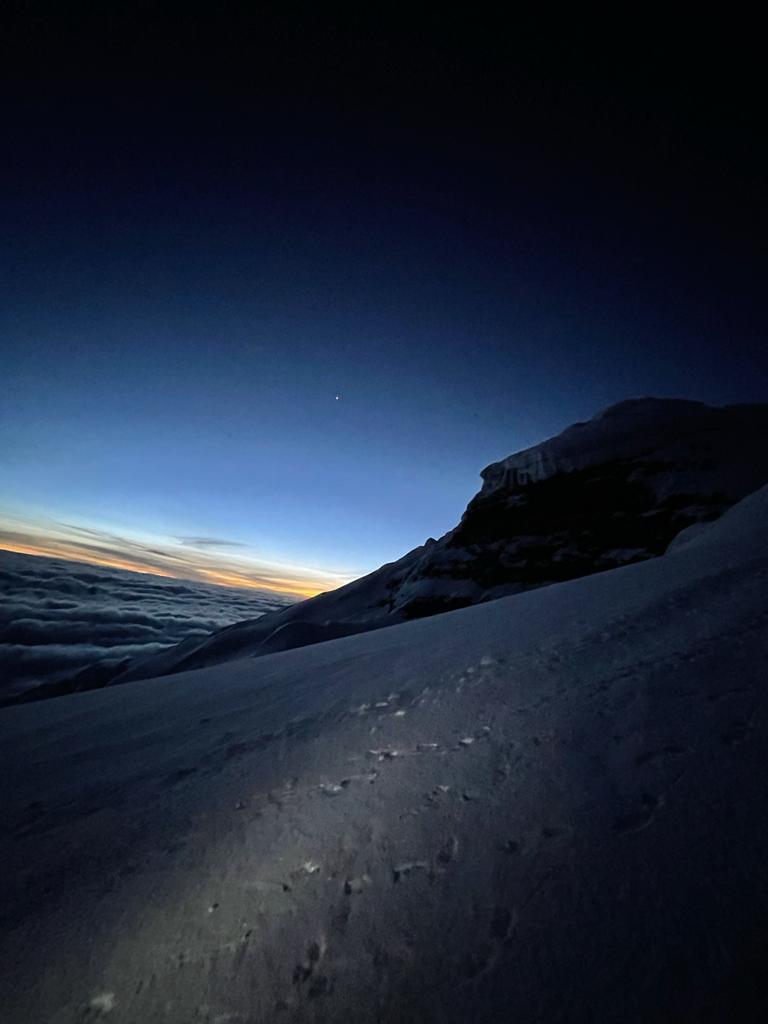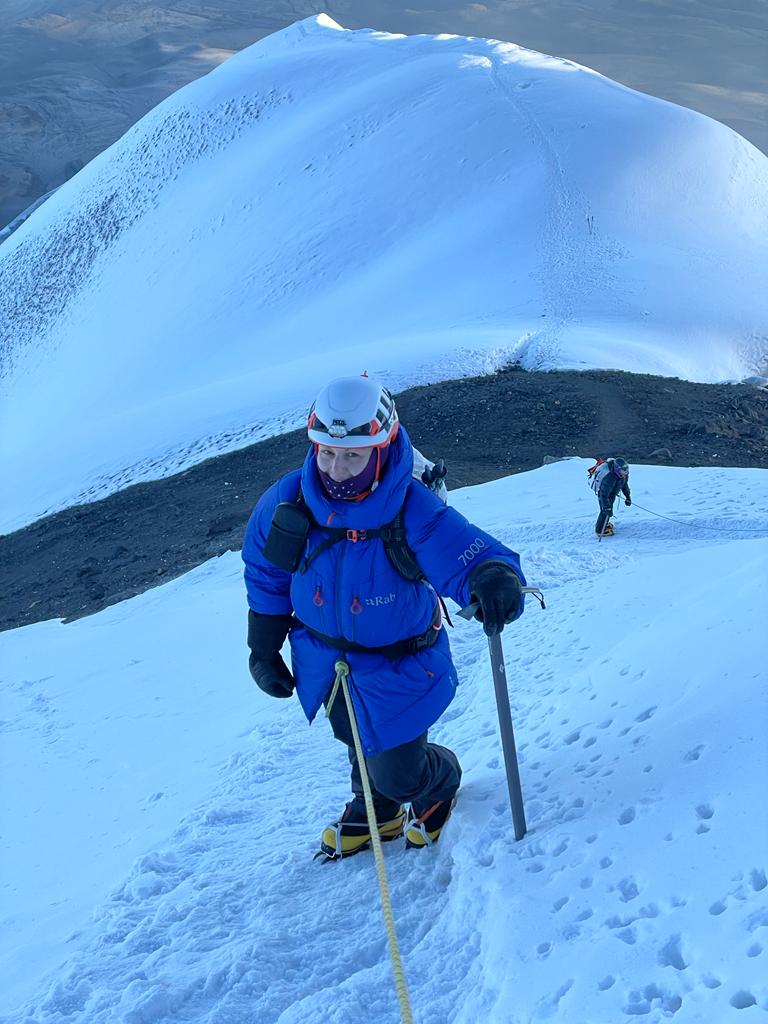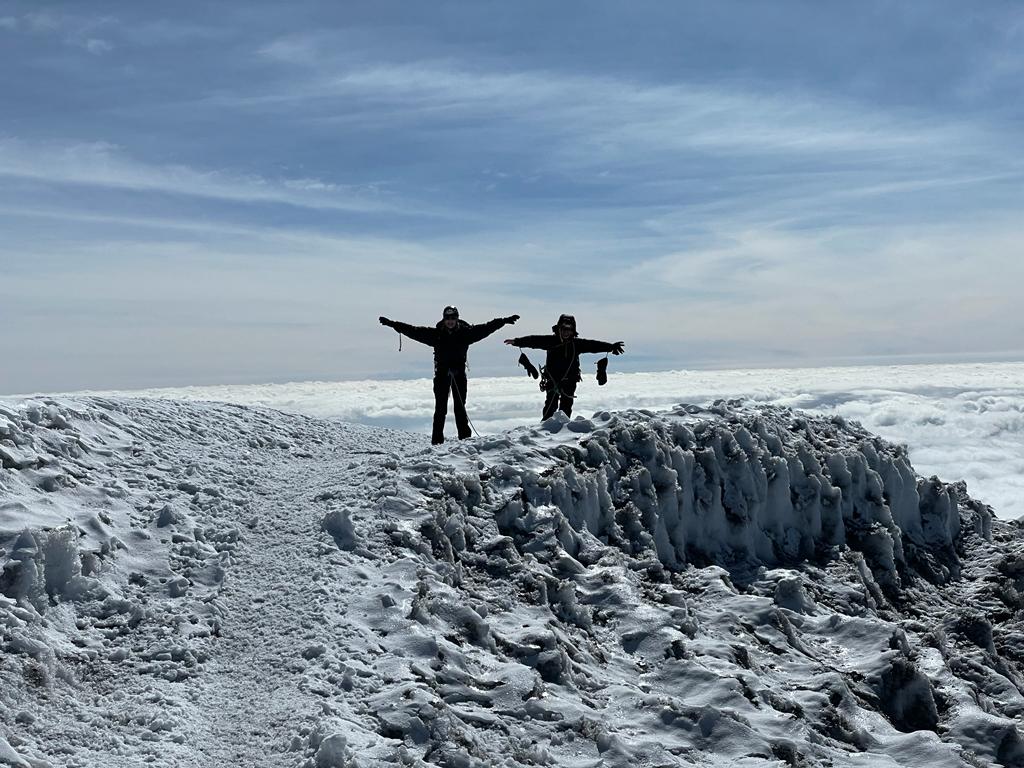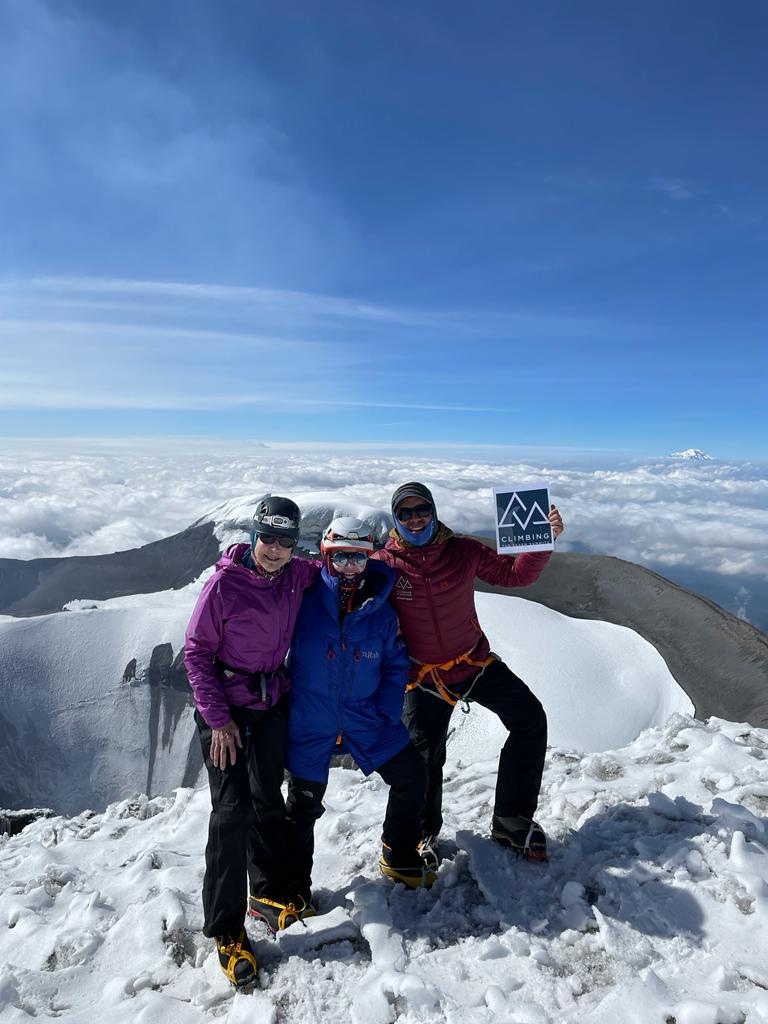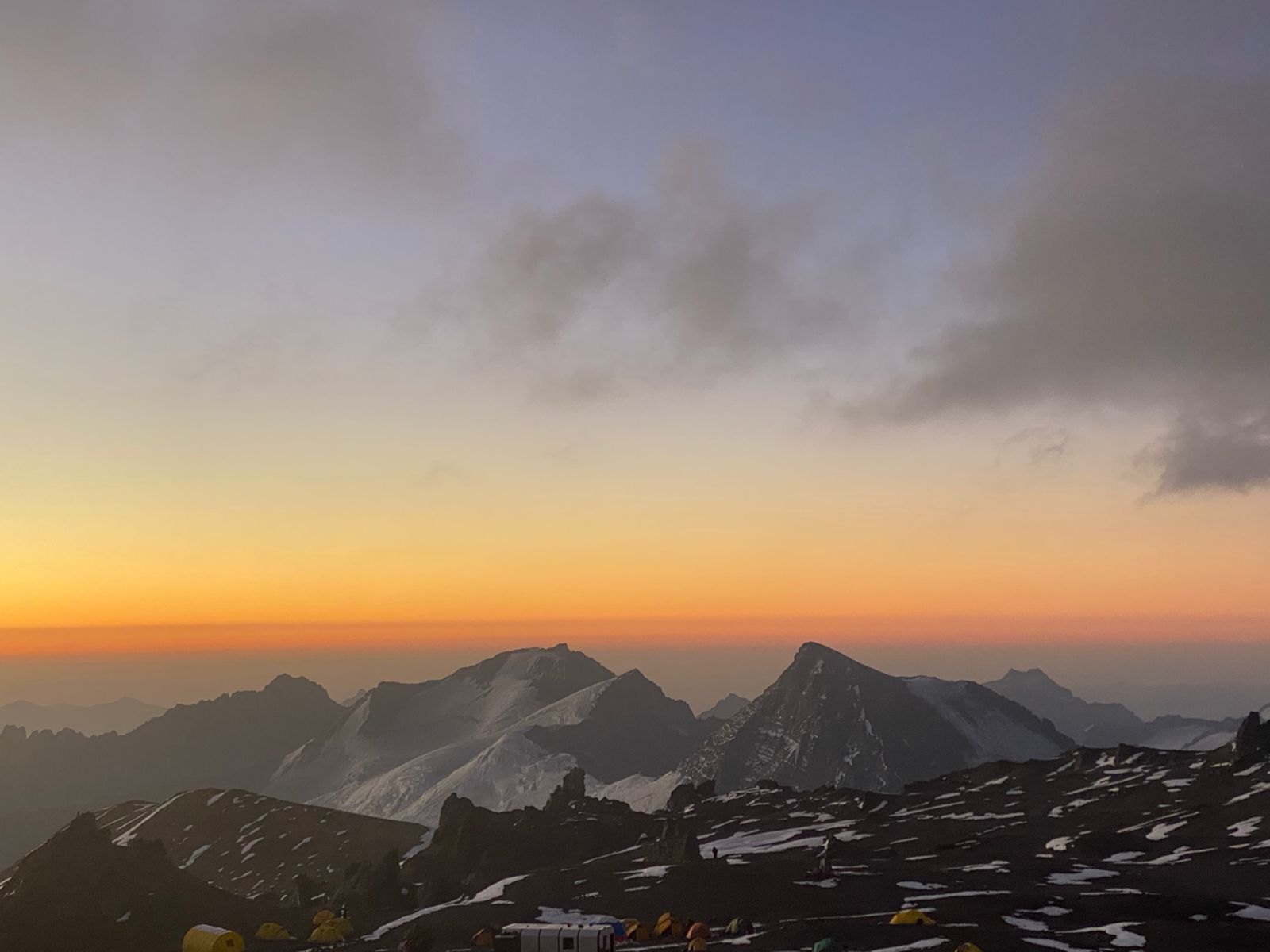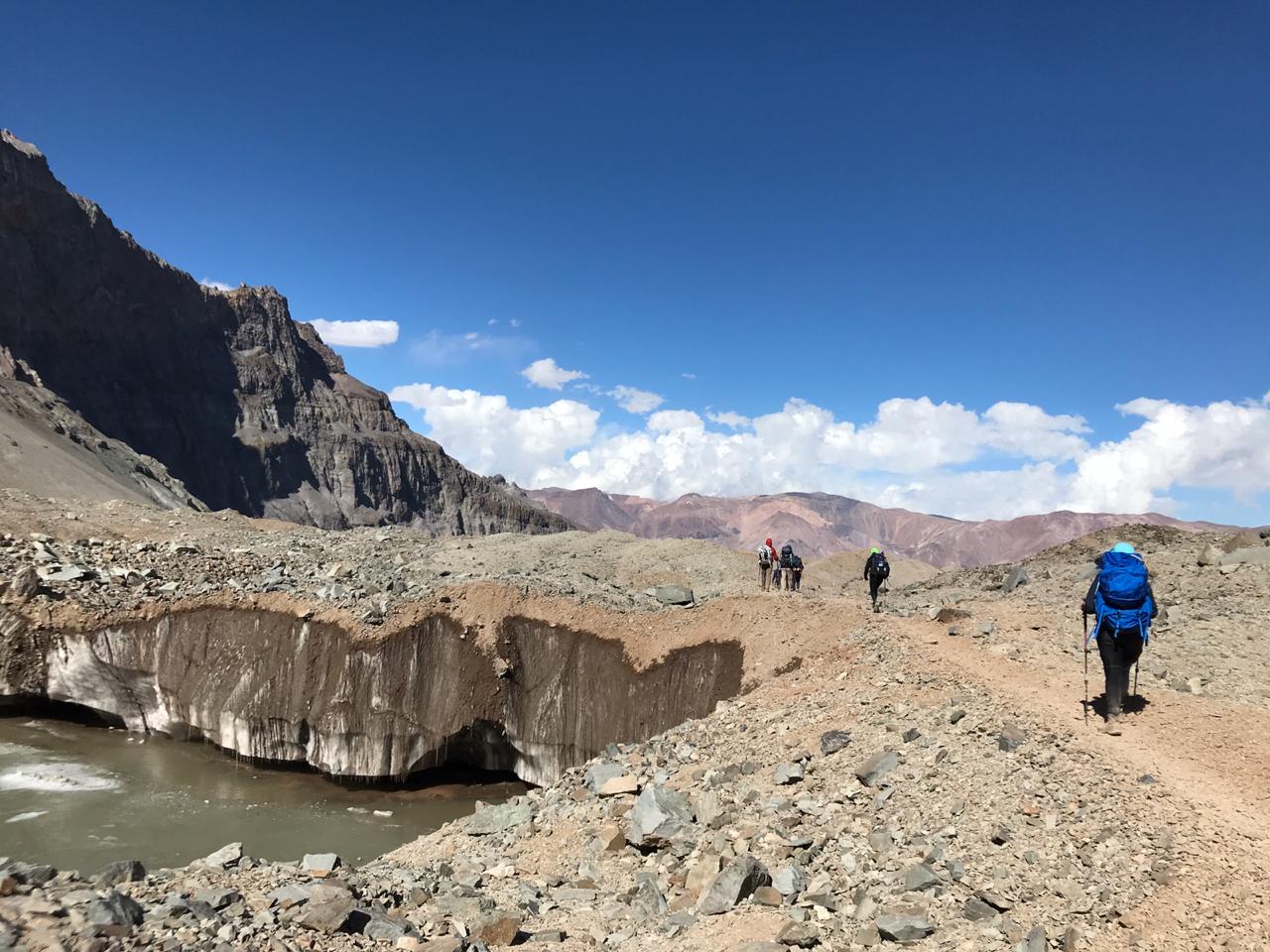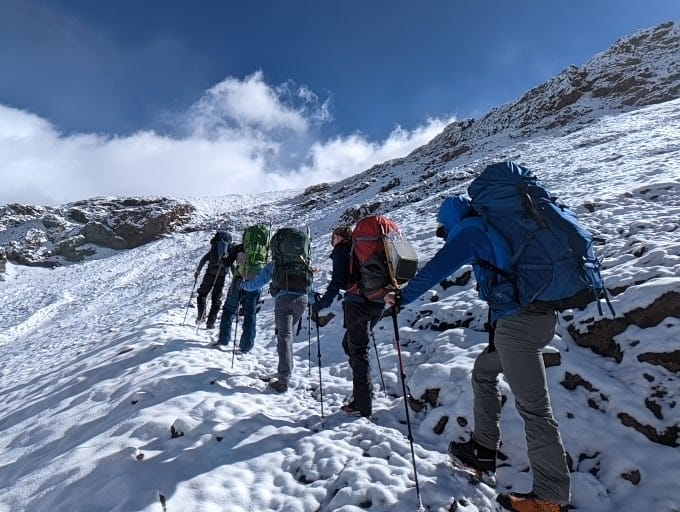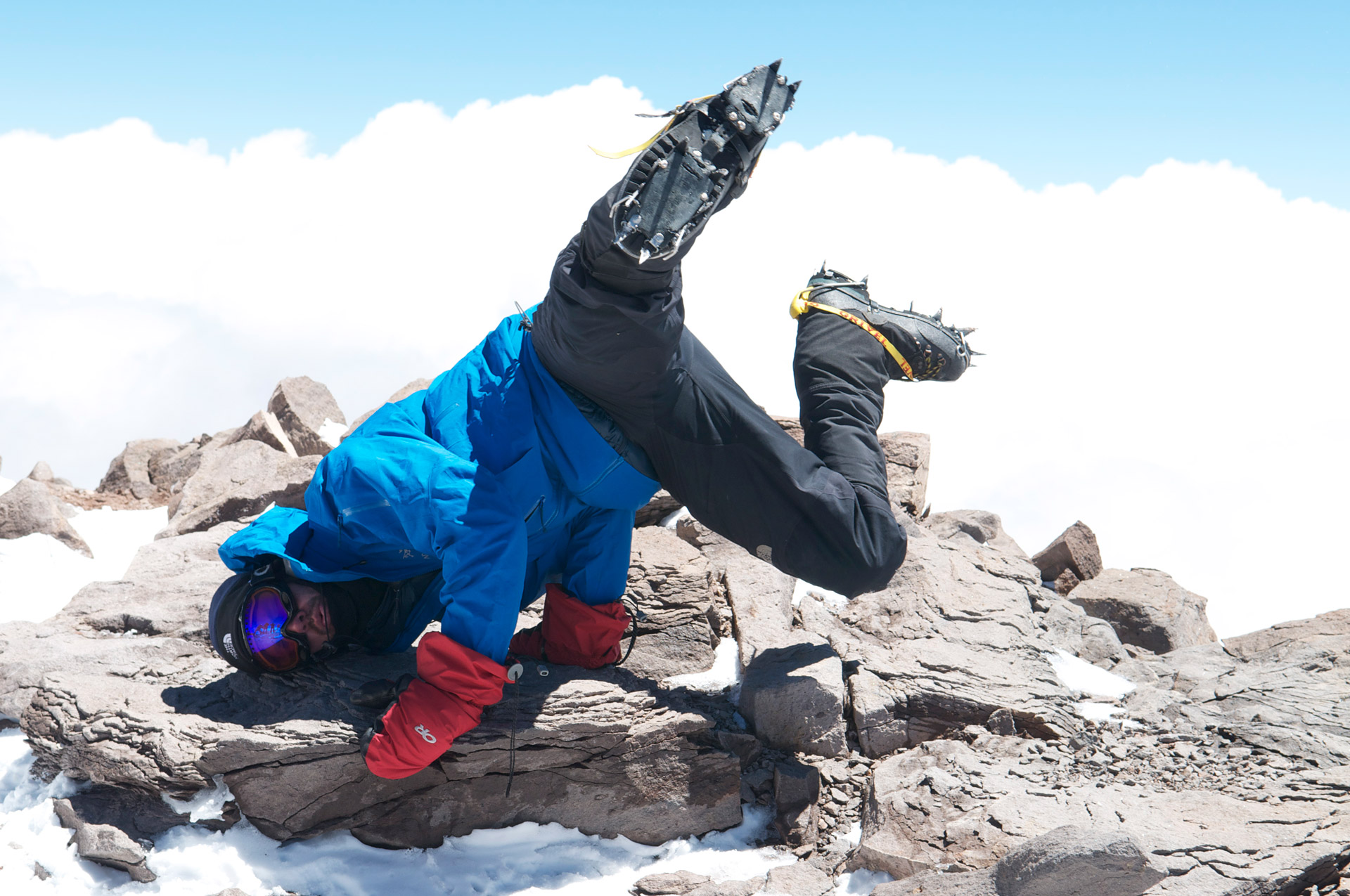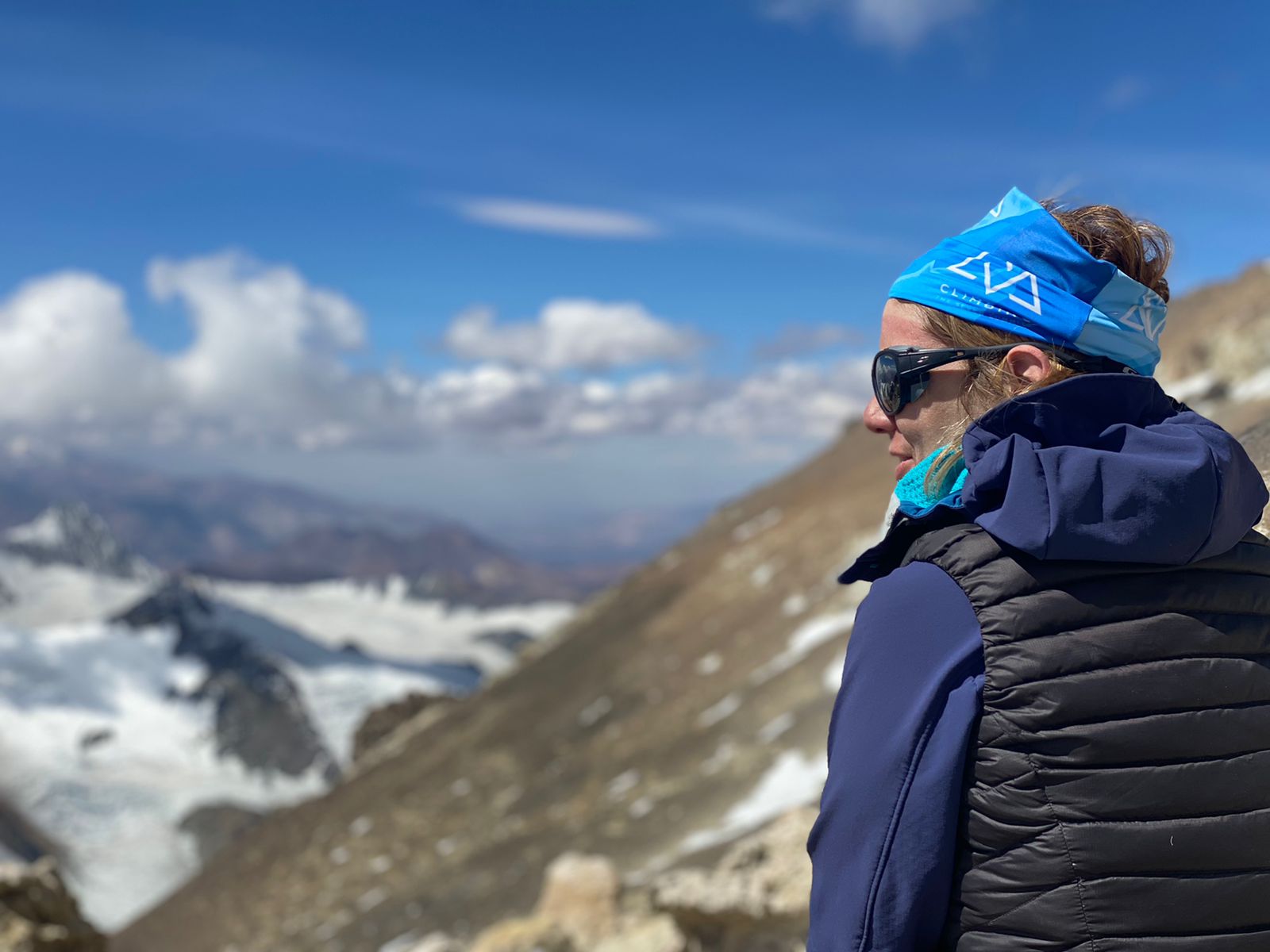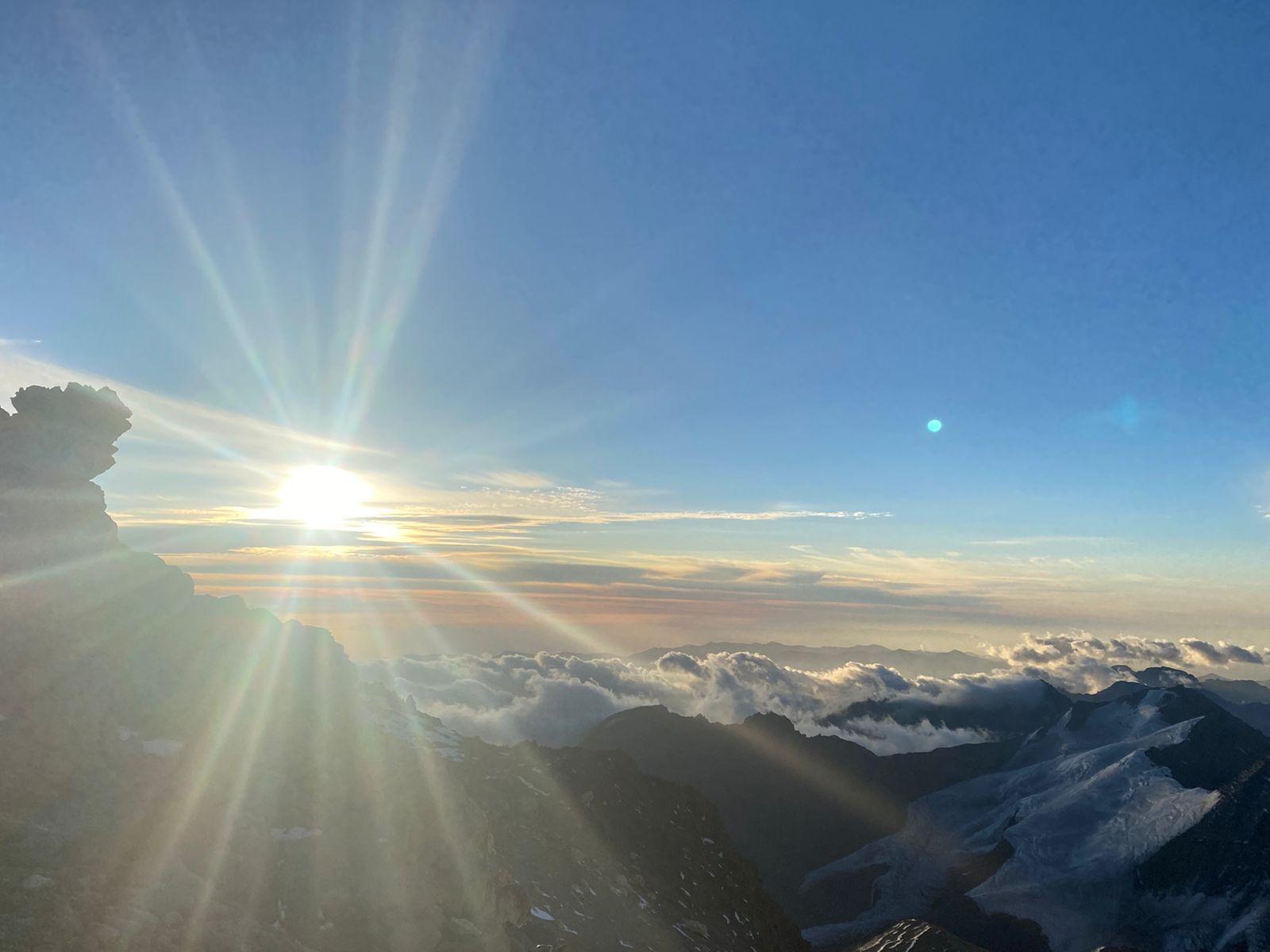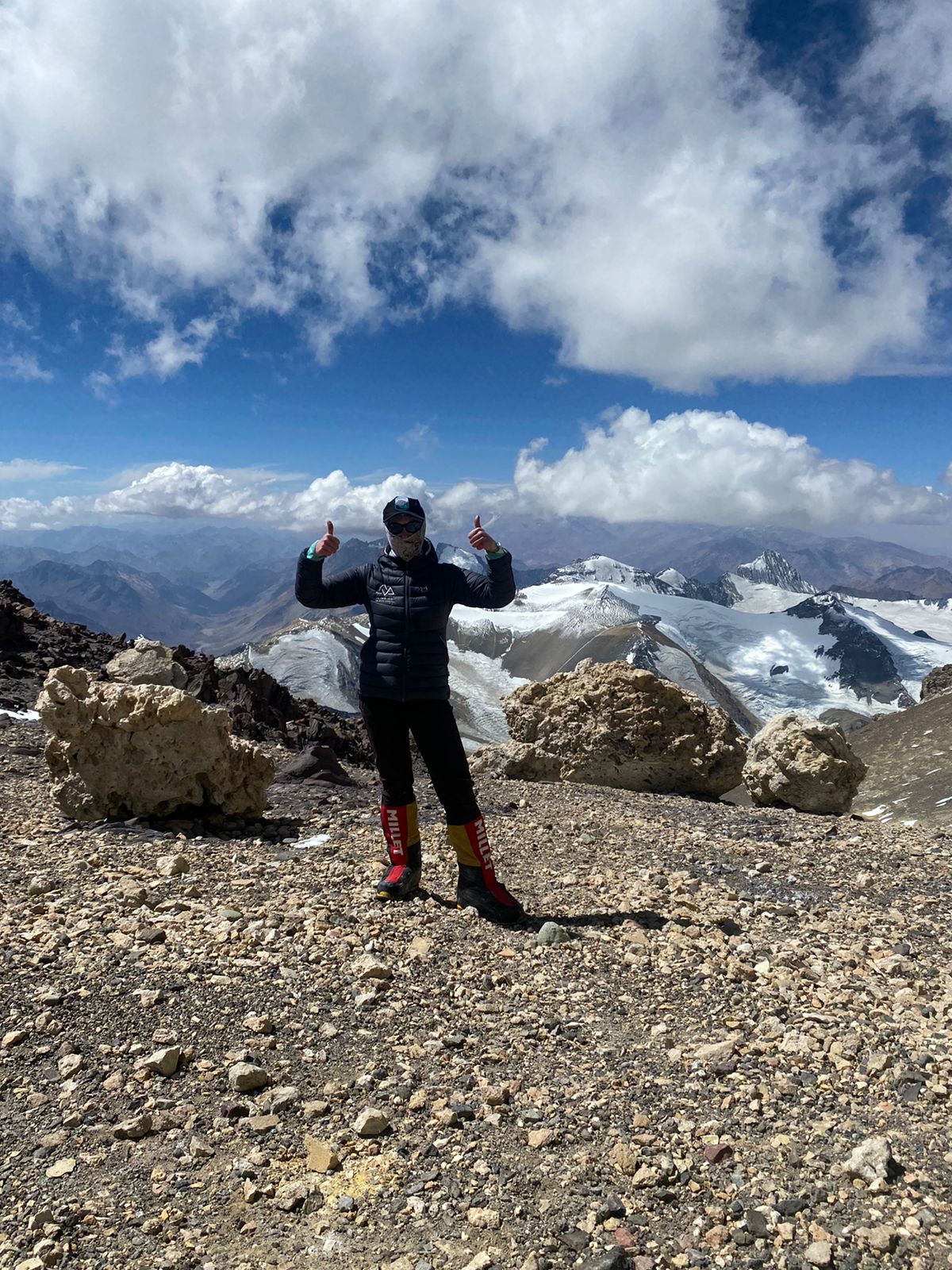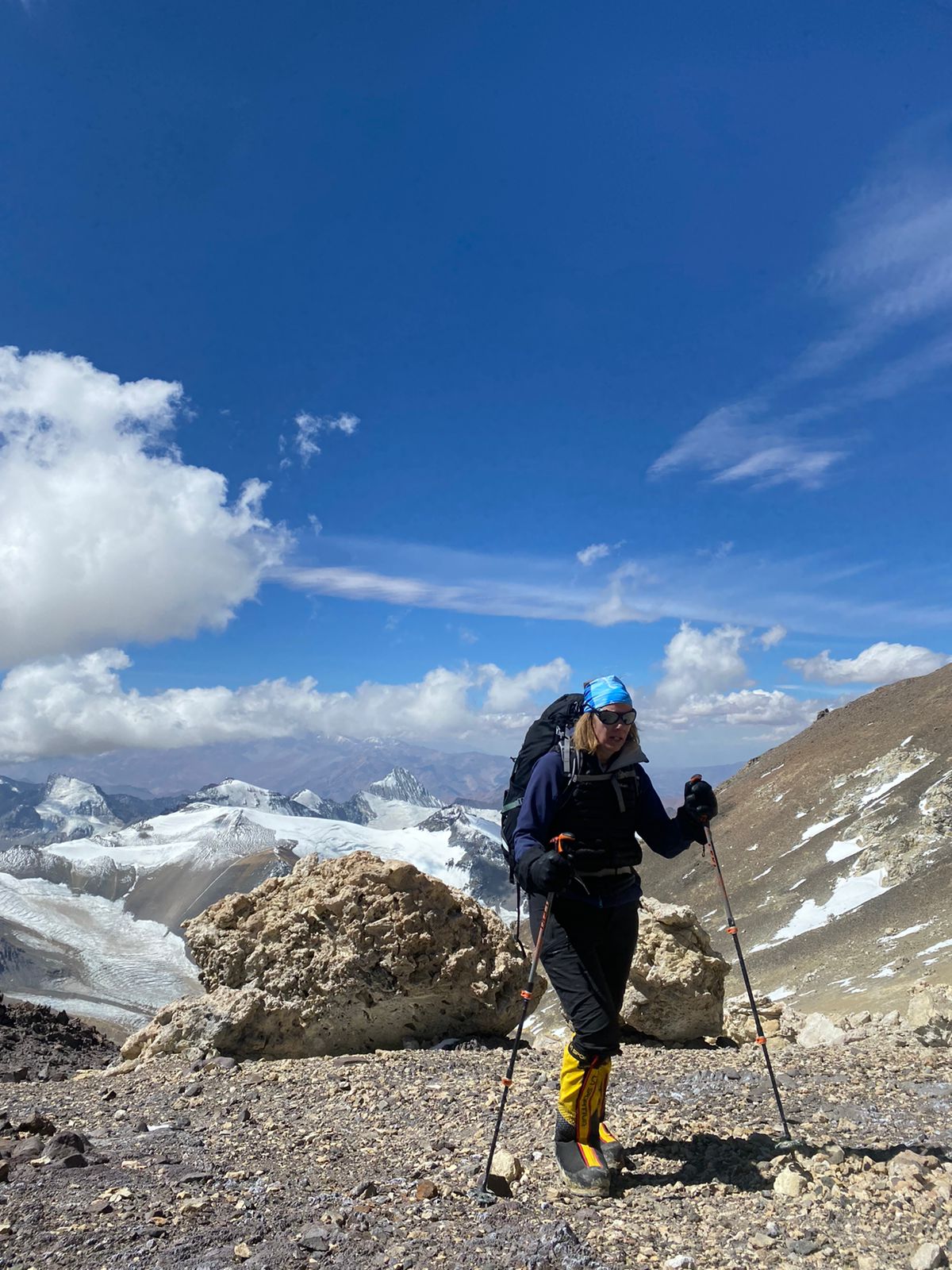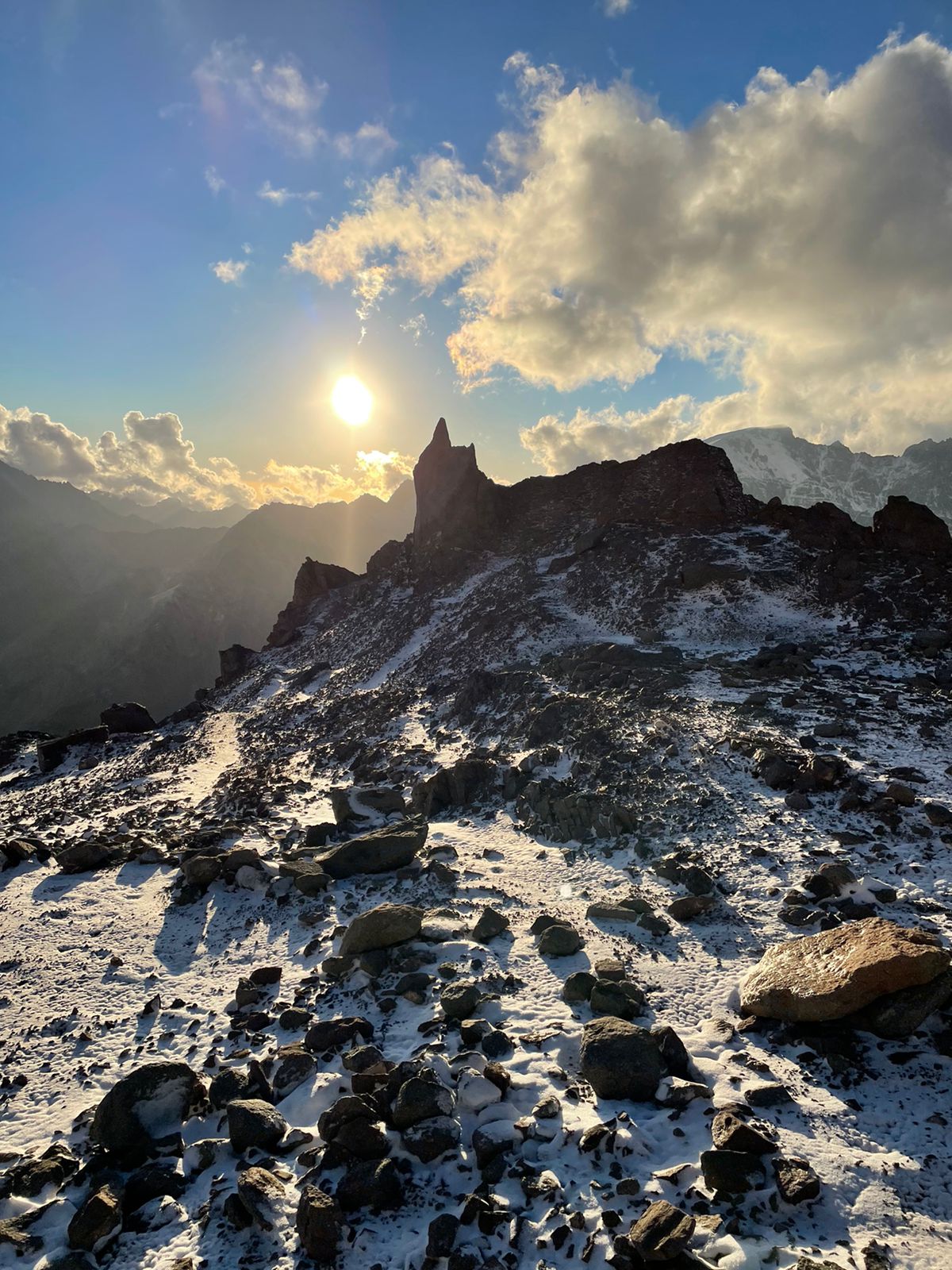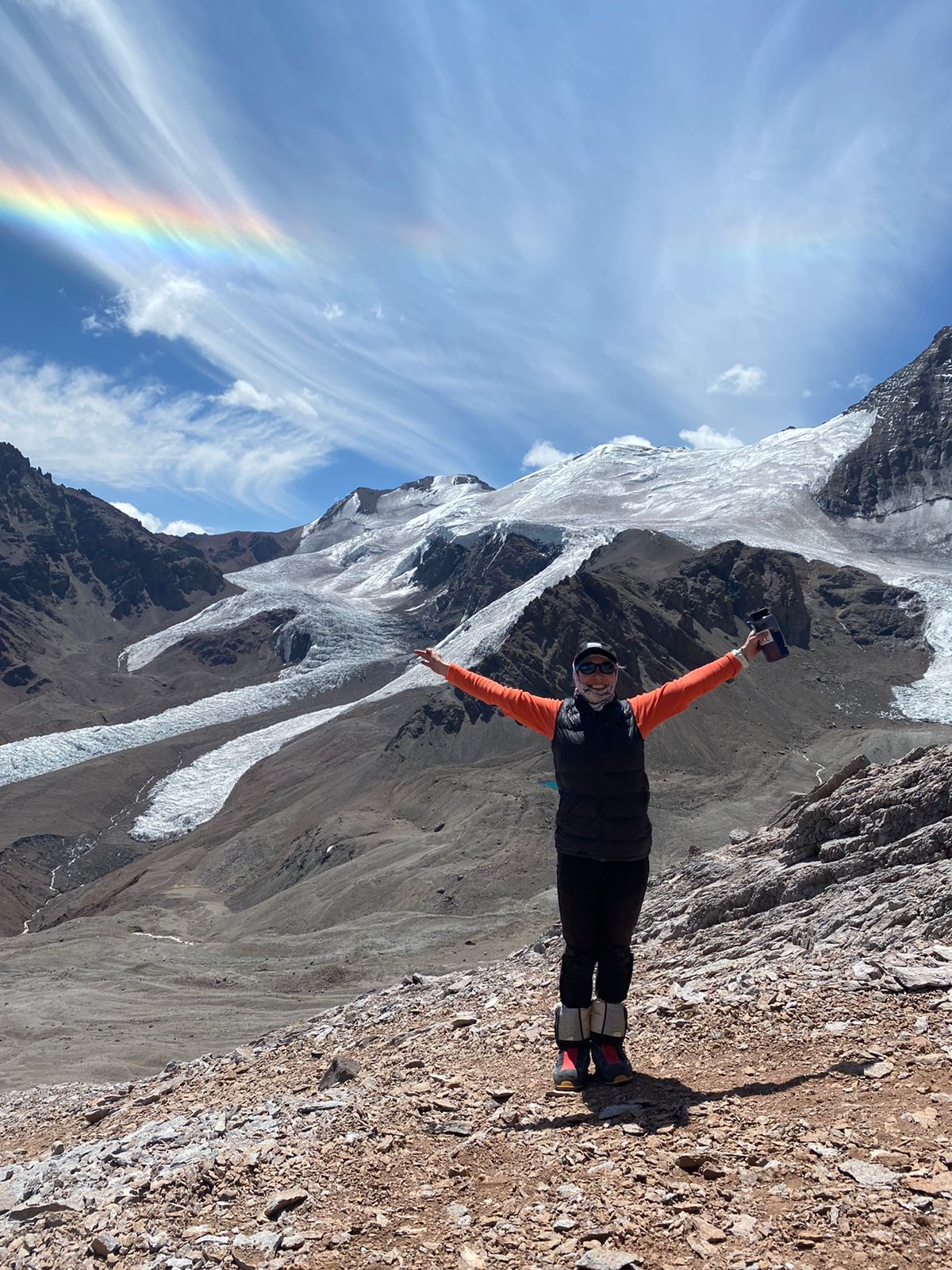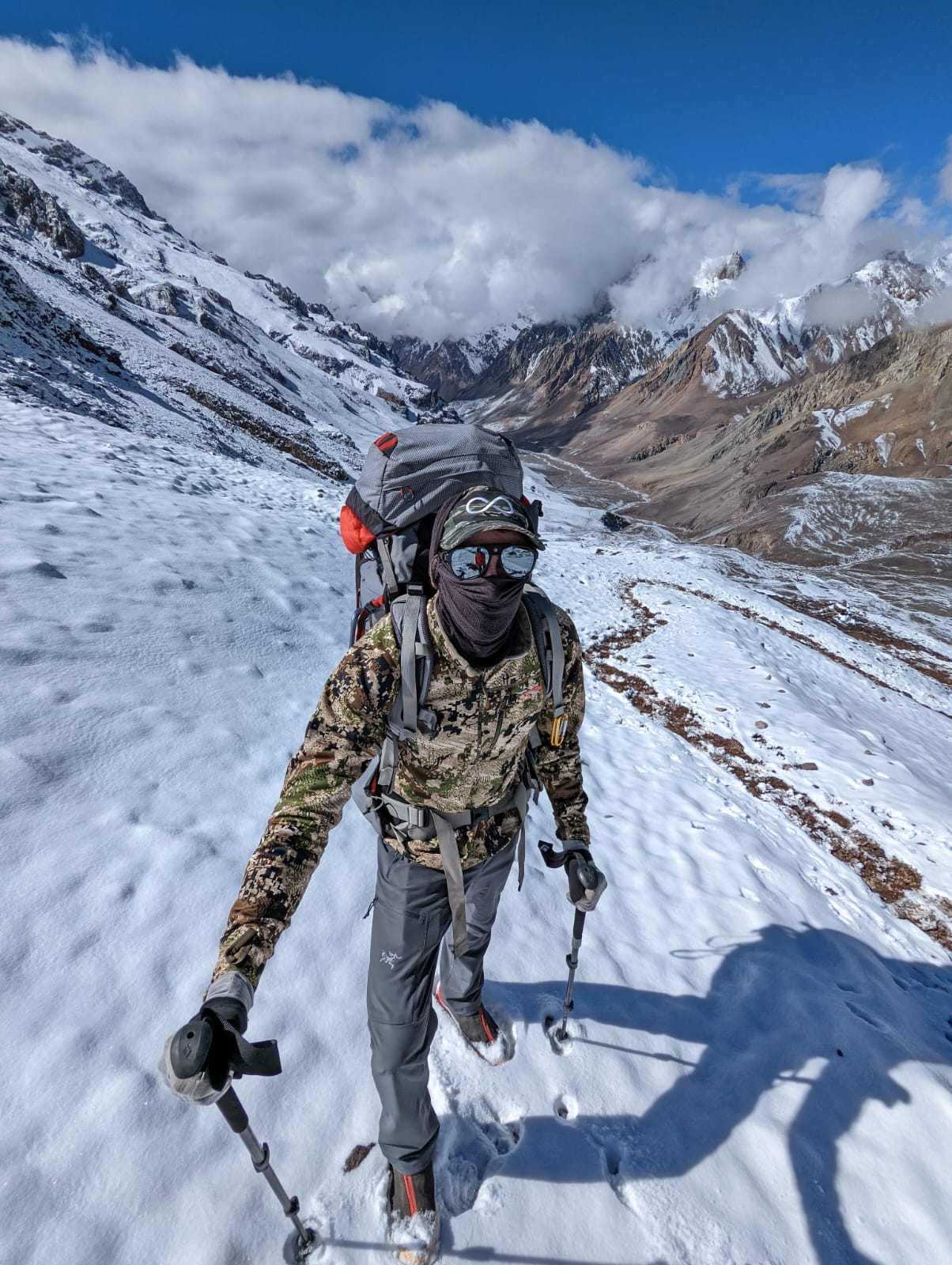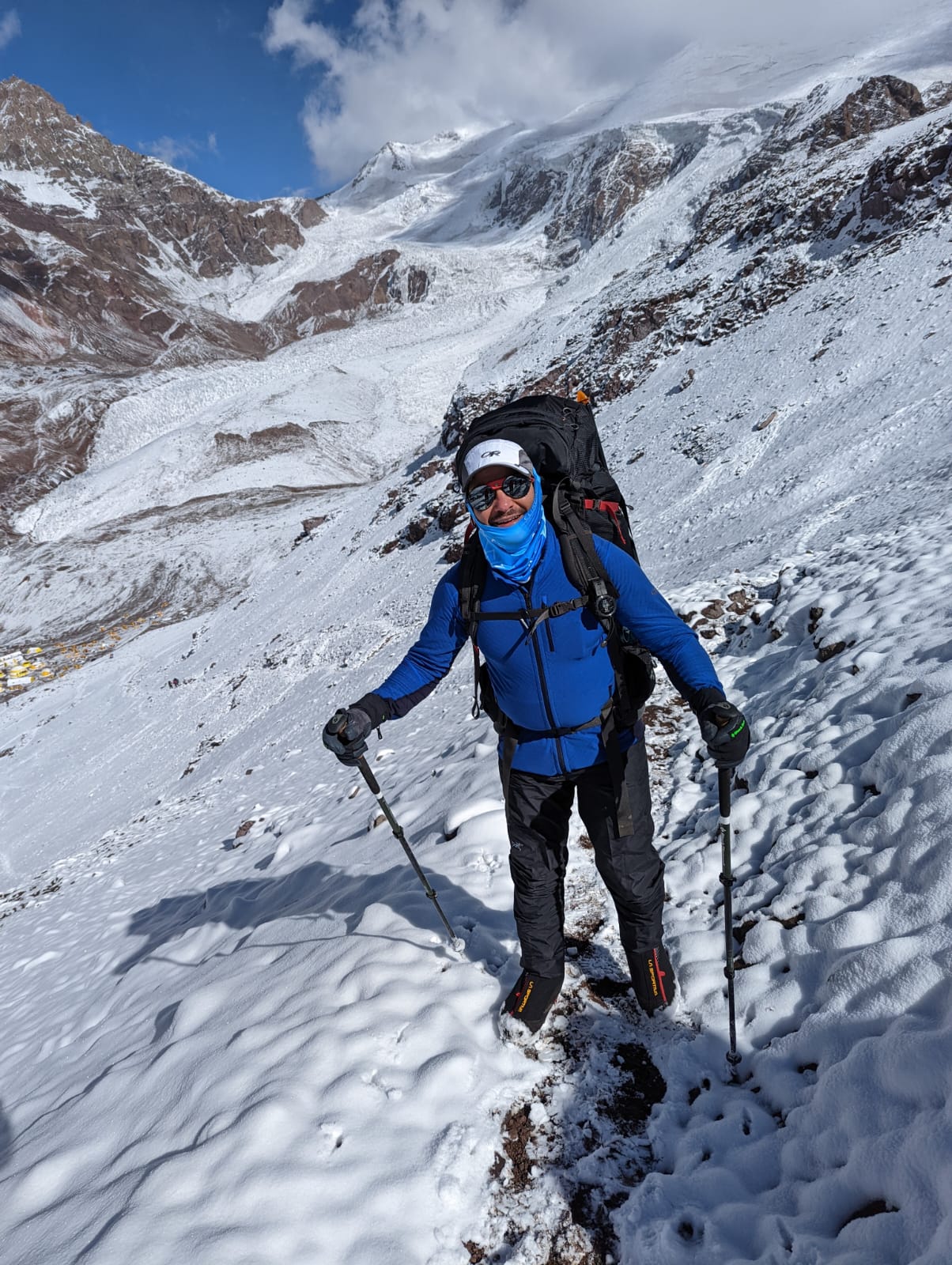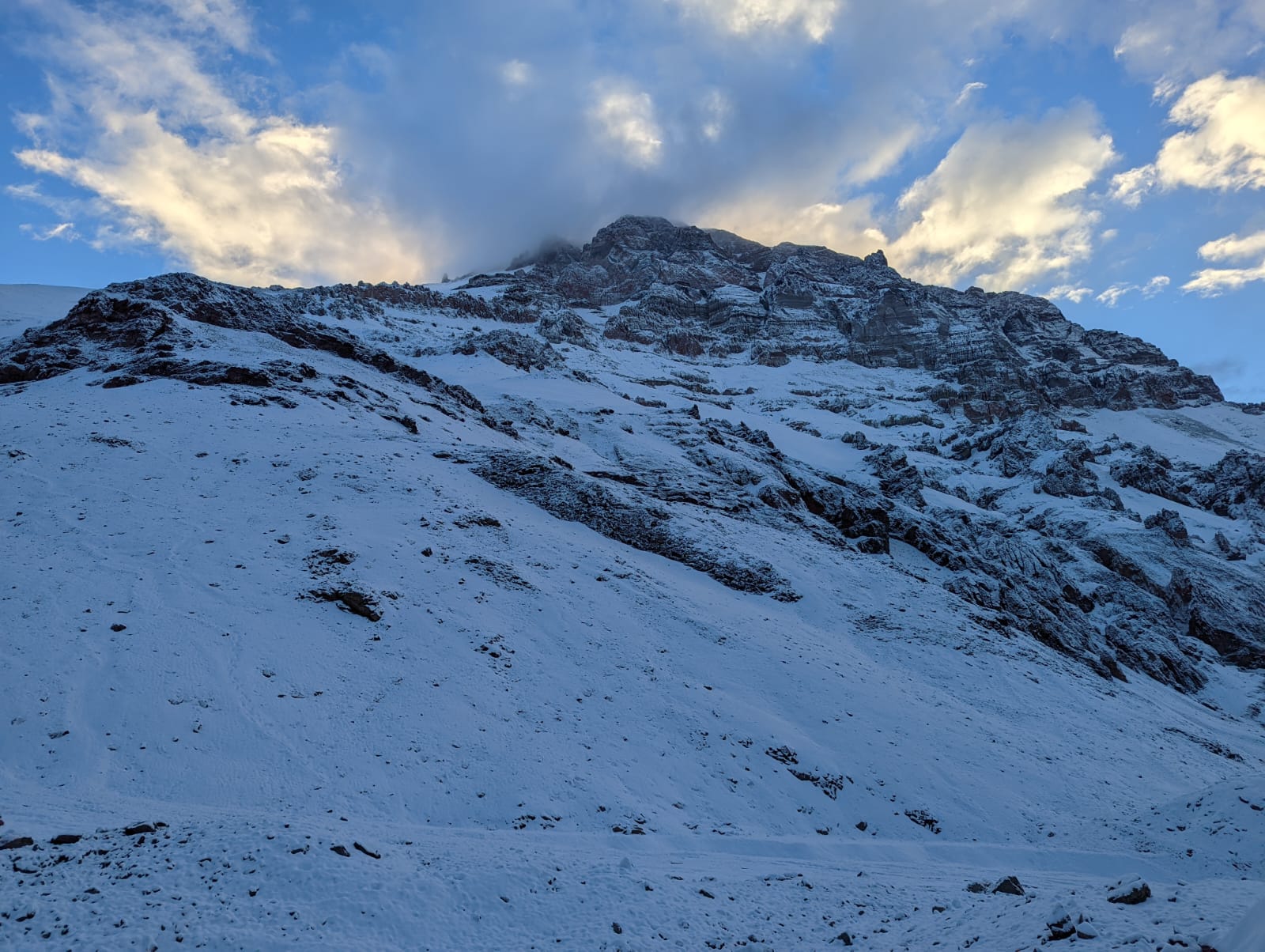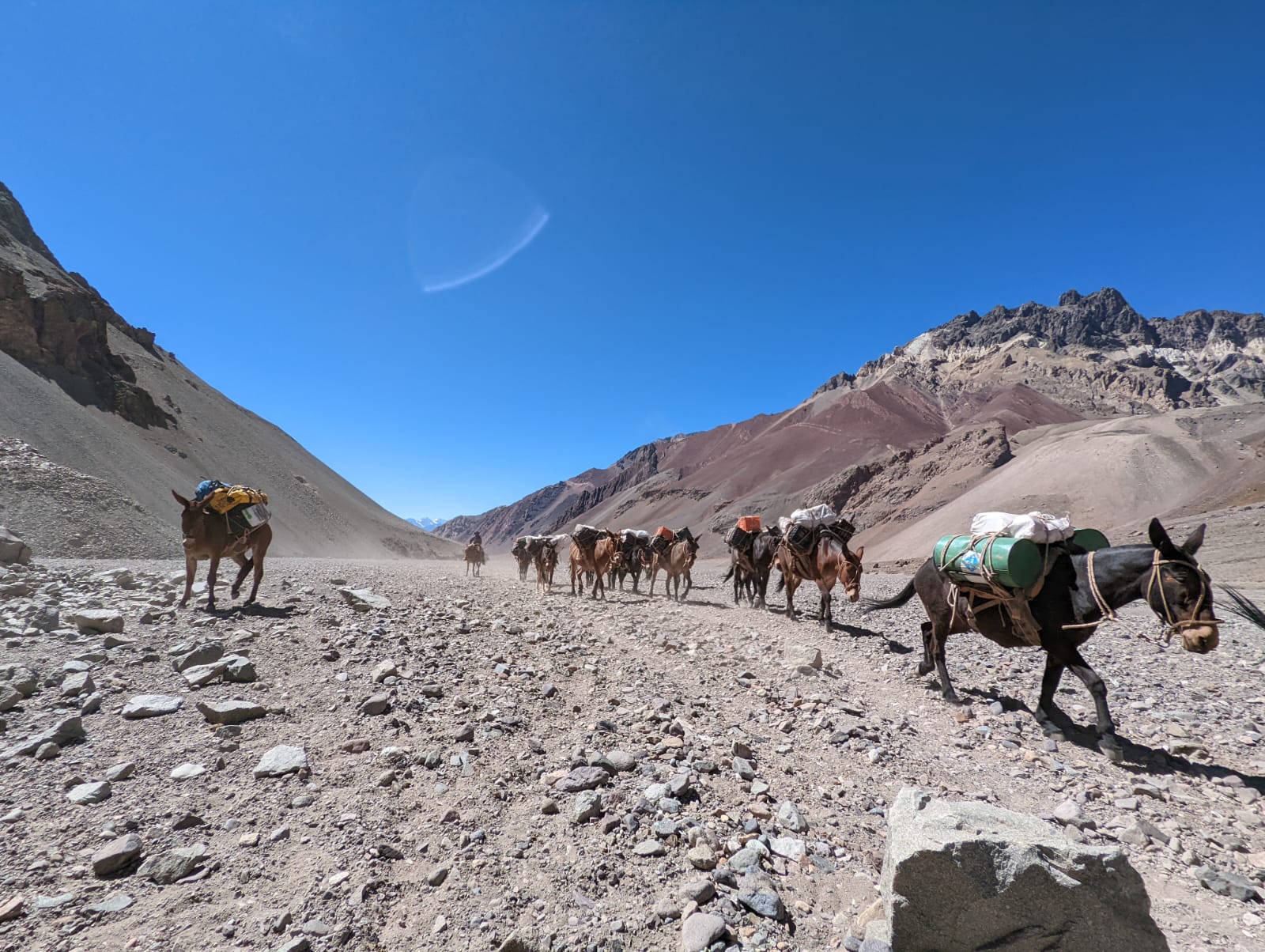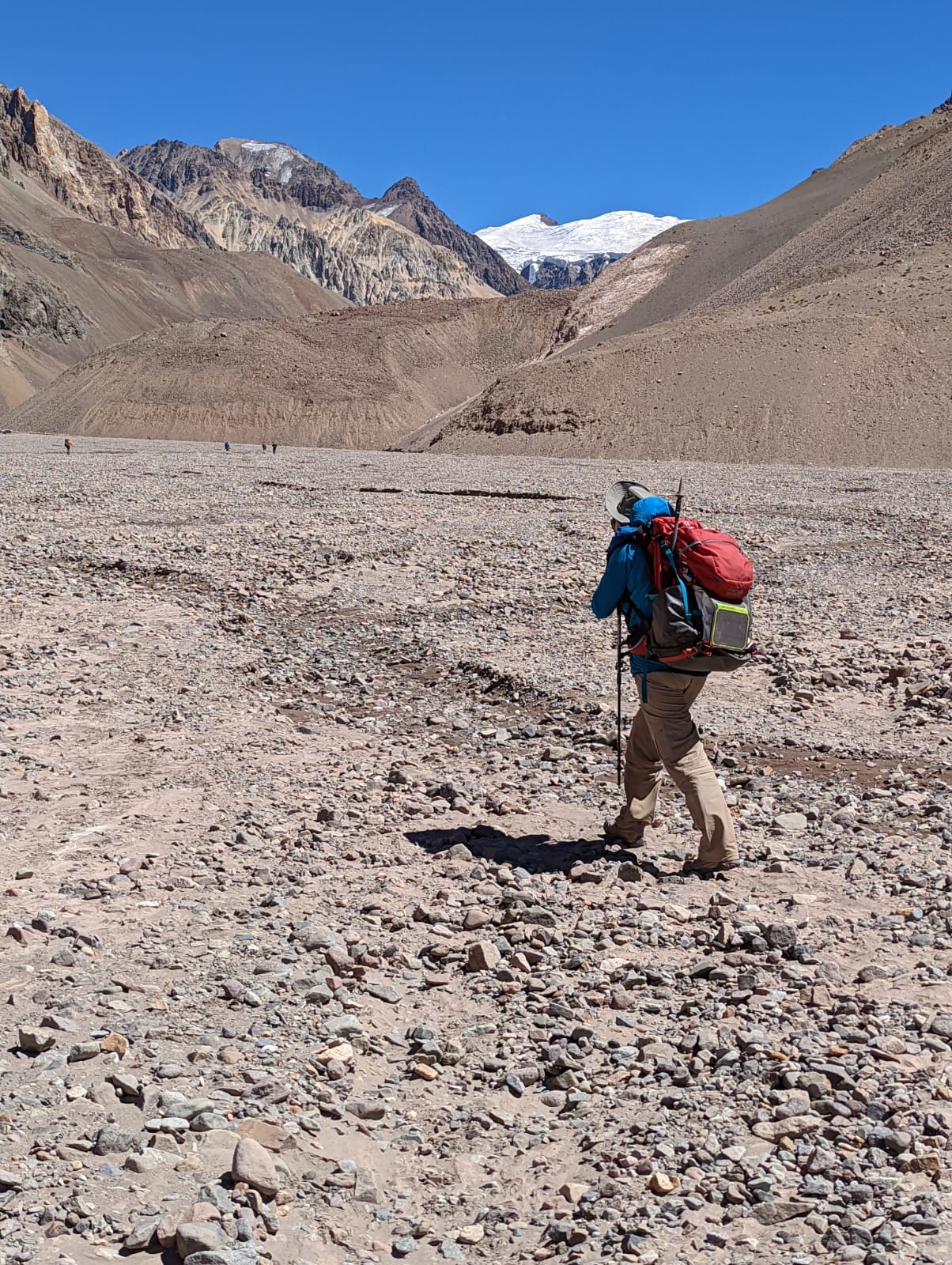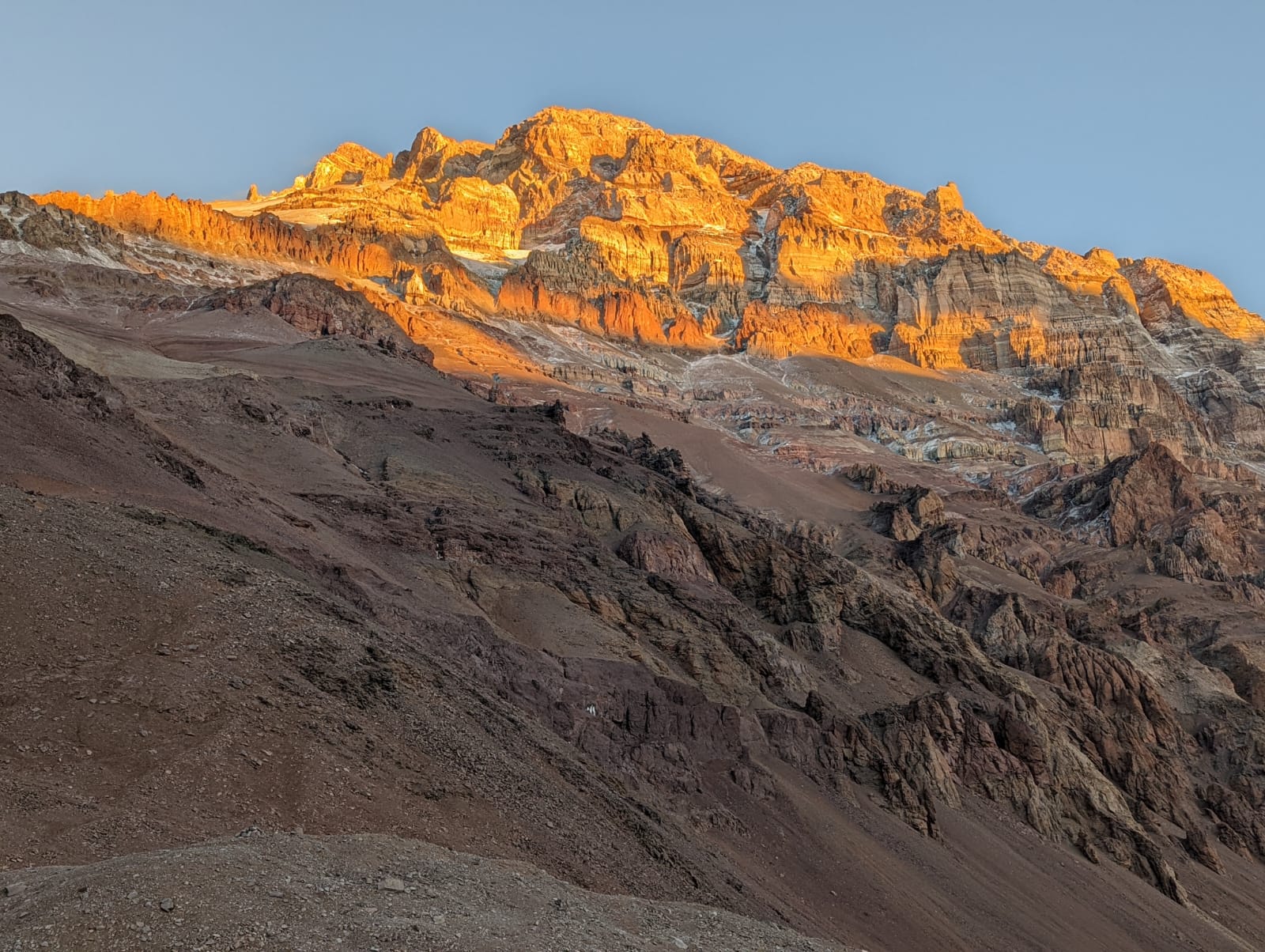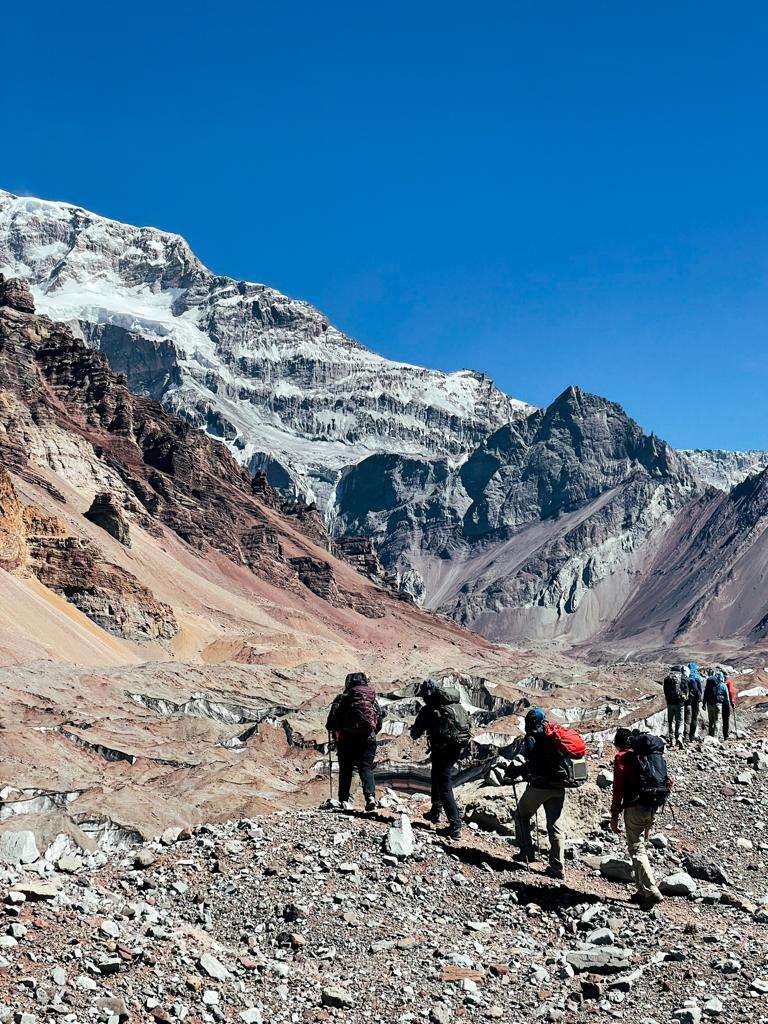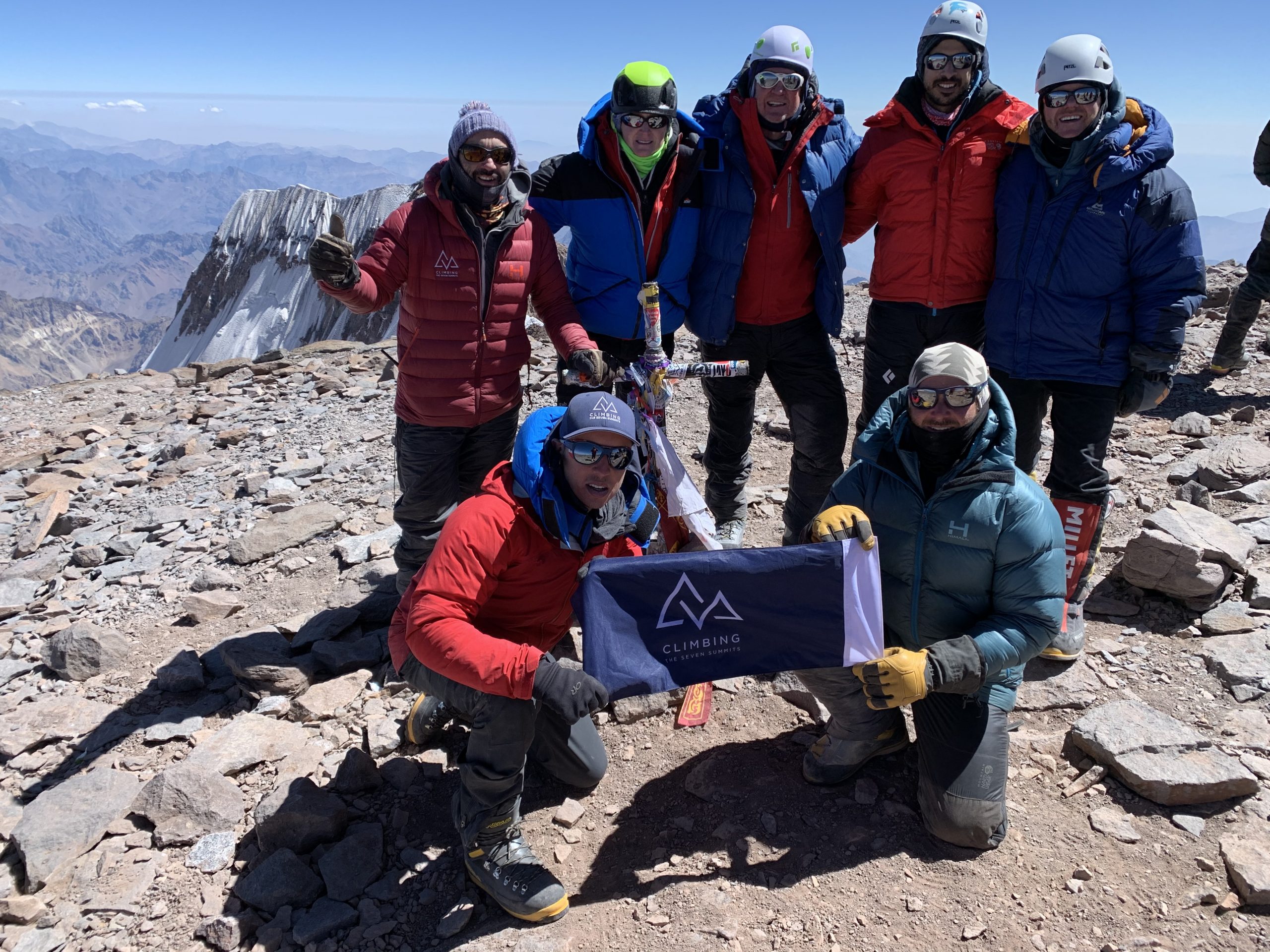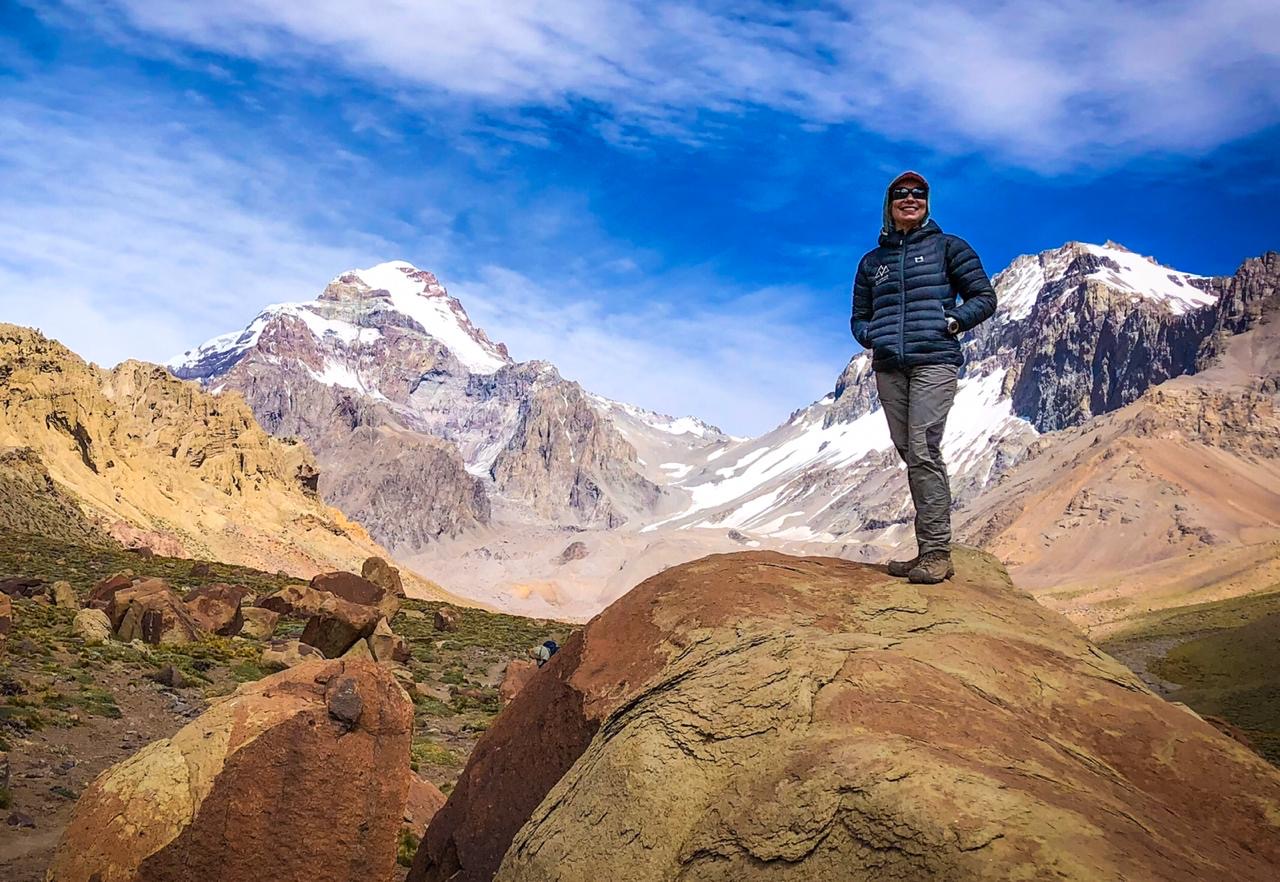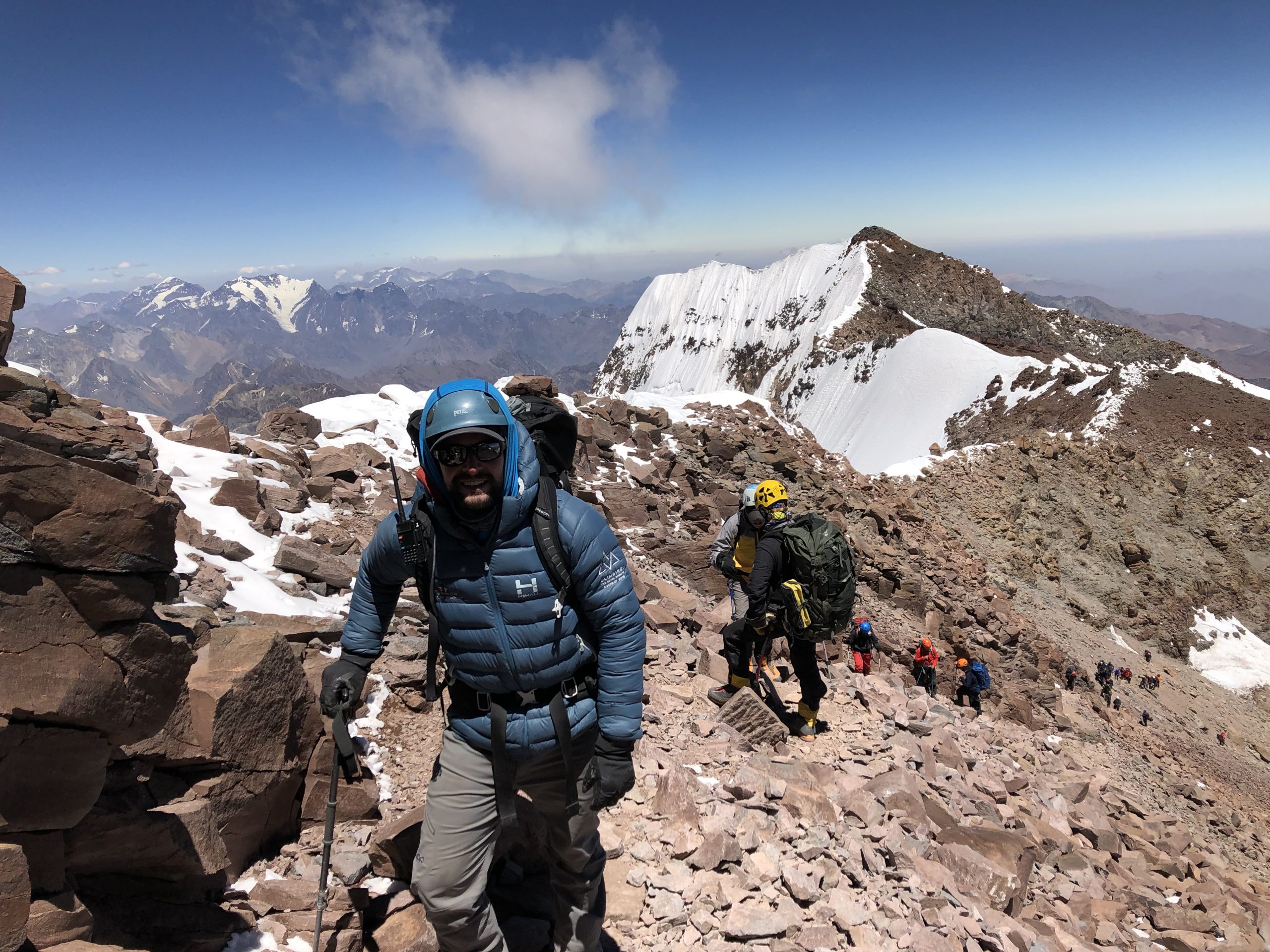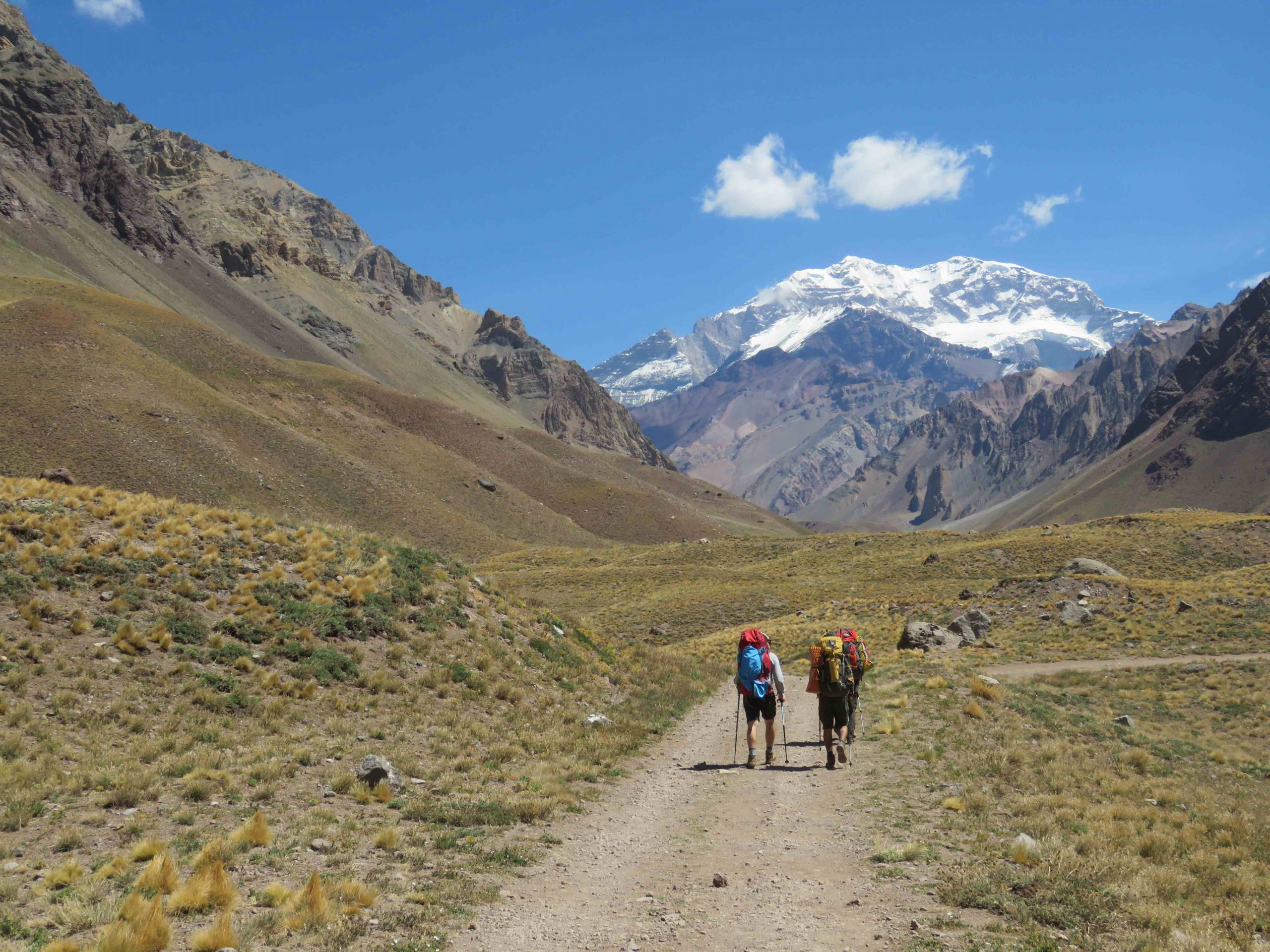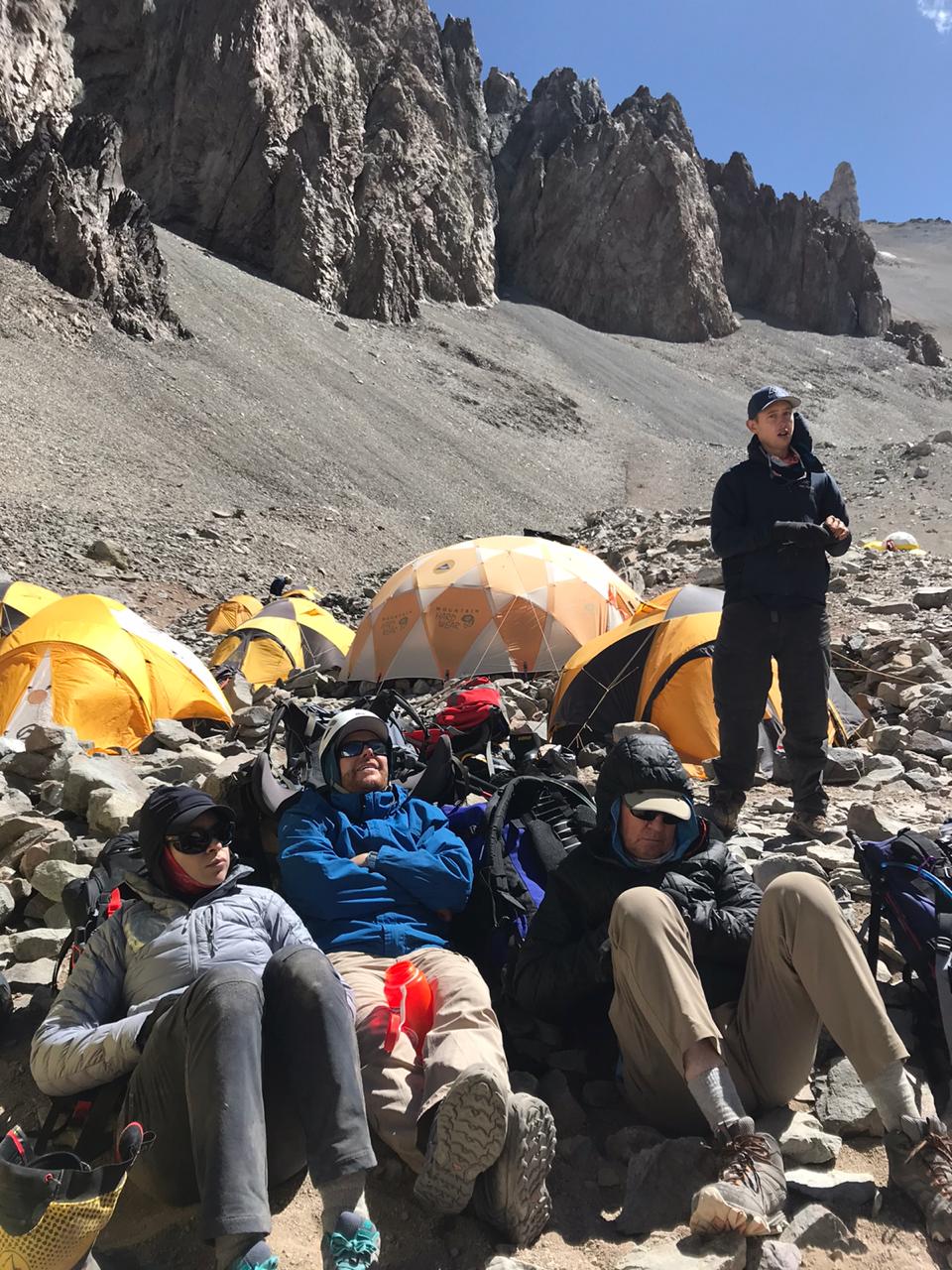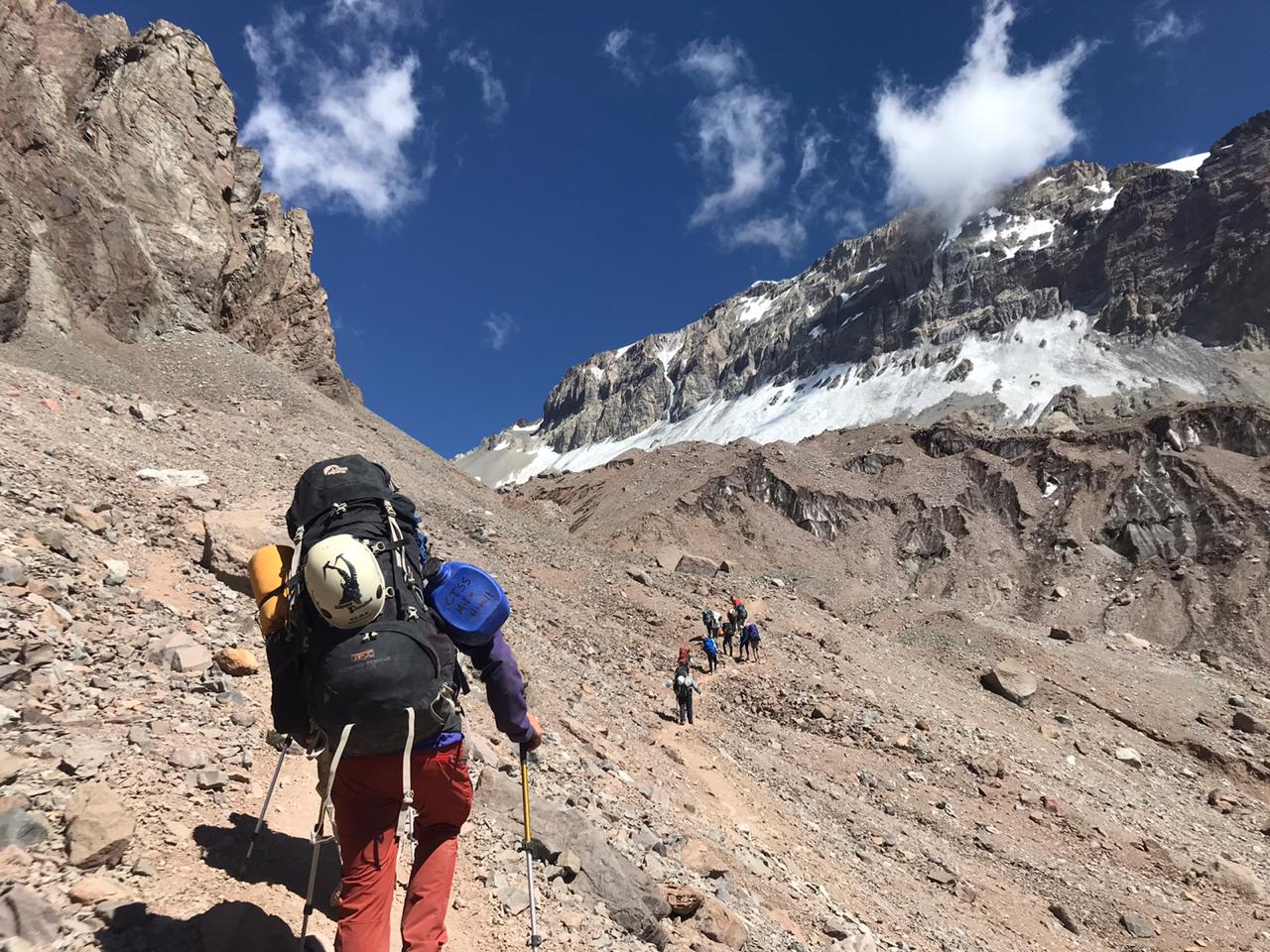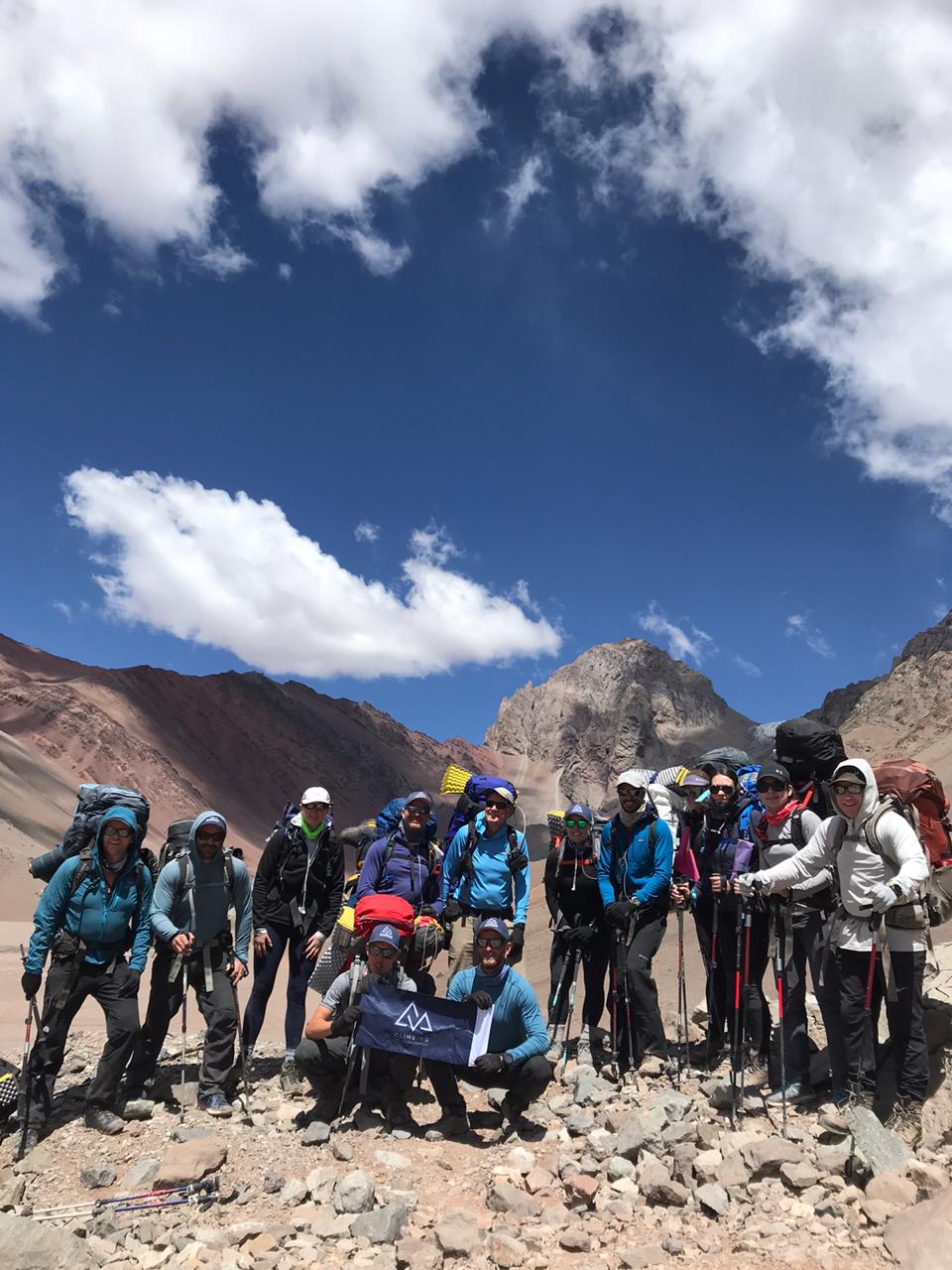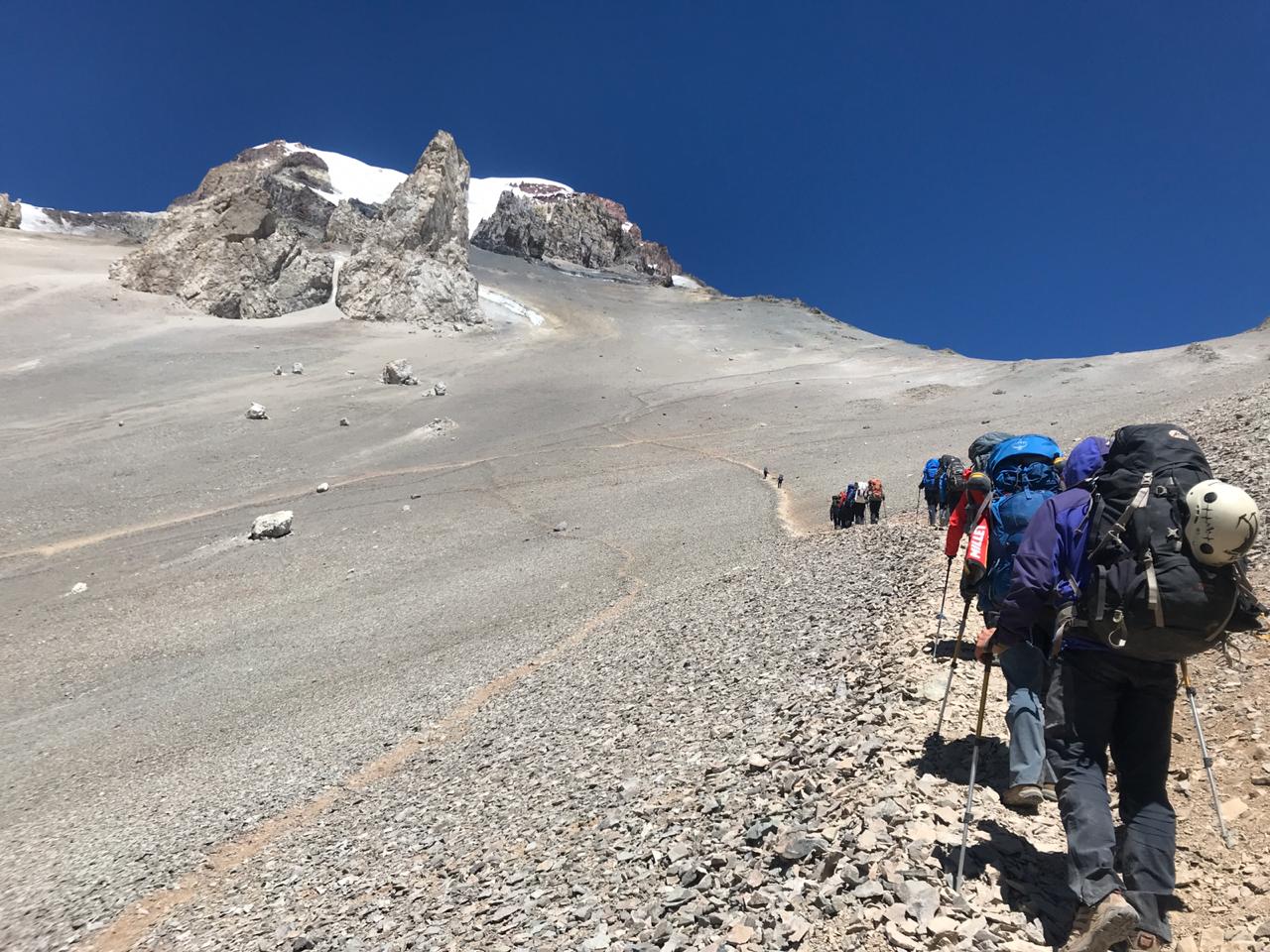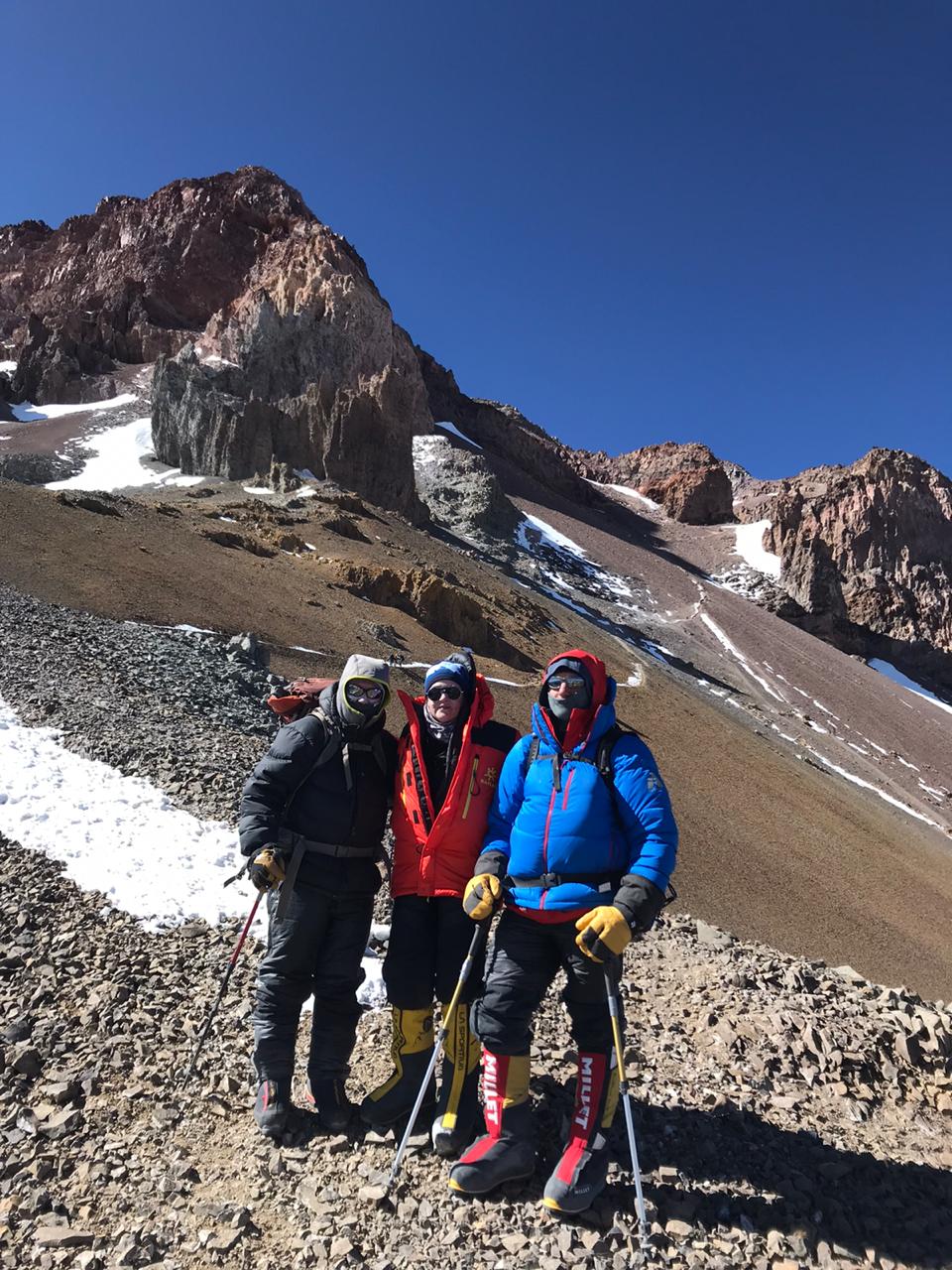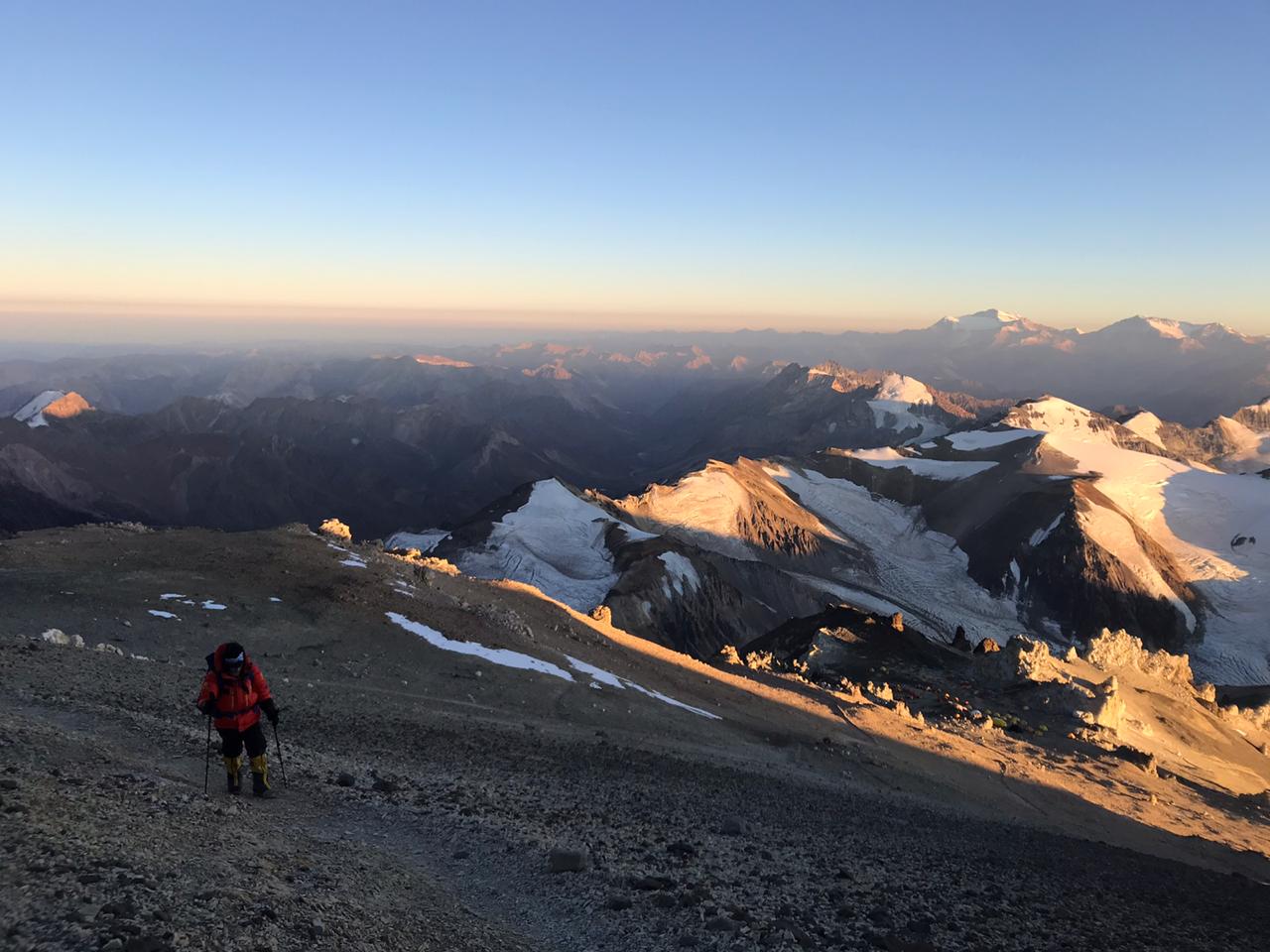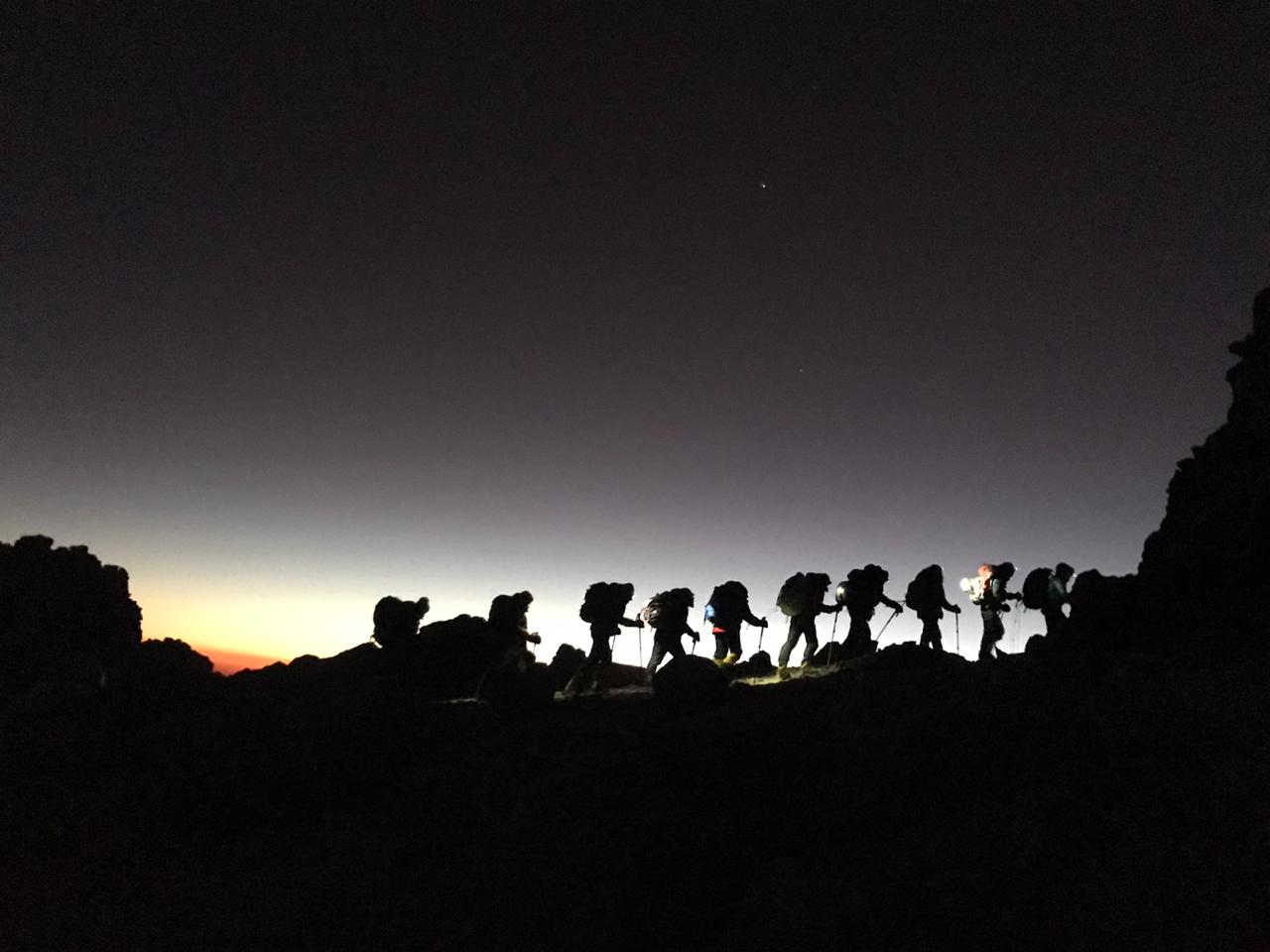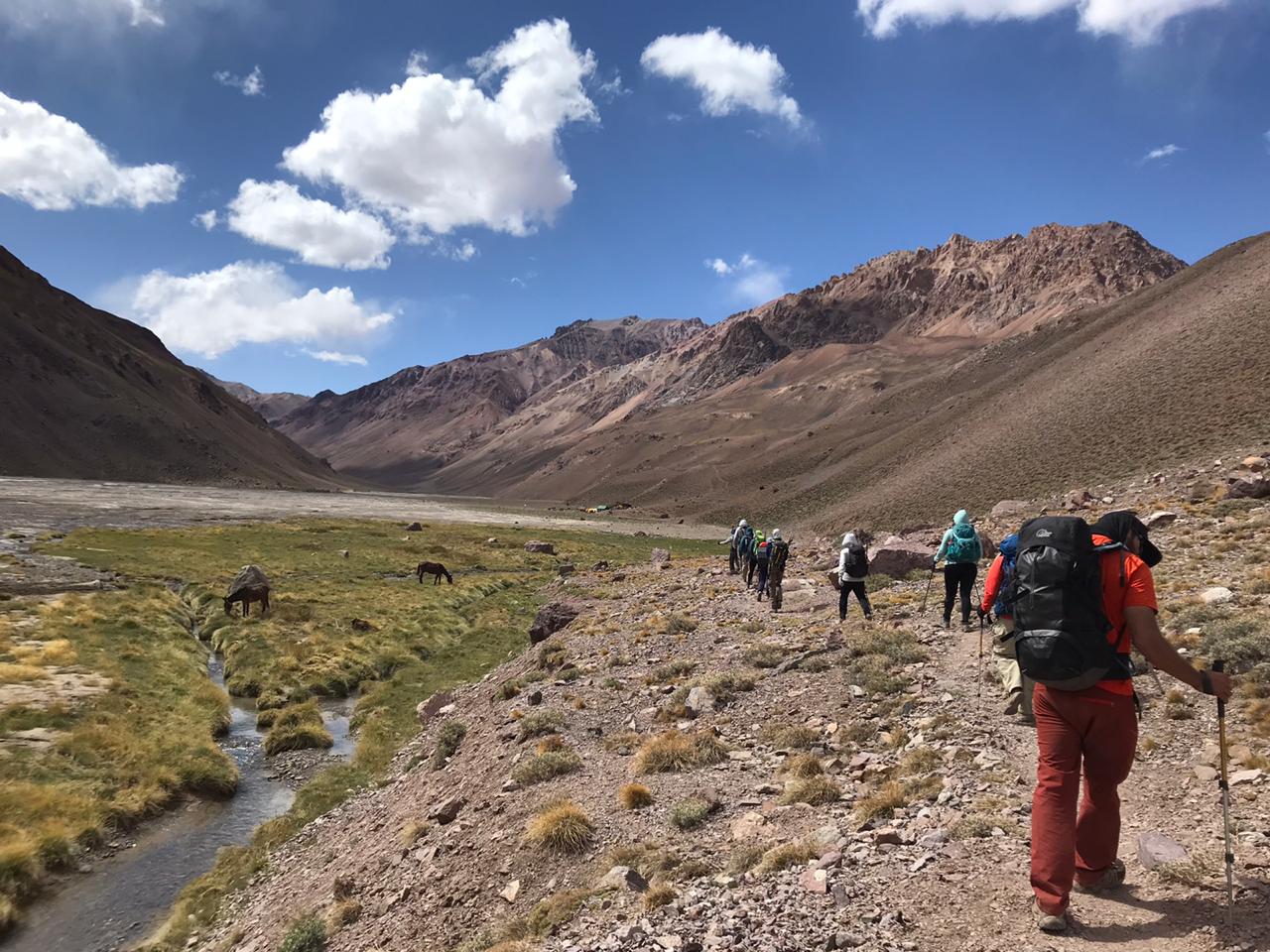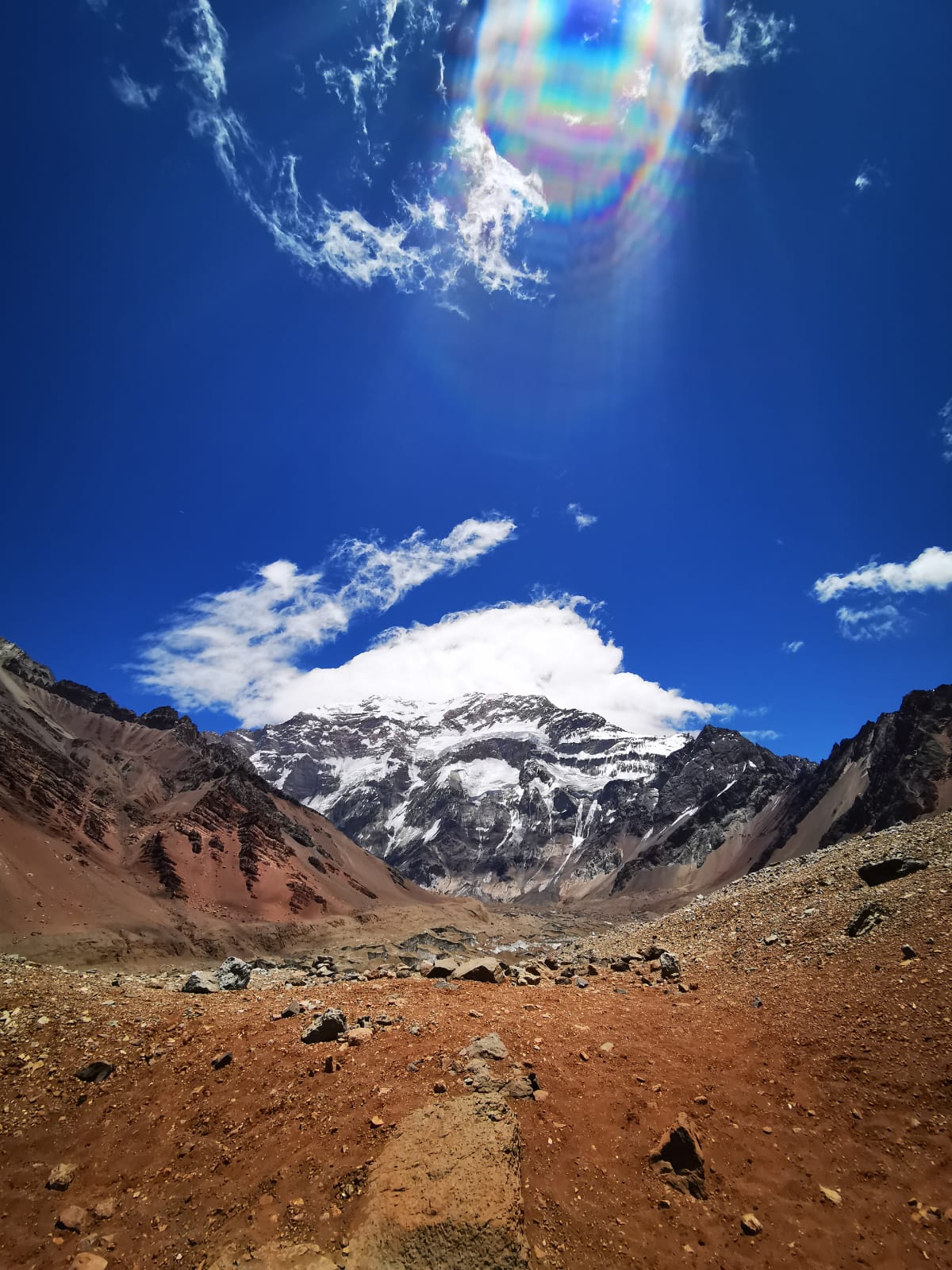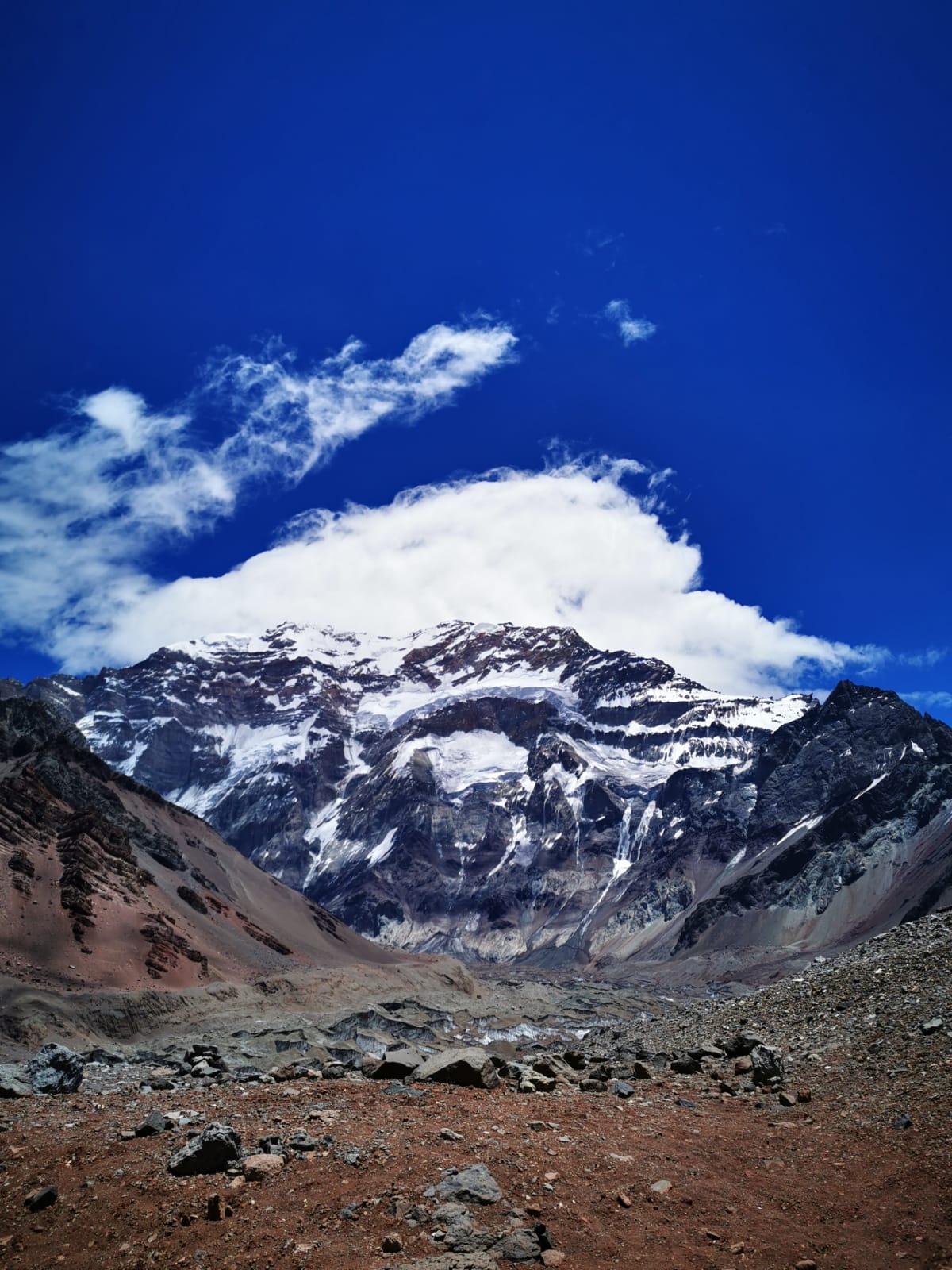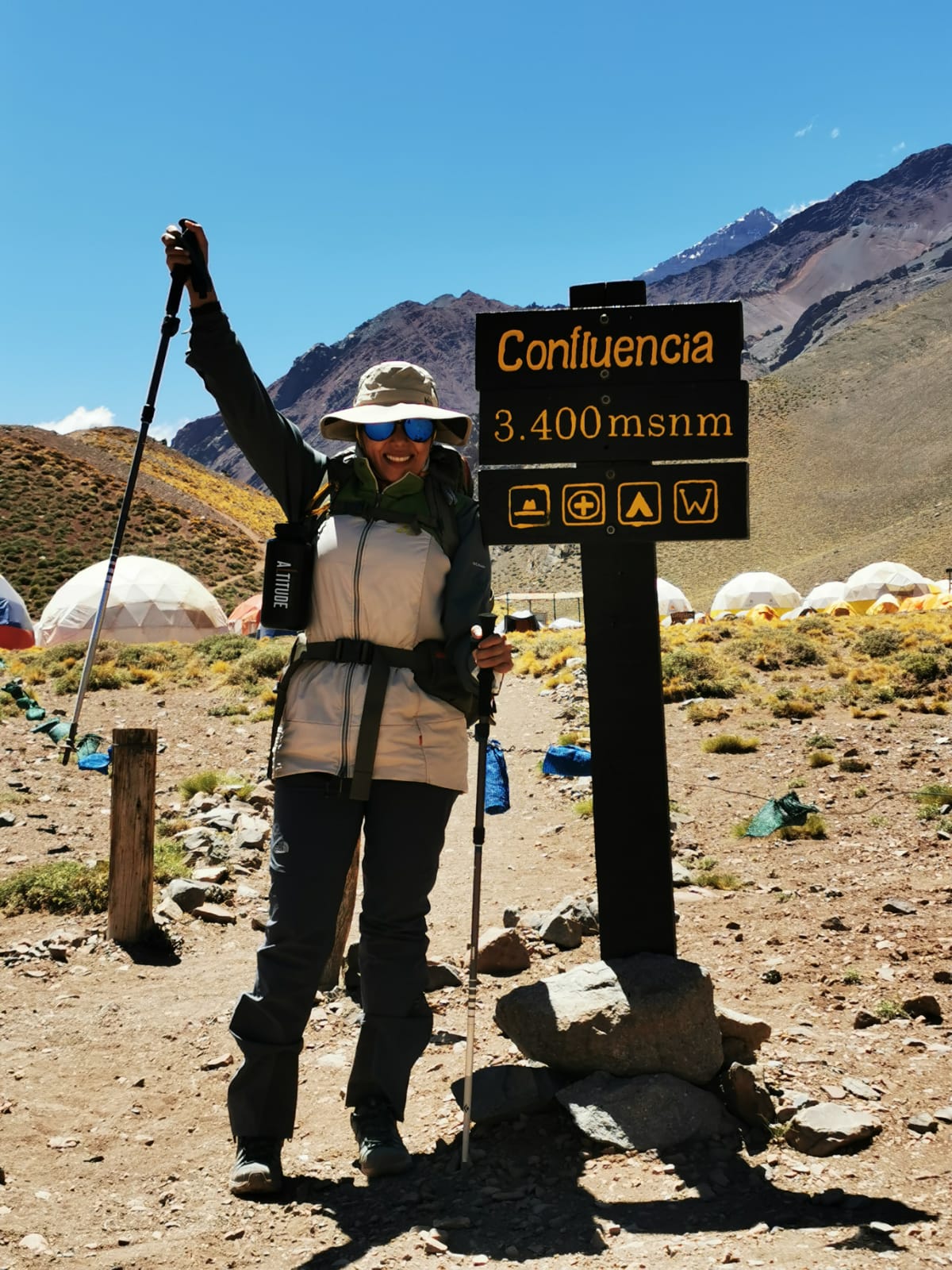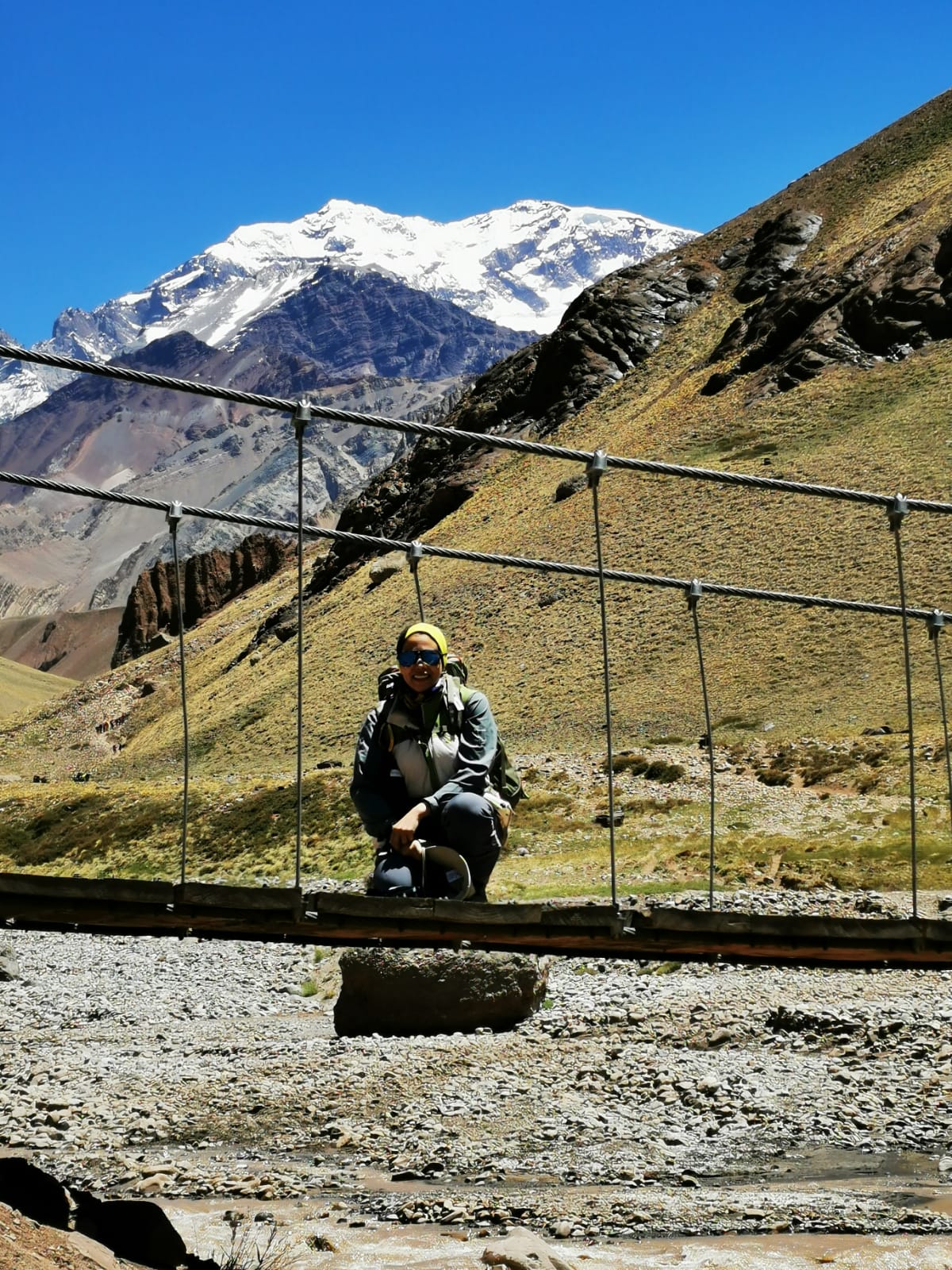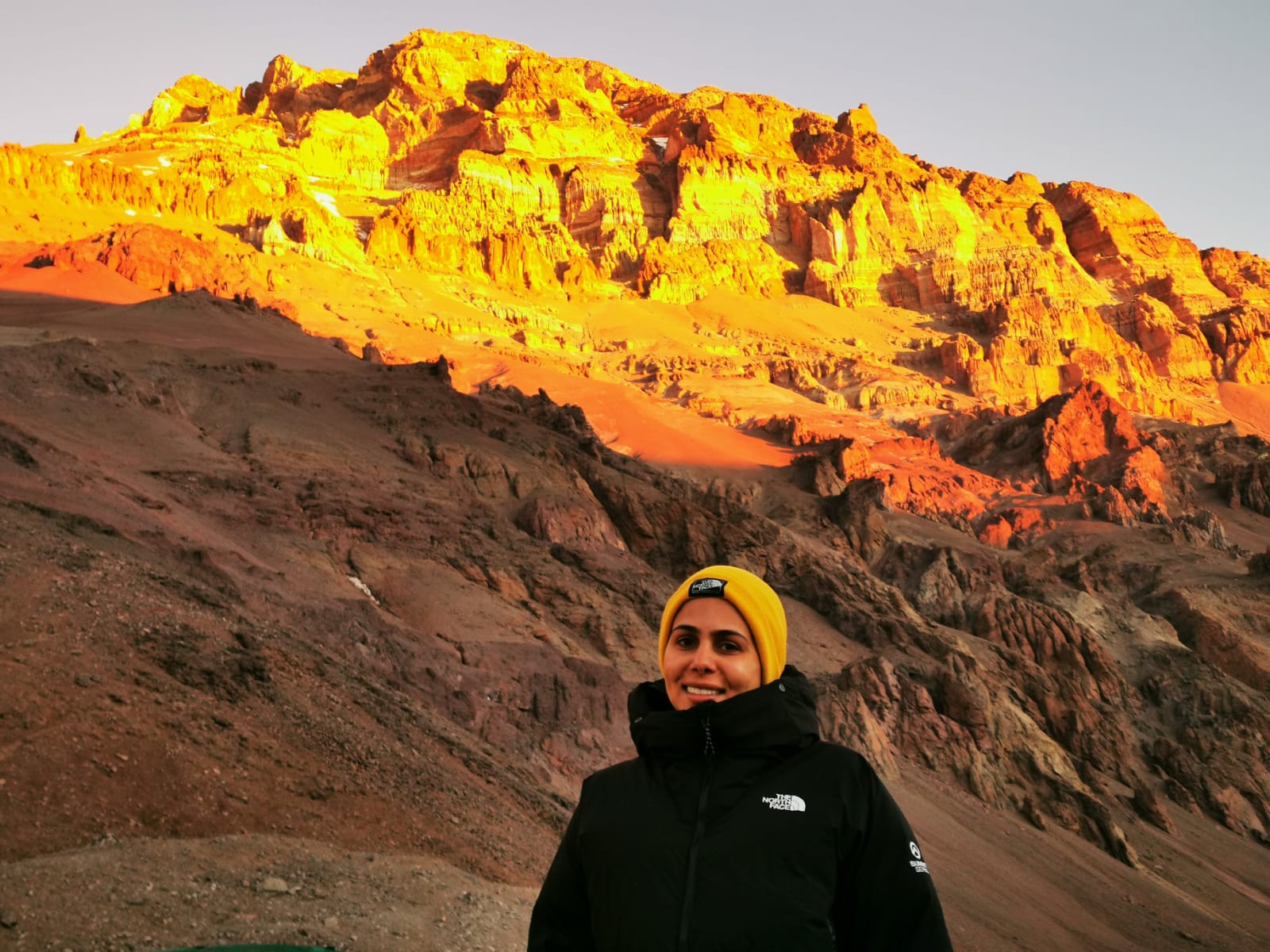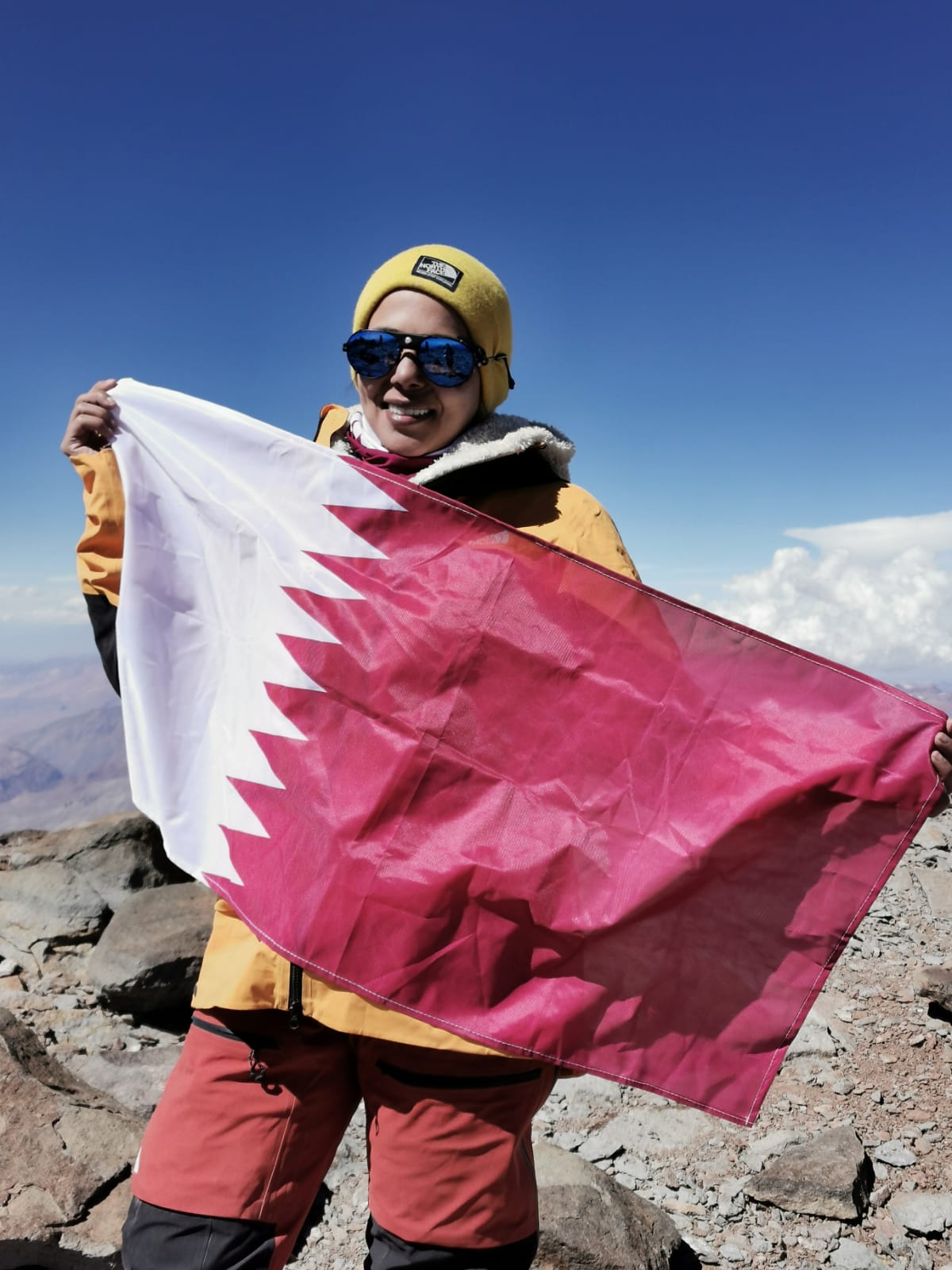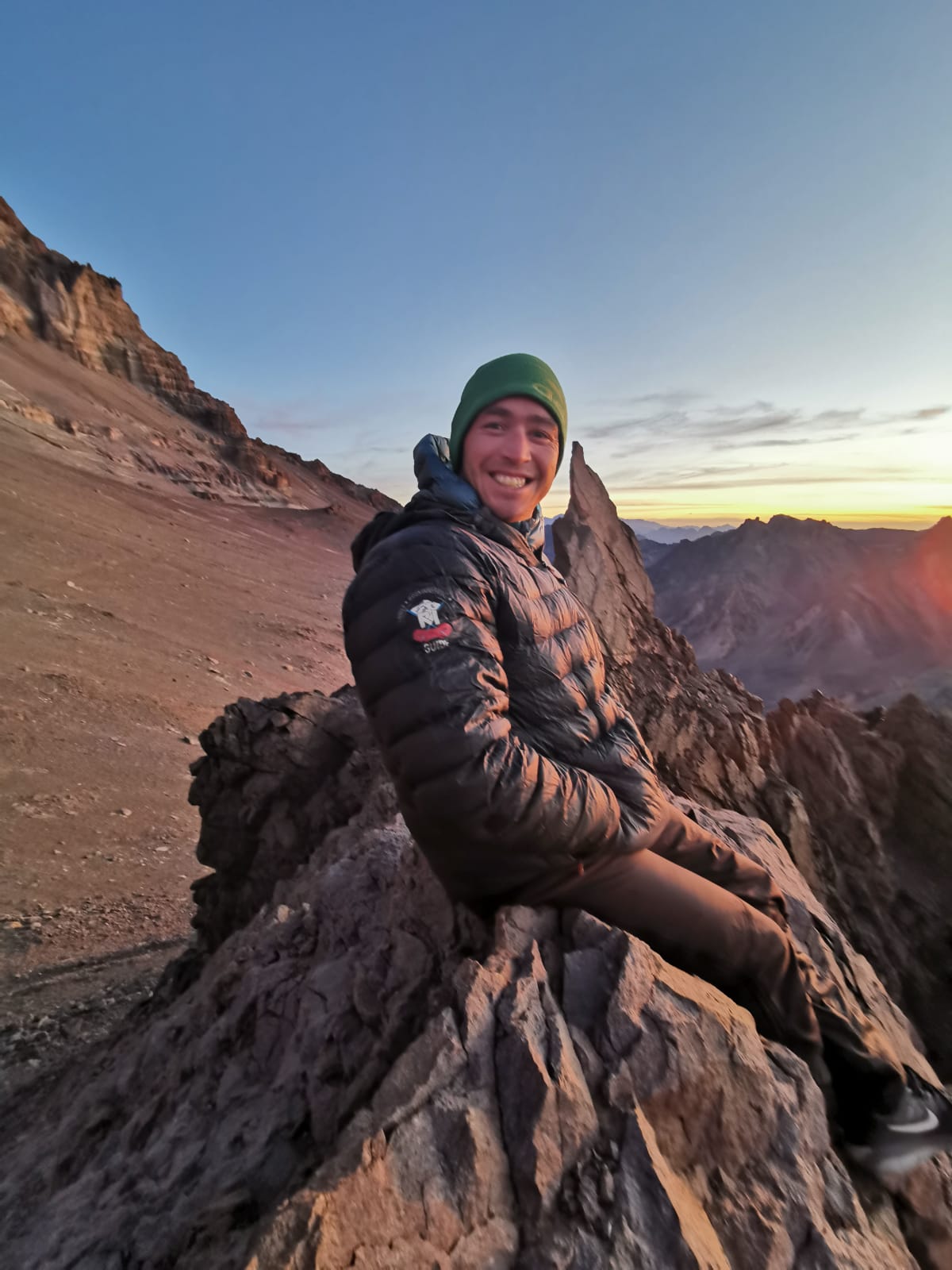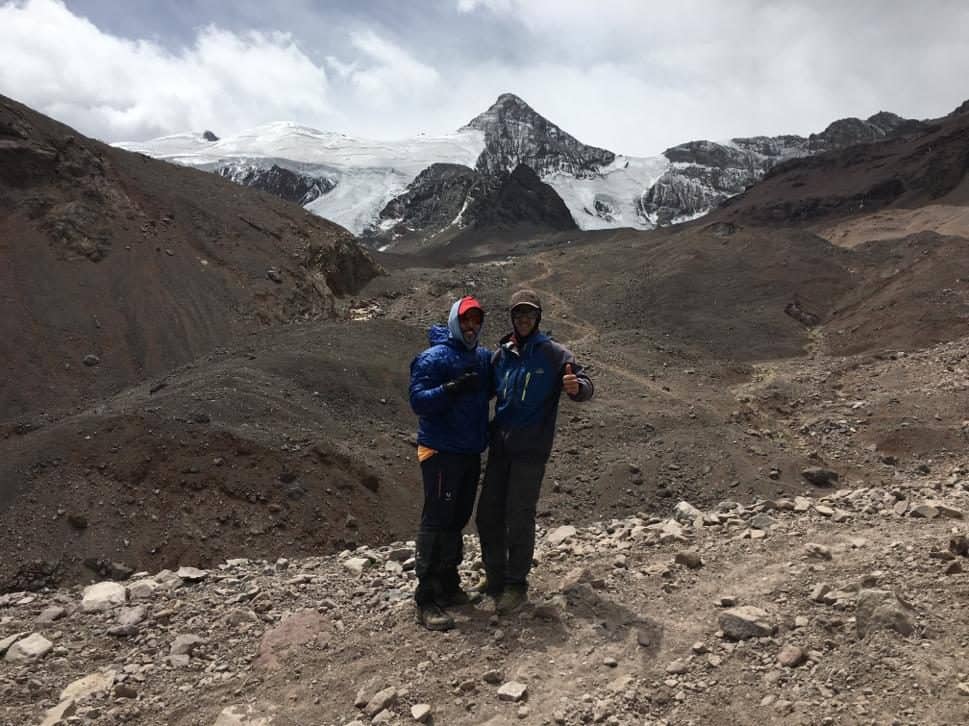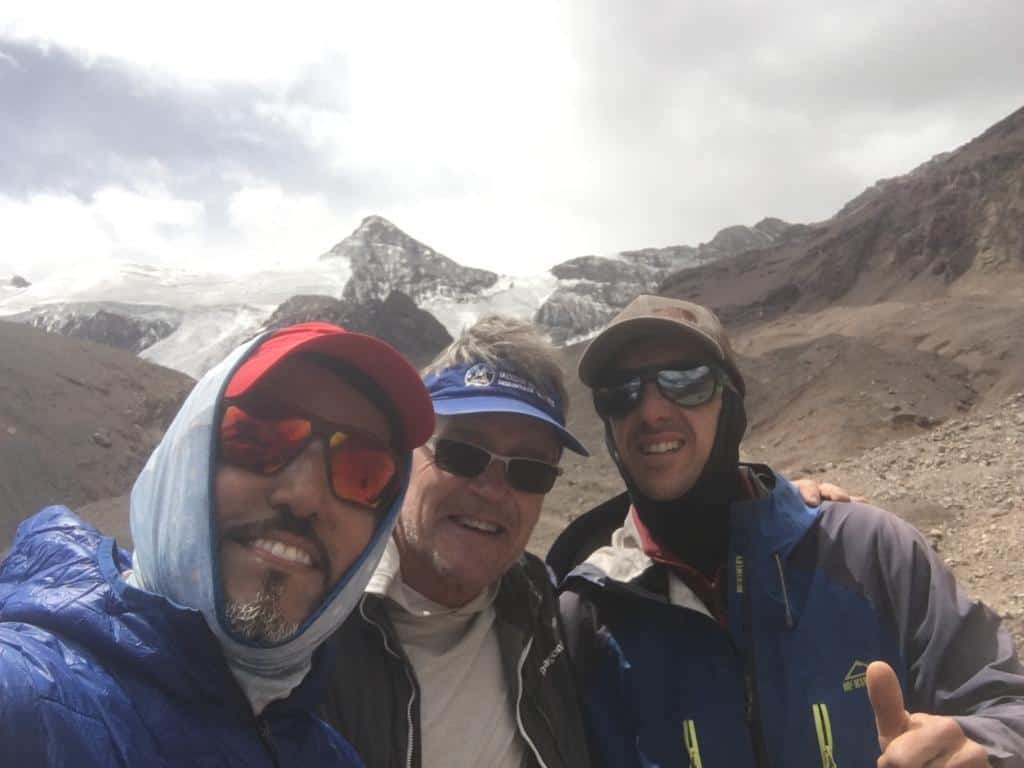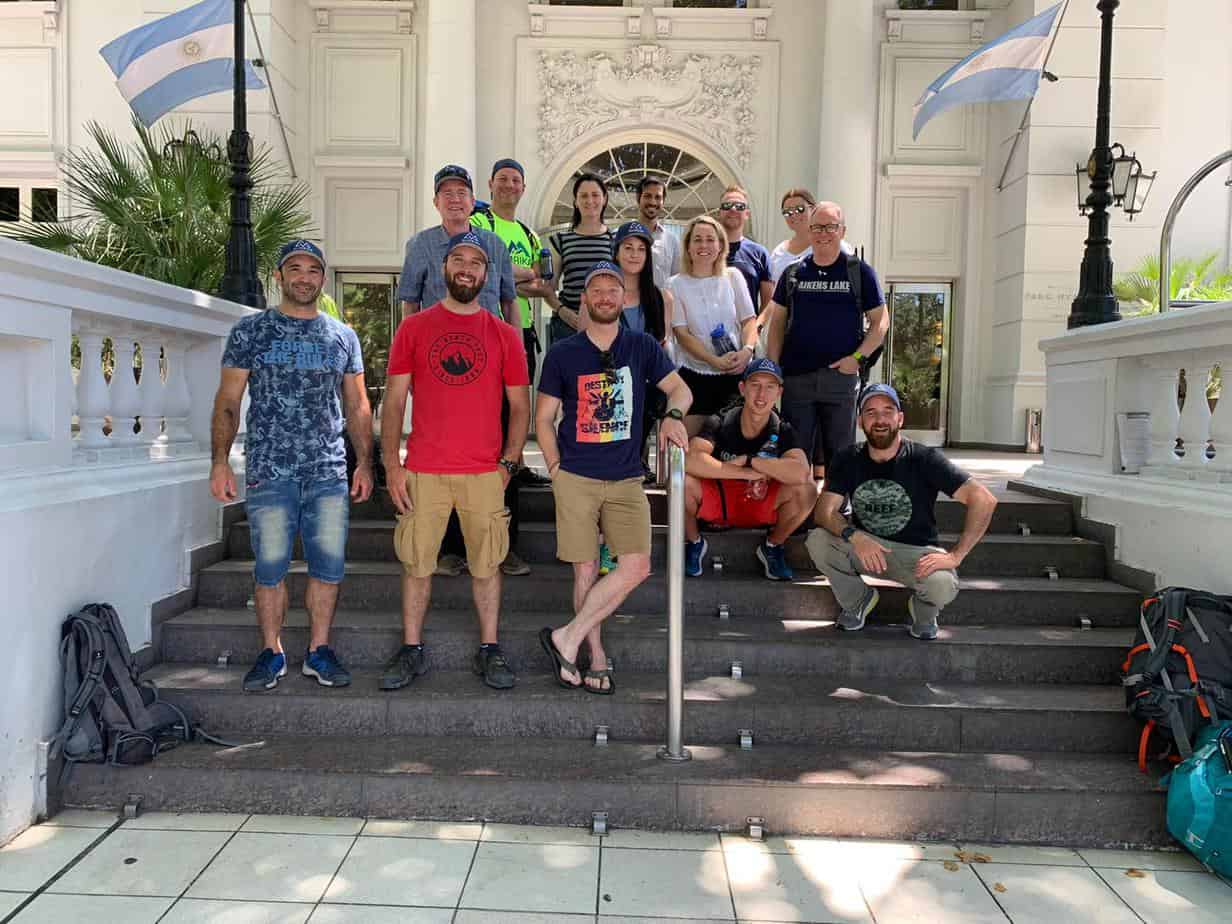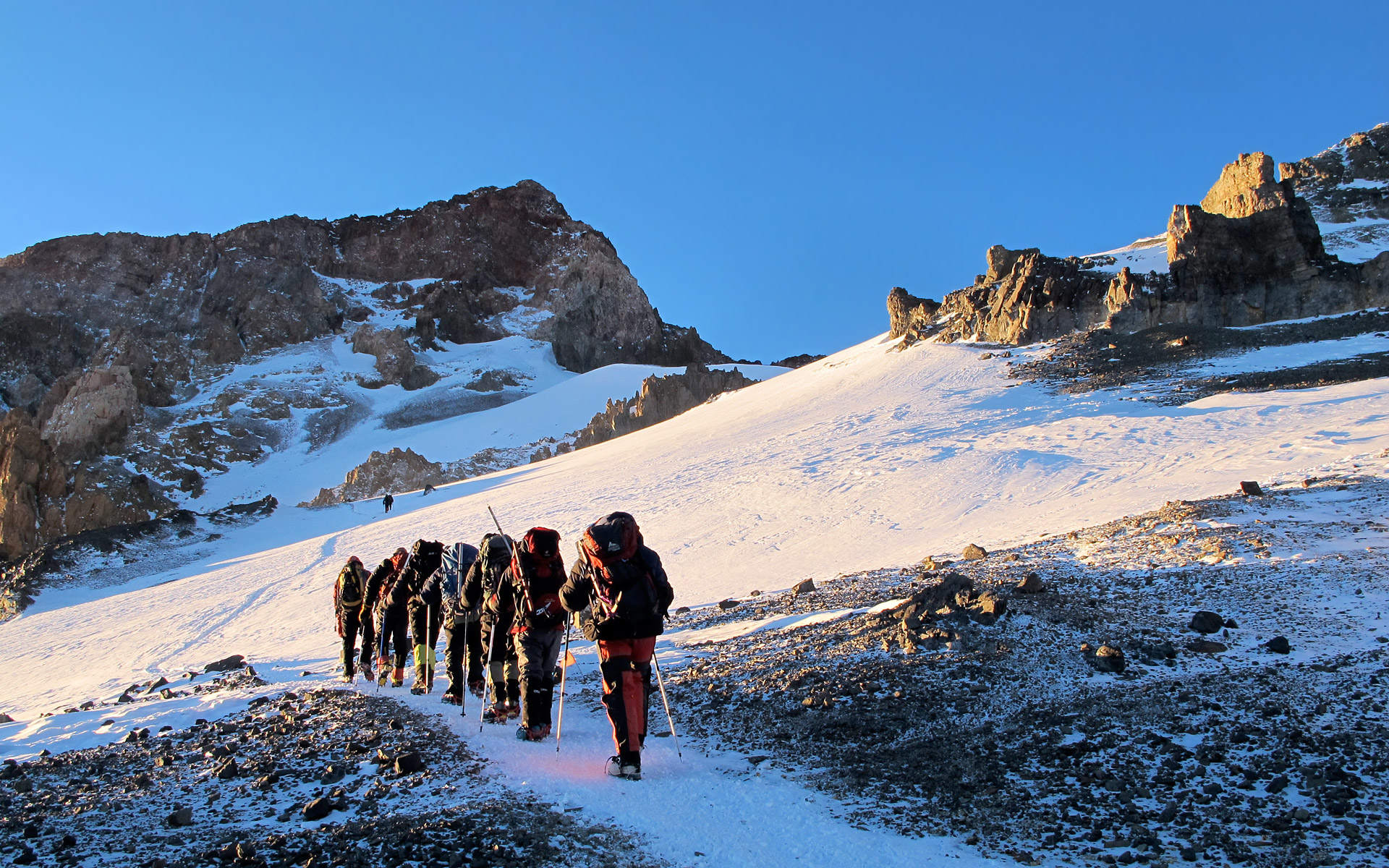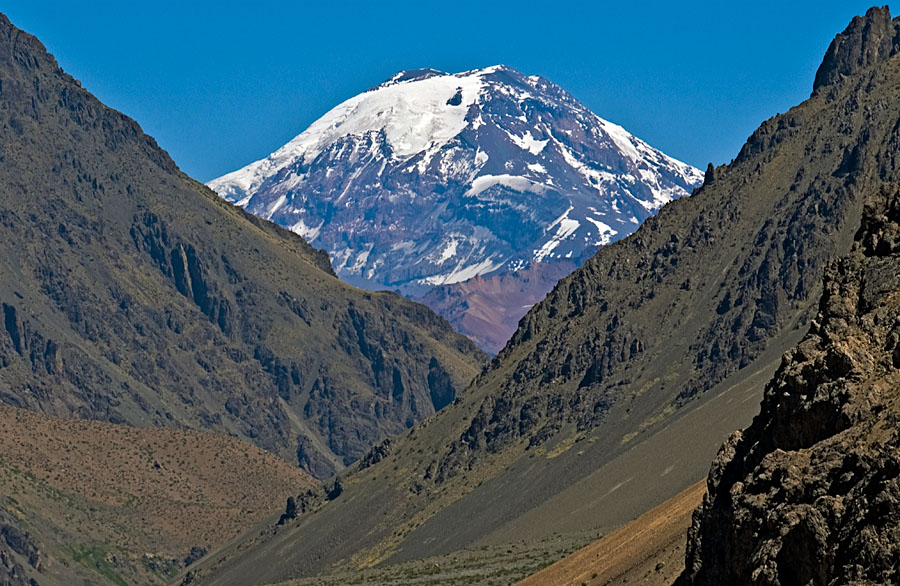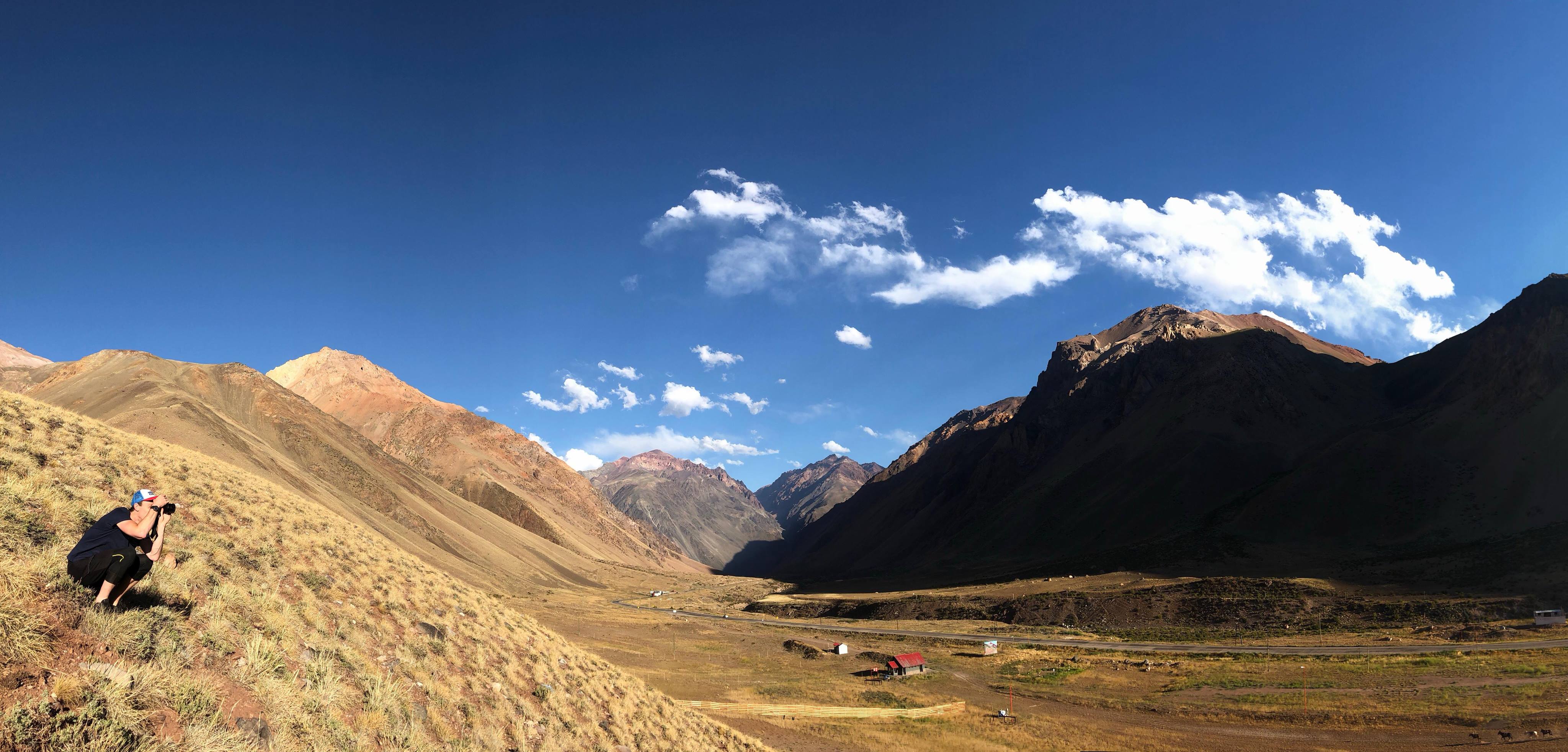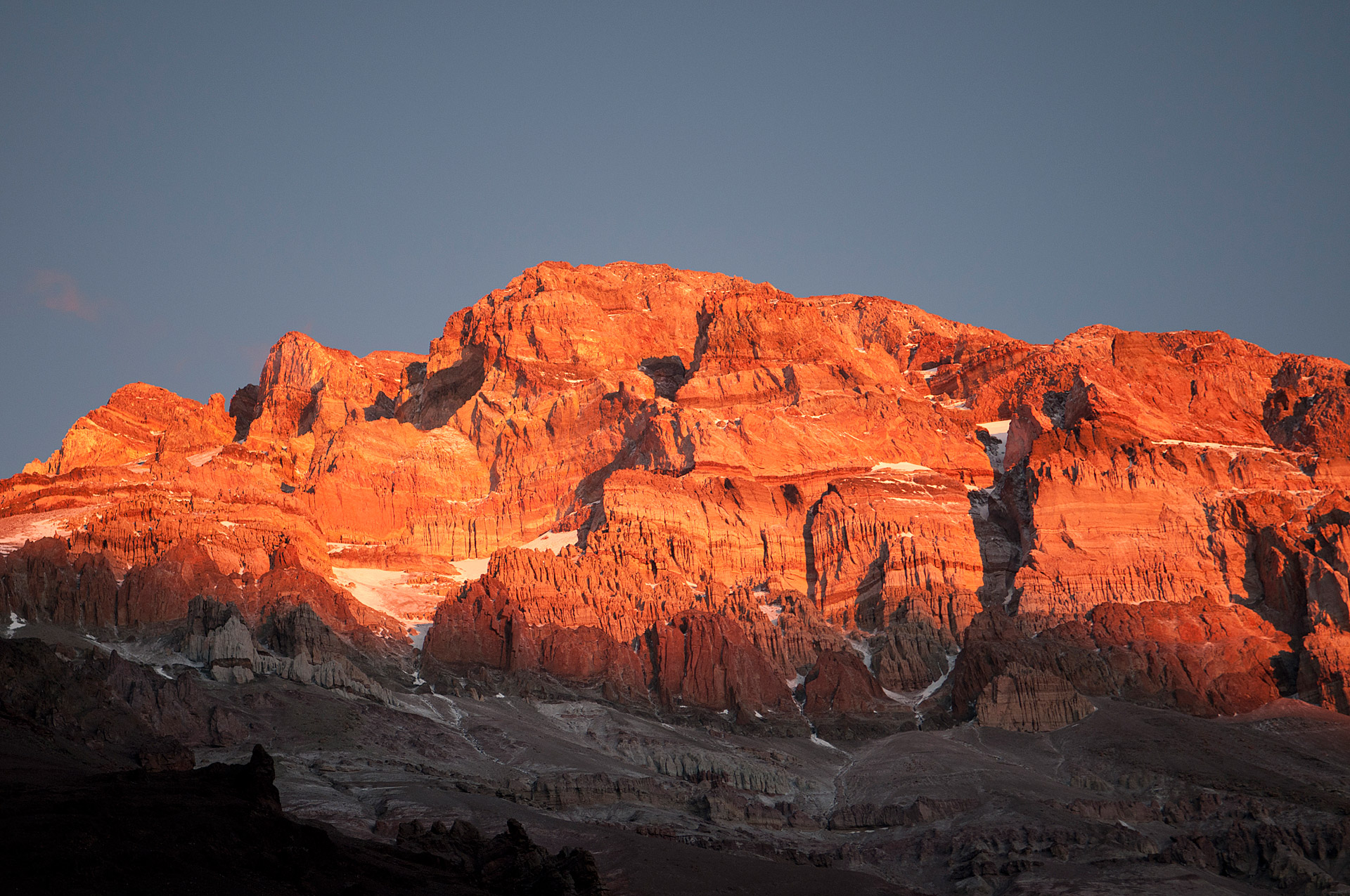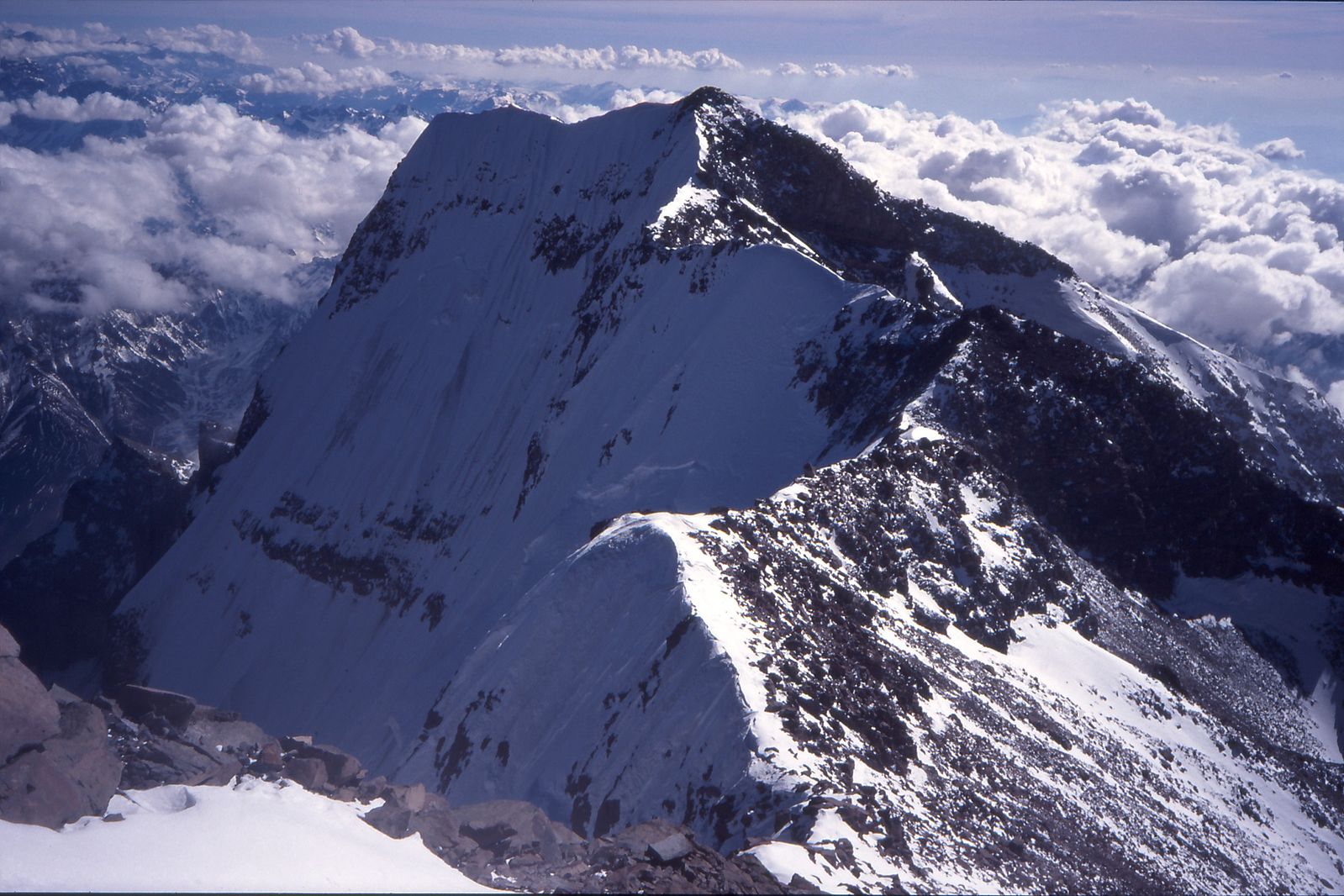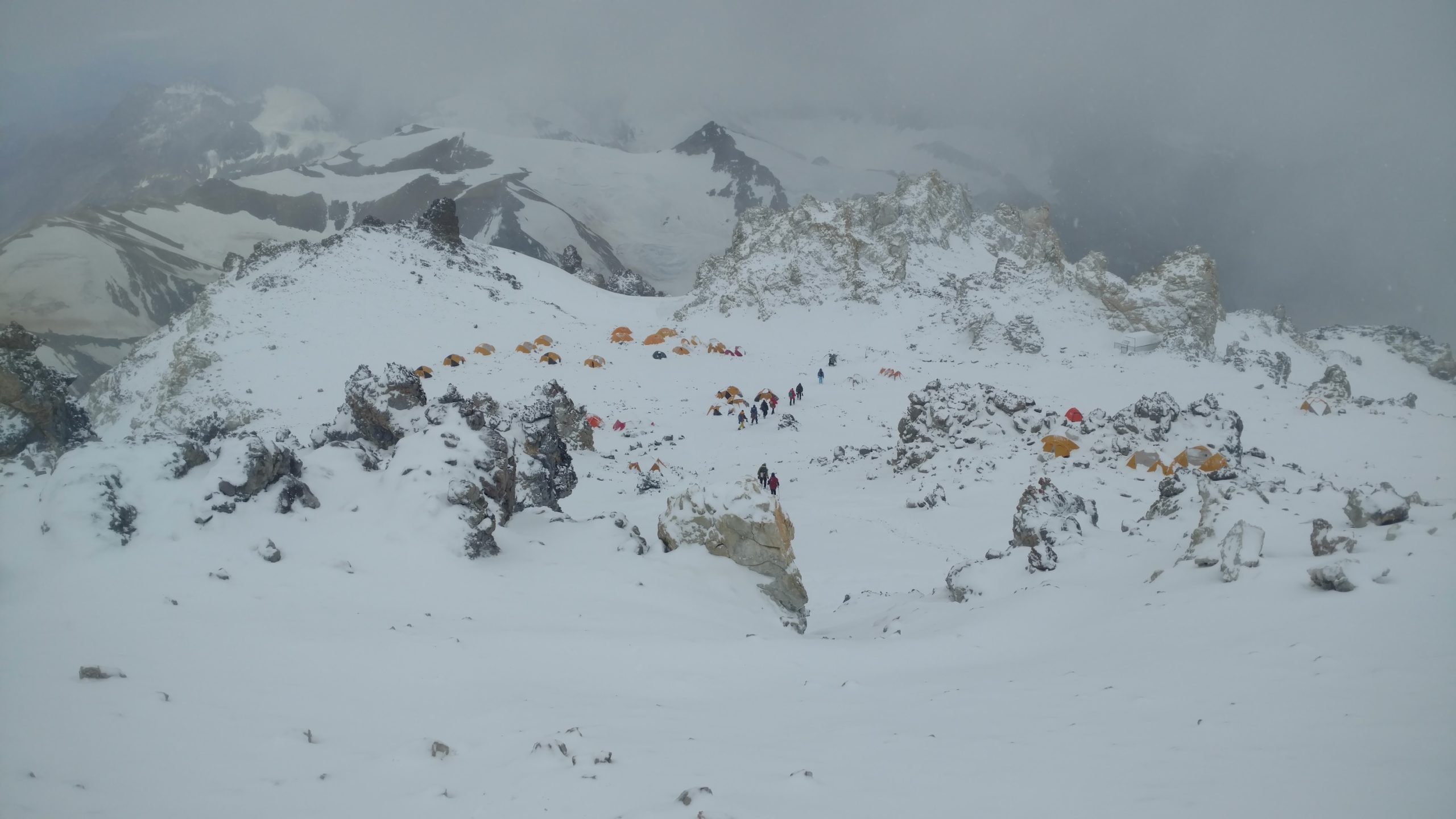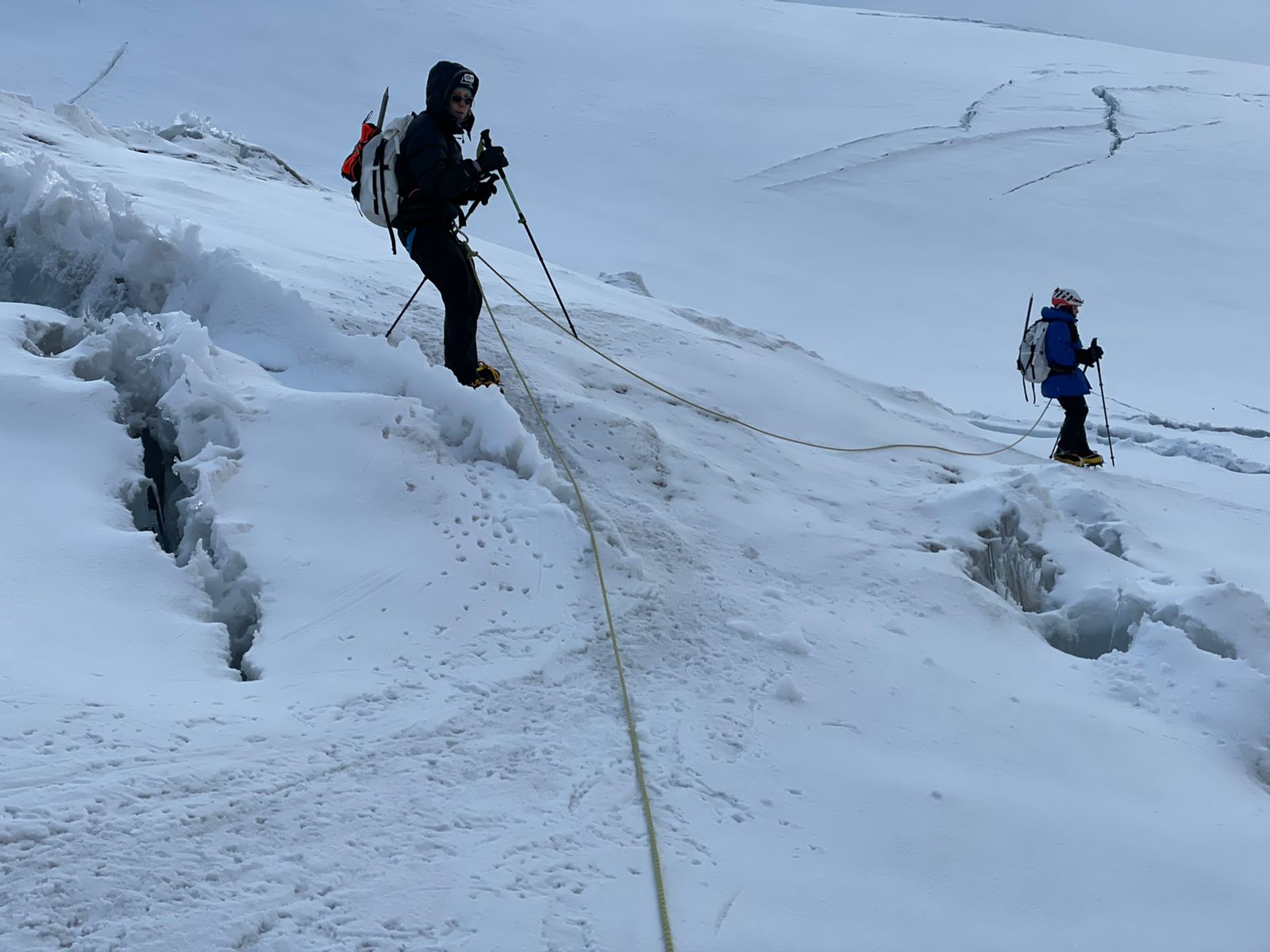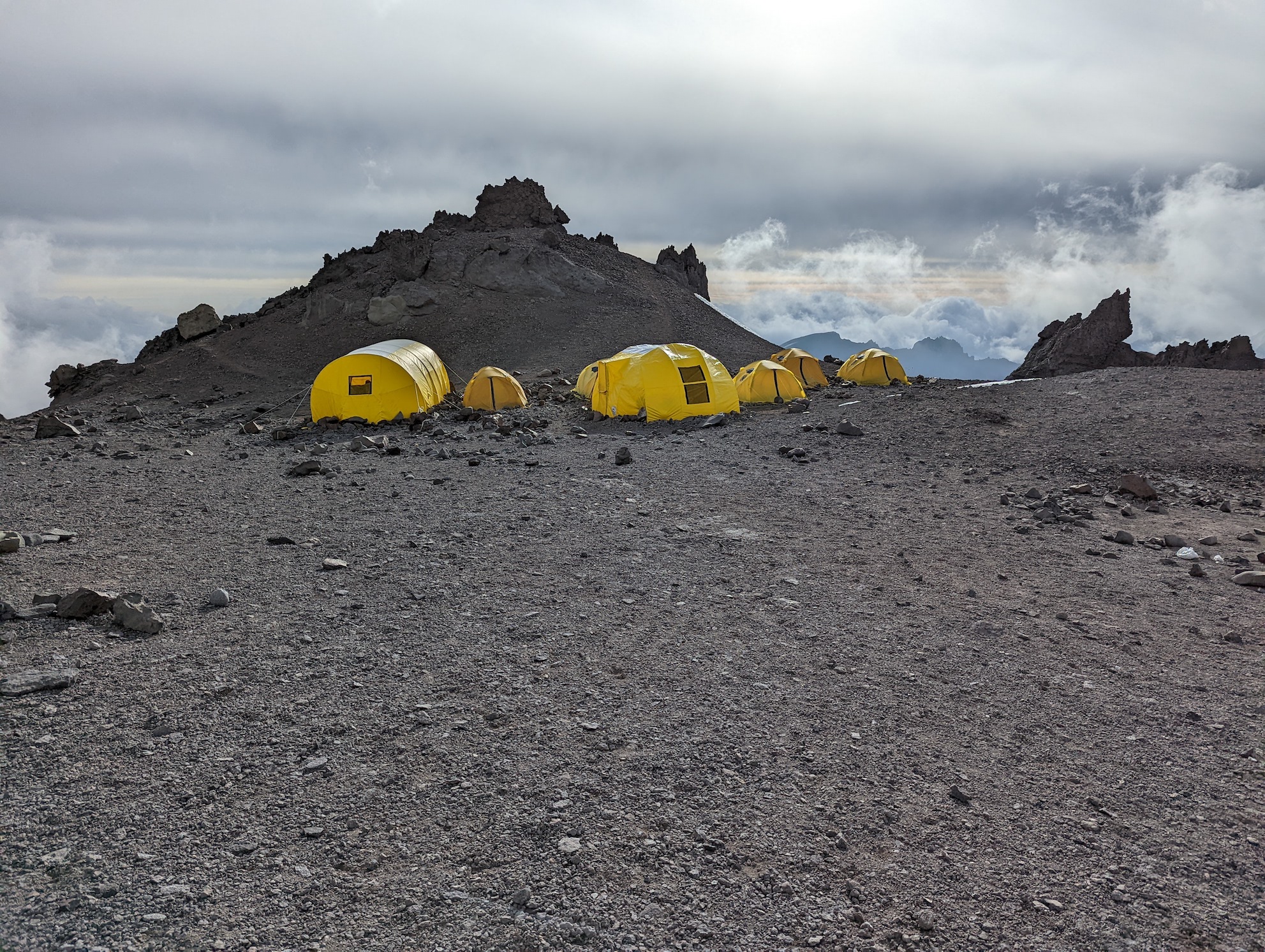Aconcagua Training & Prerequisites
Experience Level
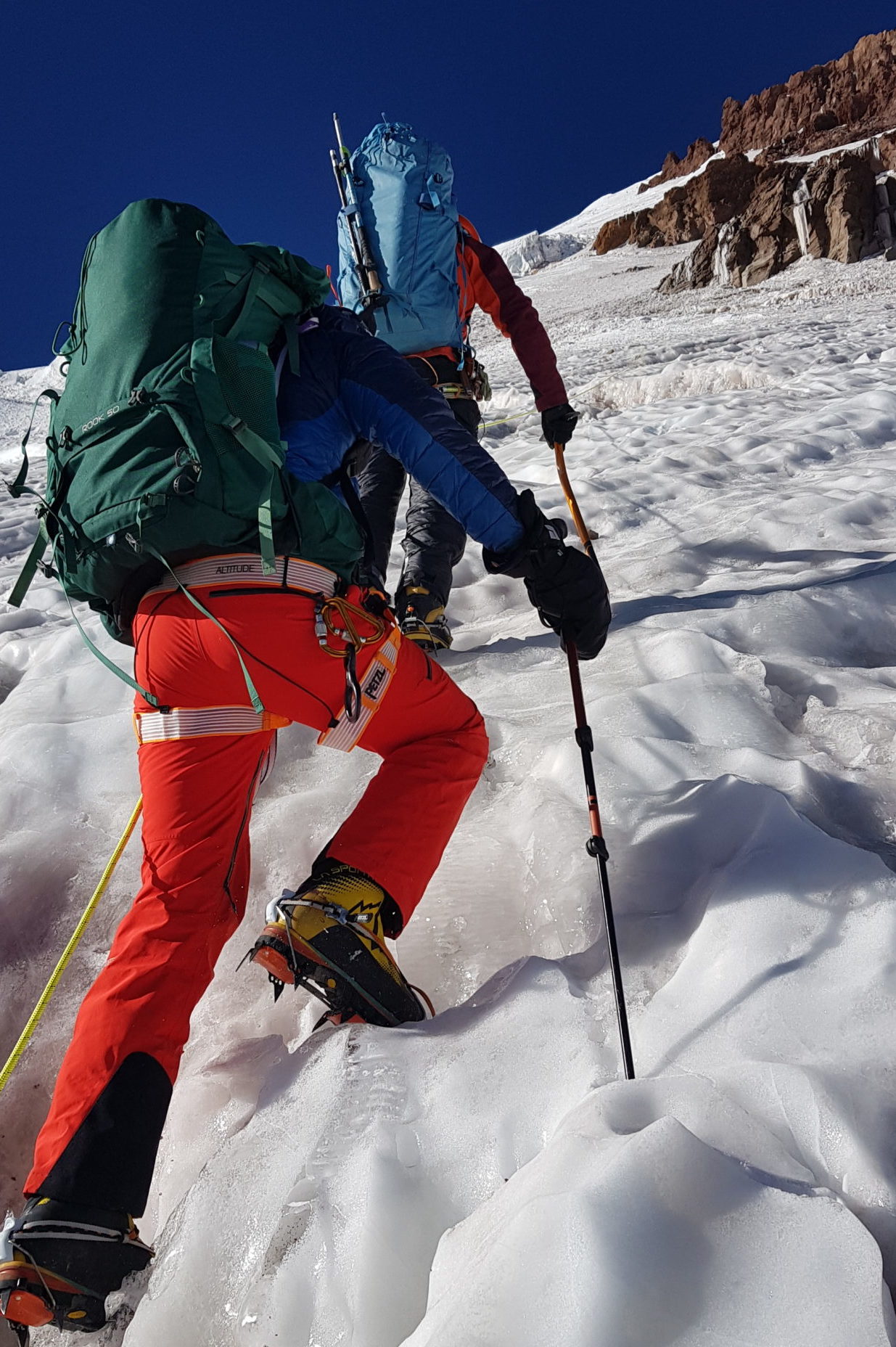
Aconcagua is a great progression mountain for climbers ready to move from lower elevation climbs into the true big mountains of the world like Denali, Manaslu, and Everest.
Climbers need solid cramponing skill, and knowledge of self-arrest technique and ice axe use are valuable but not a prerequisite. If you want to join this expedition but don’t have these skills, don’t worry! We can work with you to get you up to speed prior to the climb.
Frequently underestimated, Aconcagua should be viewed more as a final physical test before Denali than a easy step up after Kilimanjaro. Climbers should be comfortable with carrying a 40-50 pound (18-23kg) pack multiple days in a row on mountainous terrain at altitude.
Climbers coming from Kilimanjaro or Elbrus are still welcome but can really benefit from an intermediary expedition such as the Ecuador Volcanoes or 3 Peaks in Nepal or should be committed to training, consider porters, etc. to shore up their opportunity for success.
Polish Glacier (a more technical variation of the route not to be mistaken for the False Polish Traverse) and Speed Ascent itineraries are a more difficult challenge than the classic itinerary.
Climbers interested in the Speed Ascent itinerary should be ready to commit to 6-8 weeks of pre-acclimatization at home and ideally have previous high altitude experience, while Polish Glacier climbers need to have a strong snow, glacier, and ice climbing background prior to the expedition.
Physical Training
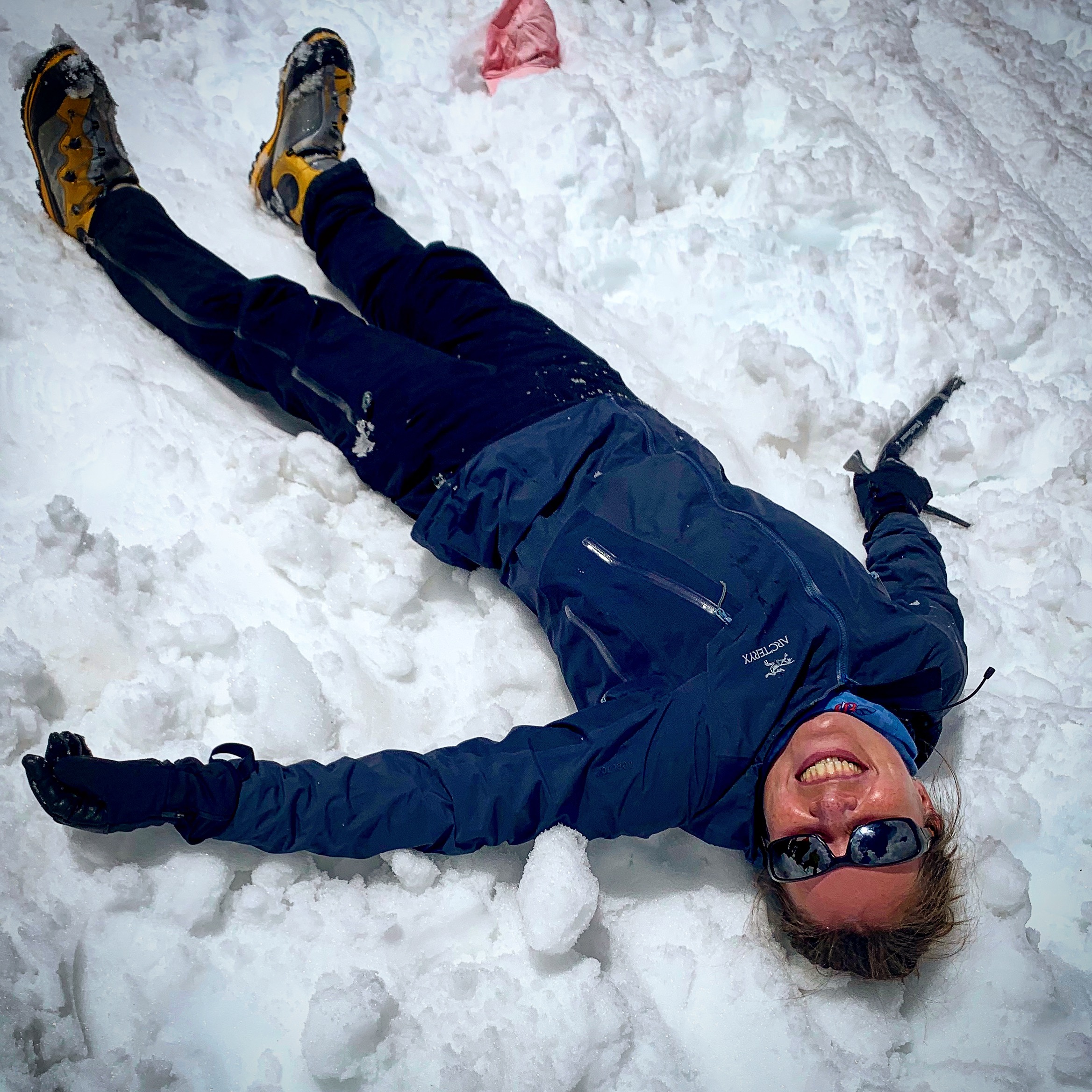
Climbing Aconcagua requires serious fitness, an ability to perform well at altitude, and a desire for rugged adventure travel.
We recommend that you:
- Start specific mountaineering training at least 6 months in advance;
- Train at least 5 days a week for an hour or more;
- Focus on high volume but low intensity training;
- Focus on carrying a weighted pack – start with about 20 pounds (9kg) and work up to the trip weight of about 50 pounds (23kg) over the course of a couple of months;
- Aim to be able to comfortably climb 1,200 feet per hour for 2-3 hours with a 40 pound (18kg) pack;
- Schedule a few weekends where you can do two or more full days back to back. Multiday hikes with good elevation gain are ideal.
Mindset
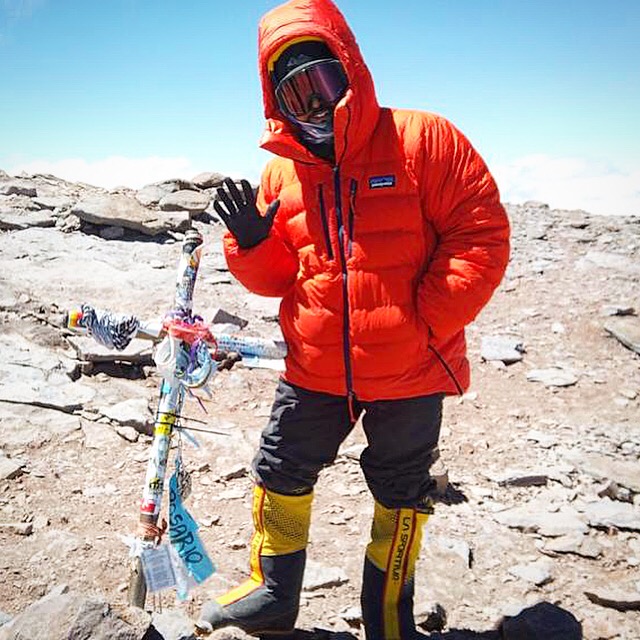
Mindset and preparation are integral to your success on any peak. You should be prepared to:
- Be away from home/work for 3 weeks with long periods outside of cell or internet coverage;
- Have a desire for rugged adventure travel and the flexibility it requires;
- Be open to receiving and deferring to guidance, support, and advice from your expedition leaders, even if you’re an experienced mountaineer;
- Be comfortable having open and honest conversations with your guides;
- Be able to work well in a team environment by being supportive and respectful of fellow teammates;
- Be humble, respectful, and considerate, even under pressure;
- Be comfortable with being uncomfortable.
The Andes are very remote and rugged. While we try to give our climbers all of the creature comforts we can, at the end of the day this is a true adventure and it’s best to expect that.
What Aconcagua Asks from You
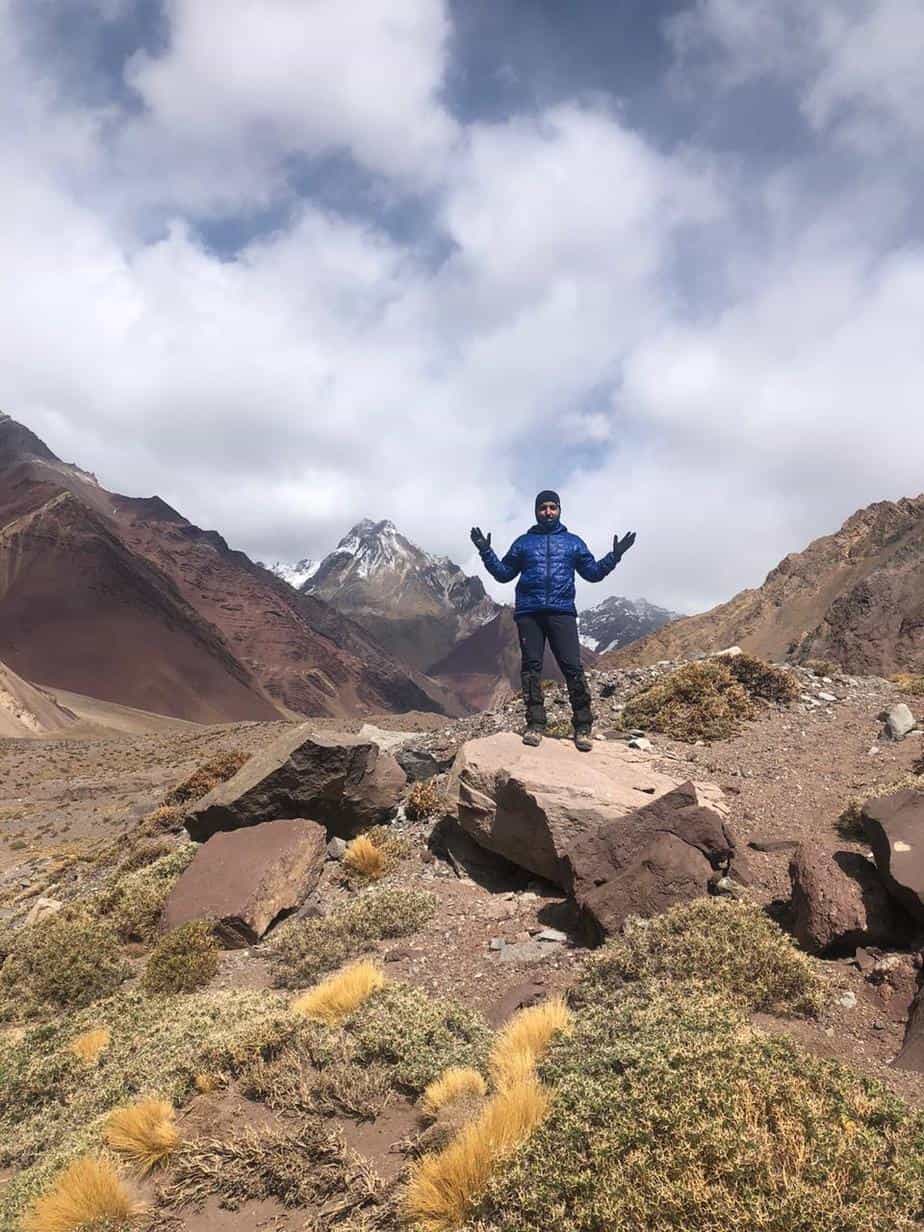
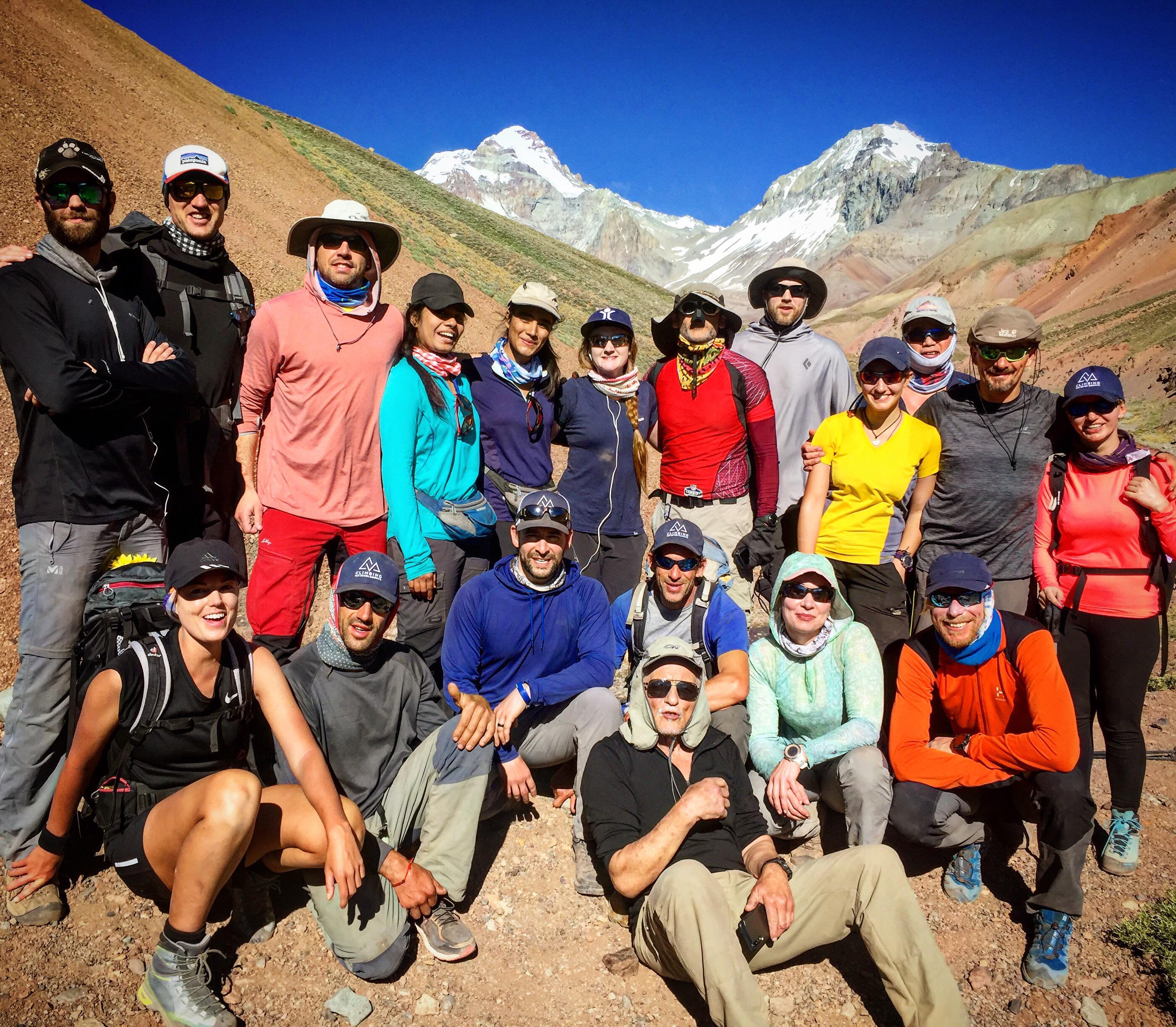
As a guide service, we can do a ton to support our climbers and create a successful trip, but we can’t make the mountain any shorter, less steep, or change the weather.
Each team member shares the responsibility to arrive properly prepared. So what does Aconcagua ask from each climber?
- High physical fitness. Our most common feedback from climbers is, “That was the hardest thing I’ve ever done!” Aconcagua’s physical difficulty is a major step above Kilimanjaro or Elbrus both in intensity and duration. Be prepared to carry a 50 pound (22kg) pack each day above base camp (porters are available at added expense to help with heavy carry loads). With good packing skills, your pack can be lighter – but train as if it won’t be!
- Strong self-care skills. The second most common reason climbers miss the summit on Aconcagua is not taking care of themselves. Bringing everything on the gear list, having the discipline to treat your drinking water, staying hydrated, eating adequately through the day, and paying attention to your layering are all skills you need to master before Aconcagua.
- Flexibility and resilience. Very few expeditions to Aconcagua go completely according to plan. Weather is a common challenge but there are dozens of other factors beyond control that can change the itinerary or plan mid-climb. Our guides are highly experienced on Aconcagua and have a deep set of options, secondary plans, and tricks to draw upon when plans need to change, but as a participant you will need to be ready to ‘roll with the punches’, have patience and trust that our guides have your best interest in mind as we adjust to meet they differing reality of each day.
- Tolerance for dry and cold conditions. Aconcagua is a very arid mountain with extreme temperatures as you move higher. Summit day temperatures are often -15F to -20F (-26C to -29C) plus windchill. Bringing a proper parka and puffy pants along with the rest of the correct gear included on our gear list is critical to maintaining health and safety in these temperatures.
- Being comfortable sleeping in a tent. Our guides can coach you on strategies to be warm and comfortable in tents, but you should be mentally prepared to spend at least 8-10 nights in a row sleeping in a mountaineering tent with a tent-mate.
Aconcagua Beta & Route
Elevation: 6,962m or 22,8410ft
Duration: 15 to 21 Days
Continent: South America
Route: False Polish Traverse
Difficulty: Intermediate
Route Choice
We favour the 360 False Polish Traverse route, which traverses the mountain by going from Plaza Argentina up and over to Plaza de Mulas, and most of our team departures follow that route.
We find people really enjoy this option as the days are more manageable, the scenery is better, and water sources are more stable. It also avoids some of the more crowded camps and it’s pretty cool to go in one way and out the other and see the whole peak.
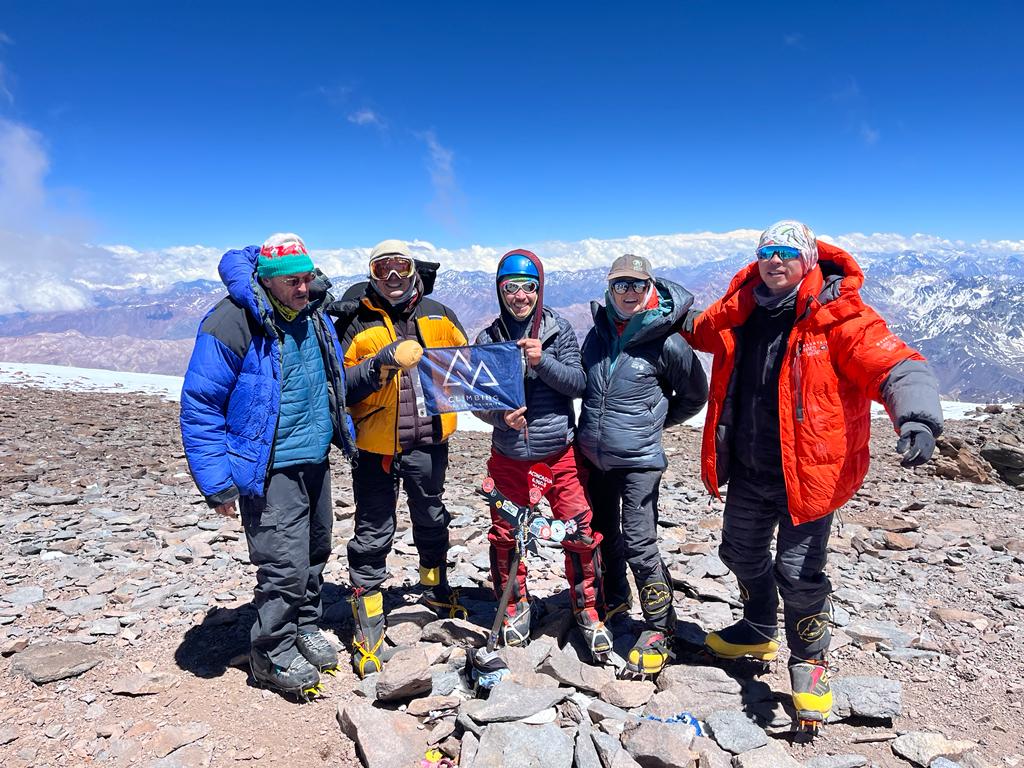
The descent is also easier as it cuts a day off the trek back to the trailhead. Last but not least, our Vacas Valley approach enjoys much earlier light, so it’s a bit warmer and more hospitable than the “Normal” Horcones Valley route.
CTSS teams gather in Mendoza to run through gear checks and briefings, acquire climbing permits, and go out to dinner as a team.
From Mendoza, we will travel to Penitentes, our last staging point by the trailhead, where we will organize mule loads to start our trek the following morning.
We spend three days trekking into base camp carrying only day packs as this leg of the expedition is supported by mules who help carry our trekking duffels to camp each day for us. Our base camp duffels are sent directly ahead and meet us at Plaza Argentina Base Camp for our climb.
Once we arrive at base camp, we will employ a double-carry acclimatization strategy, which involves carrying and caching our gear before sleeping low and moving up the next day. We use three camps above base camp and maintain our high camp as we go for the summit.
Summit day is long, cold, physical, and at a very high altitude. The summit route is not very technical but demands excellent fitness and solid cramponing technique on moderately steep terrain. The summit route can be snow right out of high camp or only a little snow just below the summit, depending on the year and snow accumulation.
From our high camp, we drop down the other side of the mountain, connecting via the ‘Normal Route’ to Plaza de Mulas Base Camp, thus completing the traverse.
We then pack up, wave goodbye to the mountain and trek back out to the trailhead for a late transport back to Mendoza the same evening.
How to Climb Aconcagua
Which Route is the Best?
Aconcagua Beta
Physical preparation is key for Aconcagua. Even if you plan on hiring porters you should be in the best mountaineering shape of your life for this expedition. No matter what you read on other websites about “trekking” this peak, make no mistake: Aconcagua is a mountaineering challenge that requires you to carry a heavy pack uphill at high altitudes day after day. Train as if you’re heading to Denali then enjoy the climb rather than suffer through it!
For an expedition as long and strenuous as Aconcagua we highly recommend purchasing your gear rather than renting. Properly fitting and breaking in your boots, pack and other big-ticket items is extremely important. Additionally, having every little item already secured and packed will make your time in Mendoza much more relaxed and ensure you’re fully ready for the trip.
If an airline loses bags or there is a major gear malfunction there are a few rental and mountaineering gear shops in Mendoza. During the busy Aconcagua season sizes and availability are not guaranteed. Your guide can help point you in the right direction if this situation arises.
Terms to know for Aconcagua
- Plaza Argentina - Our base camp for the ascent. Located on the east side of the mountain, we trek into Plaza Argentina before leaving the base camp to traverse the mountain, summit and descend into a different base camp.
- Plaza de Mulas - Base camp on the descent located on the west side of the mountain and also base camp for other climbing teams using the 'Normal Route' rather than the 360 Traverse route. We will descend to Plaza de Mulas after our summit bid and stay for one night before finishing the hike out to the road.
- Vacas Valley - Pronounced “Bacas Valley,” this is our route for the trek in. We start at the terminus of the Vacas and trek two days up the valley before taking a side corridor up to Plaza Argentina on the third day of the trek.
- Horcones Valley - Plaza de Mulas is located at the head of the Horcones Valley. On our descent and trek out we will follow the Horcones River through the valley from Plaza de Mulas down to the road, a distance of about 18 miles (29 kilometers).
- Double Carry - A technique for acclimatization and carrying the large amount of gear we need to support our expedition. Double carries mean two trips to each camp. For example, we will pack all our extra food and any gear we don’t need at the moment into our packs, ascend from Plaza Argentina to Camp 1, cache our gear at Camp 1, then return to base camp the same afternoon to sleep low. The next day all remaining gear goes in our packs and we re-ascend to Camp 1, staying there and leaving Plaza Argentina behind. Repeat for Camp 1 to Camp 2, and Camp 2 to Camp 3. We will do a single carry with all gear down from Camp 3 to Plaza de Mulas after summit day.

What is a Double Carry?
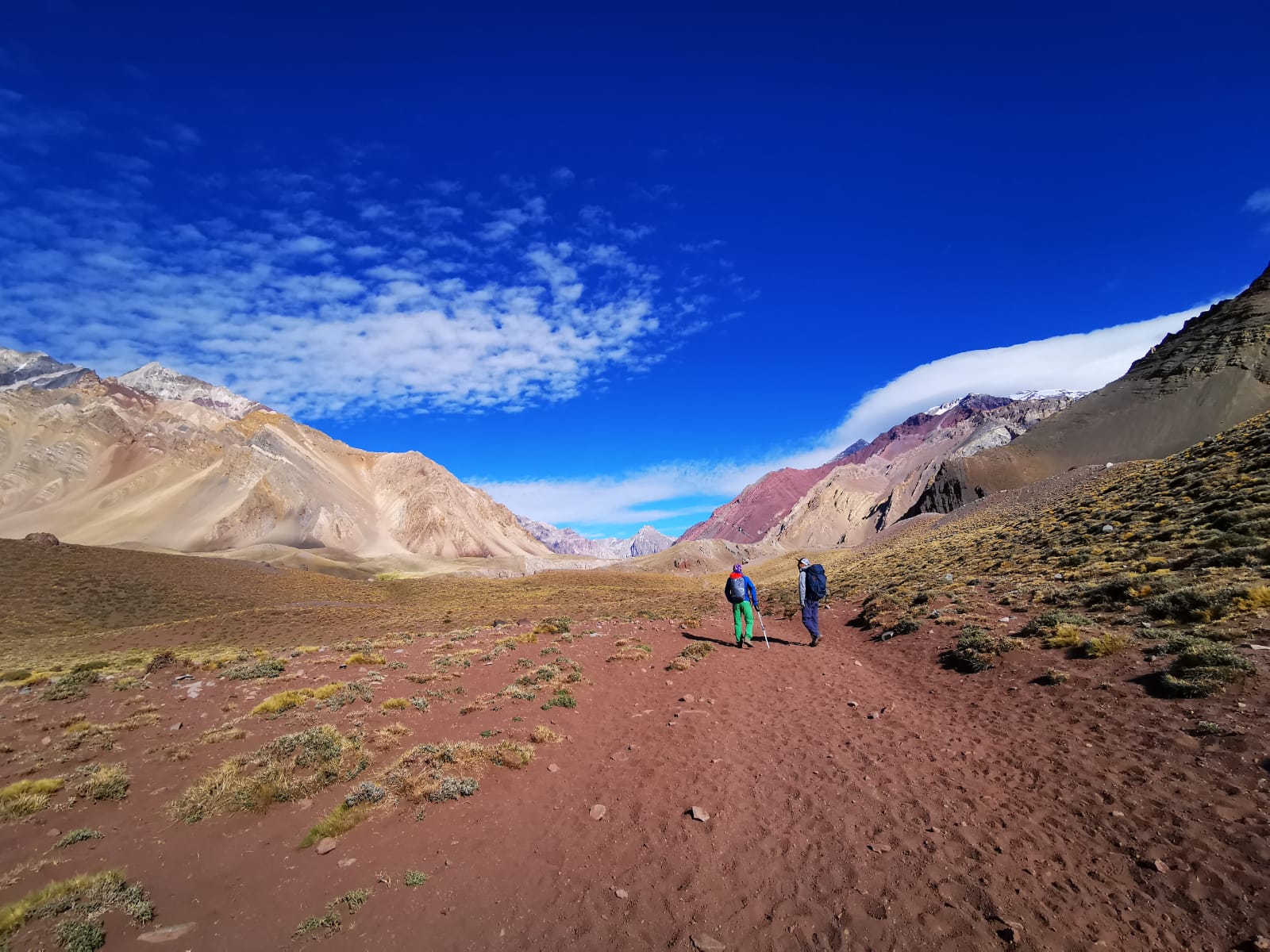
How to Choose The Right Aconcagua Expedition
How to Choose The Right Aconcagua Expedition
Share Expedition
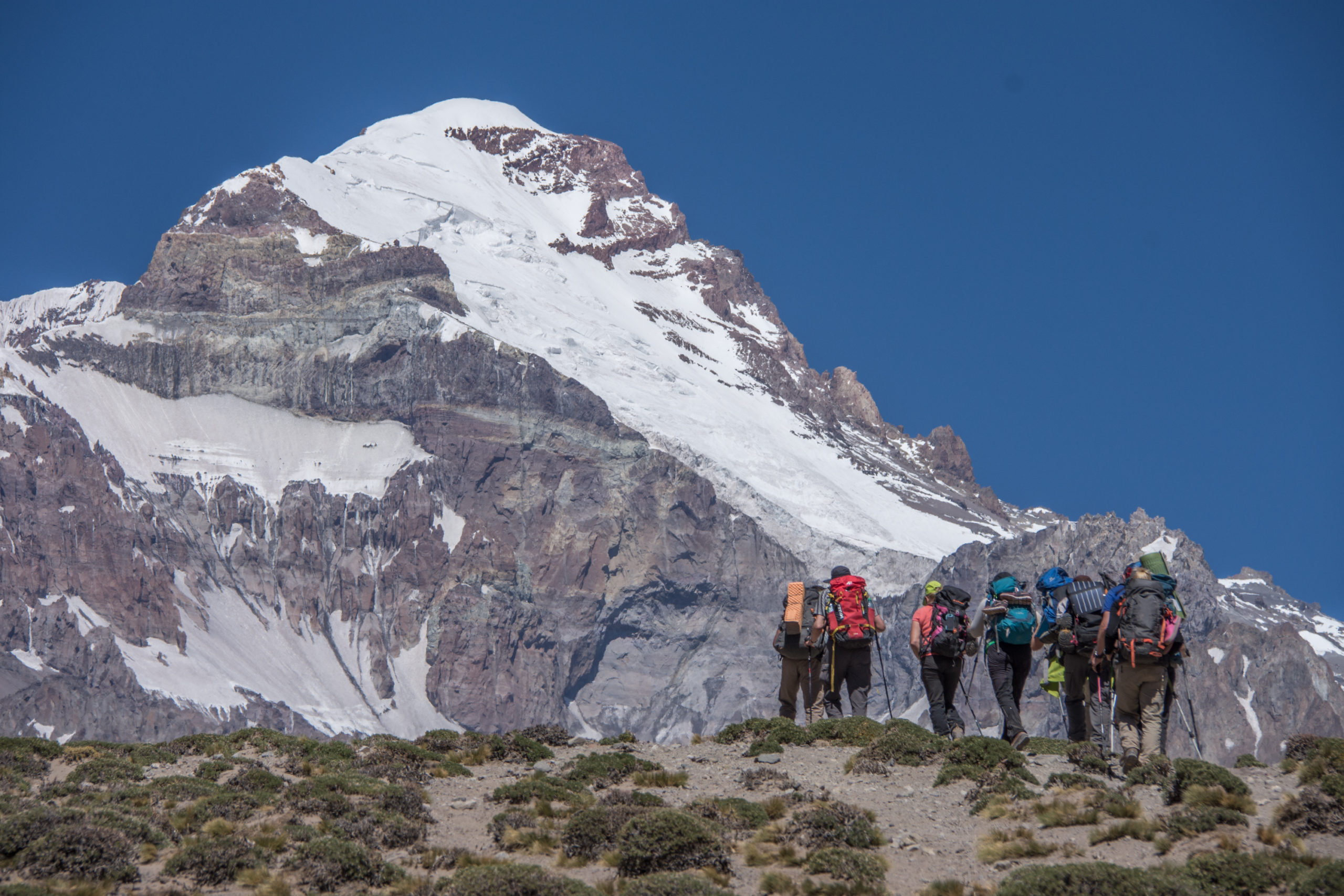
Researching and choosing the right expedition company to support you and help guide you through all logistics, as well as be there for you on the mountain, is the most important decision you will make.
You want to do your homework so you feel 100% confident in your choice and can focus on your climbing.
We encourage you to look closely at both the big picture and the small details. Look at a company’s priority on safety, the quality and experience of their guides, their reputation, and their level of ‘care factor’.
Climbing the Seven Summits is committed to being the Gold Standard on Aconcagua and providing the highest quality expedition. You can be assured that it will be both challenging and fun, a true once-in-a-lifetime experience.
Safety & Success
Your safety and success are the top priorities, in that order. An expedition company should invest heavily and plan extensively for your safety by outfitting their teams with the best logistics and the most capable, qualified, and seasoned guides in the world.
Aconcagua is arguably one of the most underestimated peaks in the world with many climbers expecting a difficulty similar to Kilimanjaro. At Climbing the Seven Summits we believe it is in your best interest to tell it to you straight – Aconcagua is a very tough mountain! Physically it is closer to Denali than Kilimanjaro or Elbrus, with several days of carrying a full pack from camp to camp just to get in position for the summit day.
Summit day itself is one of the most arduous days of climbing on any of the Seven Summits involving 12 to 16 hours of climbing above 20,000 feet.
Beware of operators who downplay the difficulty of Aconcagua or call it a beginner peak just to bolster their team size; they often end up turning half their team back without remorse as they chase a buck. At CTSS we will be frank about the realities and challenges of Aconcagua so you can arrive properly prepared to meet your goal rather than sugar coating it as an ‘easy trekking peak’. While Aconcagua may seem ‘technically straight forward’ the length of the expedition, the weight of your pack, the extreme altitude, and self sufficient expedition style combine to make it a true big mountain experience.
Our program has been designed to keep you safe and see you succeed. Our Aconcagua climbs boast a whopping 93% client success rate overall, compared to the standard of 30-40%!
CTSS is happy to provide training suggestions and link our climbers to qualified coaches to prepare for any climb.
Look For A Slow Acclimatization Schedule
Most people fail (60-70% of people) on Aconcagua because of poor acclimatization and a rushed schedule.
Aconcagua is an extreme altitude peak and should be treated as such. To be successful you need to give your body time to adjust, even Base Camp is at an altitude of 4,200m!
Look for an expedition company that has inbuilt contingency days, a carry high, sleep low strategy, and a calm and patient ascent. Avoid expeditions that offer shorter itineraries, which – while tempting if you only have a certain amount of holiday leave from work – are detrimental to your success. (The exception to this rule is a true ‘speed ascent’ climb where you diligently preacclimatize at home.)
Everybody acclimatizes differently and how well you acclimatize can even vary from climb to climb. Be patient with yourself, be conservative, and make sure you take care of yourself (for instance, keeping a slow pace and keeping well hydrated).
Our CTSS Aconcagua guides our experts at high altitude pace setting and identifying signs and symptoms of AMS (Acute Mountain Sickness, commonly known as altitude illness) to keep you safe.
Leadership
Look for guides who are seasoned experts with a strategy that is patient, conservative, and well planned to give you the best opportunity for success.
Guides on Aconcagua should be well qualified with excellent safety records.
They need to be adept at managing a team while troubleshooting and pivoting their plan and strategy to meet the conditions of the day. It is a given on Aconcagua that plans will change and having a seasoned guide who can work through that by leaning on their own extensive experience in the mountains is key.
Guides should also have a history of assisting climbers in navigating travel in Argentina and have a solid background support structure.
Our mountaineering guide staff are second to none, and our teams also always include our phenomenal local guides who have spent decades climbing and guiding on Aconcagua, speak Spanish fluently, and can share their generous Argentinian culture with you. Our local guides are the class of the mountain, meeting and exceeding the high expectations around safety and customer service that CTSS demands.
As operators on Aconcagua we strive to be the most forward thinking and best prepared outfit on the mountain.
Customization
As mountaineers ourselves, we know not every climber is the same and a ‘one size fits all approach’ doesn’t apply very well to big mountains like Aconcagua.
Look for an operator who will customize your expedition to suit your experience, time-frame, budget and goals.
For example, pressed for time? You can do a speed ascent and pre-acclimatize at home.
Fixed departure dates don’t suit you? Craft a custom trip around your own schedule.
Want a little more ‘rugged luxury’? Opt for our Aconcagua Executive expeditions to give yourself the edge in comfort, schedules, and amenities.
Want to work with a particular guide? No problem!
CTSS can make it happen.
Marginal Gains - The small things add up!
Have you heard of the “Marginal Gains” philosophy?
The idea is that by capitalising on every little hidden advantage – 1% here, 1% there – small gains quickly compound into a huge overall improvement.
CTSS prides itself on this kind of innovation across all of our expeditions including Aconcagua. We optimize both the big details like guide staff, schedules etc, all the way through to the tiny comfort details.
For instance we plan our expedition menus using local food which is hearty and delicious vs. eating dehydrated or basic camp meals because we know well fed climbers are happy, healthy climbers with more energy on summit day.
It’s also why we invest in the nicest accommodations in base camp which include hot showers and free wifi, and provide hot drinks and other snacks to keep you energised and hydrated.
People may dismiss little luxuries as ‘soft’ but we invest in them because they are highly strategic.
No D*ckheads - No offence, we just want to climb with good people
Successfully summiting the world’s mightiest peaks requires more than just physical fitness. It also demands enormous mental strength, commitment, and most importantly, deep humility.
The ‘secret sauce’ to a great expedition is the people you share your experience with. When you have great people together in the mountains it is advantageous to everyone’s safety, success, AND ultimate enjoyment. It can be the difference between success and failure.
Most operators never even bother getting to know their clients and will blindly accept anyone who pays the bill.
CTSS is selective of both our guide staff and our clients. We will only enrol climbers who we feel will be an asset to our team and regularly deny applicants.
This screening is not about fitness, age, skillset, previous climbing experience etc. (we can create individual plans to address those), it’s about character.
It’s our goal to consciously craft a powerful, cohesive culture, and sense of belonging on all of our expeditions so that everyone can enjoy themselves in the mountains in a kind, responsible, and humble way.
If you are entitled or aren’t prepared to toe the line and be a good teammate, we’ll politely part ways.
We don’t mean to offend, we just want to climb with other like minded people who are willing to put in the work to achieve great things and become their best selves.
We think you probably do too.
Read more at https://climbingthesevensummits.com/ctss-policy/
Values & Philosophy
Does an operator have strong values?
This is sometimes a little harder to identify as it’s more a feeling than a sales pitch, but you should get a feel for a company through their little interactions, their care factor, their attention to detail, their corporate social responsibility, their environmental stewardship, their response to you.
Mountaineering can be high risk and stressful so pick an operator who has strong core values and a team mentality that aligns with yours so that when things get challenging you can rely on open lines of communication, knowing they will do what they can to support you.
It is this team cohesiveness that flows through to each individual climber and helps them stand on top.
Aconcagua
ACONCAGUA | South America
Price Range:
$8,495 USD
Elevation:
6,962m / 22,841ft
Duration:
15-21 Days
Difficulty:
Intermediate
Route:
False Polish Traverse
Share Expedition
Aconcagua is a mighty peak, proud climb and an unforgettable experience.
Standing 22,841 feet (6,962 meters) tall, Aconcagua is the second highest of the Seven Summits, the tallest peak in the world outside the Himalaya and the apex of both the Southern and Western Hemispheres.
A true test for any mountaineer, Aconcagua sits along the Andes spine roughly equal distance between the stunning South American towns of Mendoza, Argentina and Santiago, Chile. The mountain is a predominately arid, hot climate making for stable summer climbing with some snow and cramponing high on the peak.
Not to be underestimated, Aconcagua’s altitude, elevation gains and load carries make it a physical challenge similar to Denali, an amazing accomplishment for even the seasoned mountaineer.
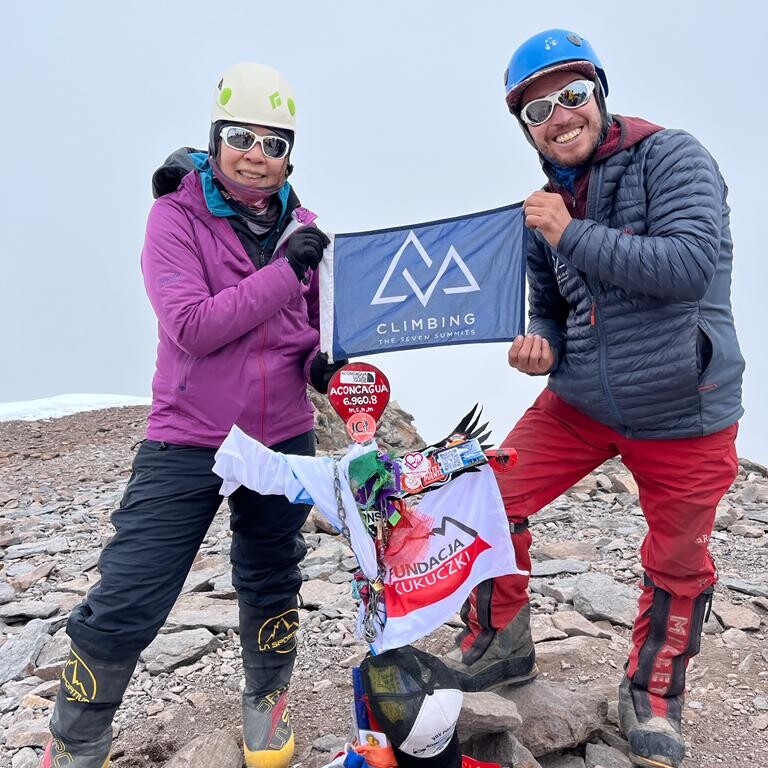
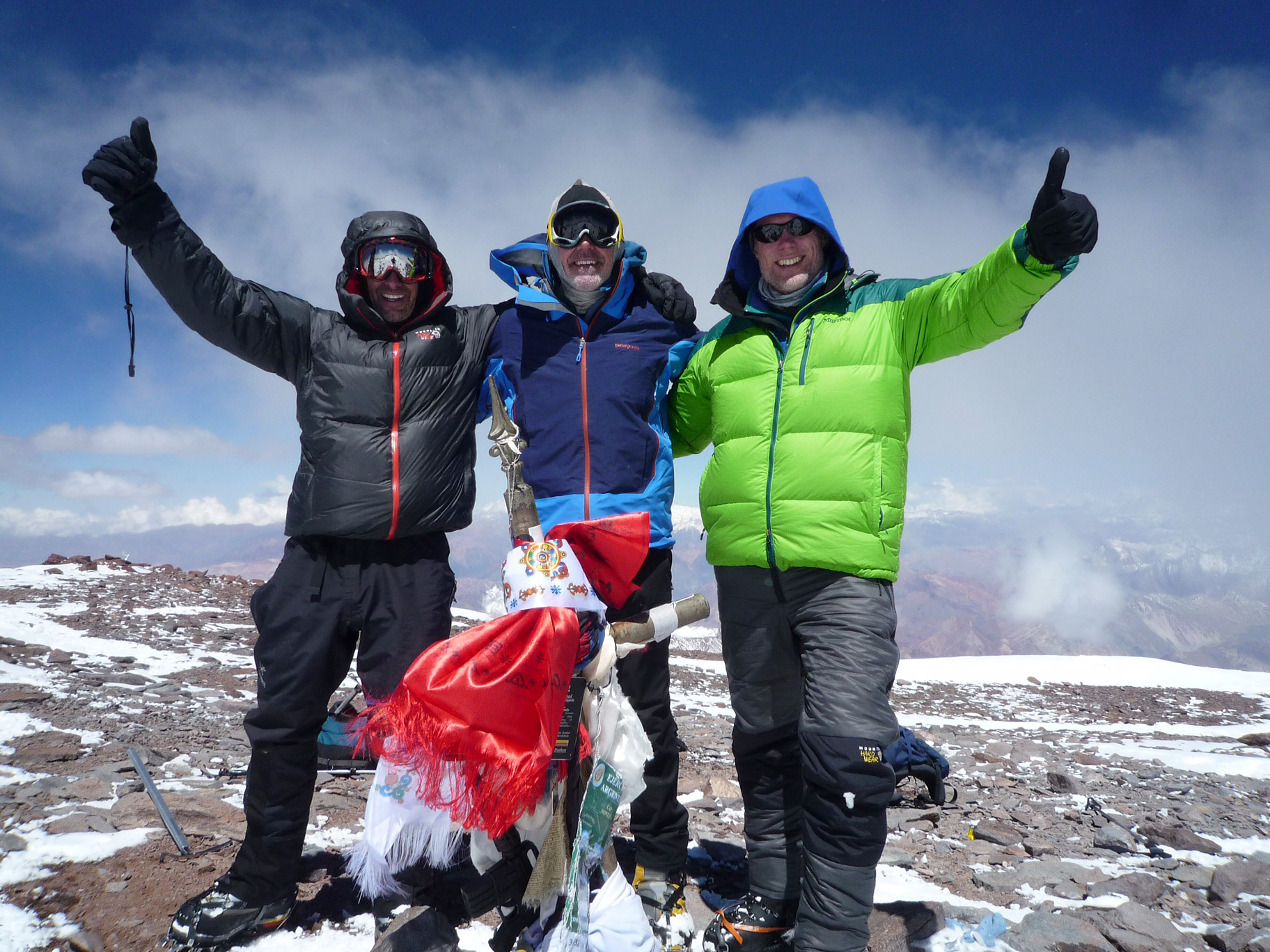
Expedition Highlights:
- Stand on the highest summit in the Southern and Western Hemispheres.
- Traverse the entire peak and see both sides of the mountain.
- Join our arrieros (mule drivers) while they cook the traditional meal “asado” (BBQ meats, veggies, bread, and, of course, Argentinian wine) over an open fire and under the stars.
- Watch the shadow of Aconcagua grow larger as the sun rises over the Andes on summit morning.
- Test yourself at altitude as critical preparation for Denali and Everest.
- Look down from the summit ridge on the mighty South Face, climbed by Reinhold Messner.
- Check out our Aconcagua Interactive Itinerary for more highlights
- Get the inside scoop of the Roof of the Americas on our Aconcagua Top Five blog post
Nothing found.
Choosing the Right Option
Our Aconcagua climbs are run annually from mid-December through the end of February to take advantage of the best weather, favorable summit conditions, and strong on-mountain infrastructure. It is a fantastic expedition which is highly adaptable to fit your style and timeframe.
Choose from our ever popular “Aconcagua 360 Classic” for a time tested climb schedule, upgrade to the “Executive” option for increased support or look at our “Speed Ascent” options if time is a critical factor.
Nothing found.
Porter Support Add-On
$2,150 USD
Many clients choose to use porters to facilitate their ascent of Aconcagua giving them a higher chance of success and making their climb much more enjoyable.
The trip price includes the cost of mules to transport the group’s gear into base camp, but not porters above base camp. Unlike on other mountains, porters on Aconcagua work for the on-mountain logistics companies rather than being attached directly to a particular expedition. If you would like a porter to assist in carrying your personal gear and share of the group gear, you may either hire them on an ad hoc basis during the climb or arrange their services in advance.
Please note, it is less expensive to hire porters on the mountain than to arrange them in advance. If hiring porters on an ad hoc basis, all payments must be made in cash with US dollars on the day of the service provided. Booking ahead of time guarantees availability and eliminates the need to carry this large amount of cash during the climb.
A standard porter load is 20kg and charged at a flat rate up to that maximum weight (i.e., if you only have 17kg, you will still be charged the 20kg rate). Additional weight will be charged at a pro-rated amount per kilogram. It is important to note that using a porter will still leave you with some gear to carry. However, your pack will be closed to 10-14kg rather than 20-25kg for each carry and move.
If you want to make your climb easier, or you simply want to enjoy the climb more, hiring porters may be the right decision.
Single Rooming Supplement
$1,250 USD
We are happy to organize single rooming accommodations in our hotels in Mendoza and Puente del Inca for you.
Having a single room helps climbers stay healthy and adds a bit of comfort and personal space that can go a long way on an expedition. If you would like a single rooming option, please let us know.
Please note that all tent accommodations are double-occupancy for weight, safety, and warmth.
Helicopter Exit - Plaza de Mulas to Horcones
Inquire for seasonal pricing
A helicopter exit from Plaza de Mulas to Horcones will save you the 18-mile hike back to the park entrance at the end of your climb. Because your date arriving into base camp can change and weather can prevent flights, helicopter exits will be scheduled upon your arrival, usually for later that same afternoon or the next morning. The helicopter operators accept only cash, in US dollars, on the mountain and require payment before departure from Plaza de Mulas. Pre-booking before your trip will help limit to amount of cash you need to carry throughout the expedition.
Will I be sharing a tent?
Yes, both at base camp and on the mountain. Tents are always shared on Aconcagua for safety at altitude, warmth, limited tent space on the mountain, and to reduce group gear weight for everyone. Please plan to share a tent with one of your fellow climbers and pack some earplugs!
How heavy will my pack be?
In general, climbing packs on Aconcagua are moderately to quite heavy. You will likely be carrying 45lbs – 55lbs (20kg – 25kg) most of the time while climbing on the mountain and less on the trek into base camp, during which we are supported by mules. On the trek in, you only need to carry what you need for the trek that day, which is generally only 15lbs (7kg).
If you are concerned about the heavy loads, please consider the option of hiring porters.
Will I need to purchase insurance?
Yes. Trip delay and cancellation, rescue, repatriation, and medical insurance are mandatory for this program for your own benefit. We have seen too many times people need to cancel their trip either before or during the expedition for reasons such as injury, health, family, or business matters. With such a long trip and so much at stake, climbers need to be prepared for contingencies.
The Aconcagua Provincial Park authorities also require each climber to carry insurance, which covers high-altitude activities, climbing, search and rescue, and evacuation. Please contact us if you need assistance finding an appropriate policy.
What is the food like on the climb?
In general, our food on and off the mountain is excellent. Mendoza is known for its food and wine. En route to base camp, we will be eating “asado,” traditional Argentinean BBQ over an open fire that the muleteers make for us (vegetarian options are available). At base camp, we have hired the services of first-rate chefs. On the mountain, your guides will be cooking large, hearty meals that are tasty, albeit a bit more rustic than in town. We can cater to most dietary requirements if given sufficient notice, so please let us know if you require accommodation.
What extra gear do I need for the traverse?
You will need light shoes that double as camp booties to bring up and over the mountain with you, and for the long hike out of base camp, the final day. Please also consider how you will carry your ‘day pack gear’ on the hike out. Many people use the top of their pack, which is usually detachable and can turn into a hip belt, which is ideal. If not, please bring an ultra-lightweight packable day pack.
How cold can it be on summit day?
Quite cold! Temperatures and weather on Aconcagua should not be underestimated. It would not be uncommon for summit day to include temperatures to –20F (-29C) or colder, including windchill. You may get lucky and have mild temps, but each climber needs to be equipped with solid cold-weather clothing.
Can I hire porters if I don’t buy the optional Porter Add-On?
Yes. Generally, we can hire porters for the next day via radio if we know by dinner the day before. If you haven’t prebooked porters, be sure to bring extra funds in US dollars to hire them on the spot. Porters will charge a flat rate for up to 20kg per carry. This is a good backup option for climbers who are getting over a stomach bug or aren’t feeling strong one day and need to conserve energy.
I heard that Aconcagua is like a bigger Kilimanjaro. Is that true?
Not really. While climbing Aconcagua doesn’t involve glaciers or technical climbing, it’s much more serious than a “taller Kilimanjaro.” The length of the expedition, the weight of your pack, extreme altitude, and self-sufficient expedition-style climbing combine to make Aconcagua a true big mountain experience.
How should I prepare for Aconcagua?
First, contact us! We love helping climbers achieve their dreams; that’s what we’re here for.
To prepare for Aconcagua, you should have already climbed a few mountains and be familiar with crampon and ice axe skills. Physical training is very important for success on Aconcagua. Start training at least 6 months before your expedition and focus on building endurance carrying a loaded pack up hill using trails or a Stairmaster.
Didn't find an answer to your question? Don't hesitate to ask us.
Aconcagua Reviews & Success Stories
"It's true, you can't buy the summit, but you can buy better odds. Our Aconcagua expedition was superbly put together, with great food, accommodation, and support. We had pizza, hamburgers, and chocolate on the side of a mountain! Josh, our lead guide, went above and beyond to make the experience as comfortable and enjoyable as possible. Our summit day was well planned ahead, and we were given the best chance of summiting amongst Aconcagua's crazy weather conditions. I wouldn't have made the top without CTSS."
- Tom D
"CTSS Lead Guide noted several times, "Jim looks like you're having the time of your life." I did, in fact, have the time of my recent life. Thanks for putting together what was a great experience."
- Jim A.

“Mike, a big thank you to you and the entire CTSS team for making our Aconcagua expedition a big success. We braved scorching sun, tent-ripping winds, bone-chilling cold, and a long summit day. However, we reached the summit and most importantly we all returned safe, proud and full of life.”
– CTSS Climber
“I have climbed with CTSS on my past three expeditions. Mt Elbrus in 2019 and Aconcagua in 2020 and 2022. I want the total experience on an expedition, from the travel, the country, the people, the culture, and meeting like minded individuals. CTSS gets this and that is why I would highly recommend them for your next expedition.“
– Blaine C
“I had the time of my life on Aconcagua. The trip was absolutely incredible, two weeks that I will treasure for the rest of my life. I have to say that Mike made the trip. He just inspires confidence and security. I knew that no matter what happened up there, he could fix it for us. I would climb anything with him.”
– Nikki M.
The Seven Summits Series: Aconcagua
Aconcagua is one mountain you don’t want to underestimate. Fierce weather, extreme altitude, heavy load carries, and a lengthy expedition timeline make the journey to South America’s tallest peak a serious undertaking for any mountaineer.
If you’re ready to learn what it takes to summit the highest mountain in the world outside of the Himalayas, check out our webinar and Q&A session hosted by CTSS Owner Mike Hamill and Senior Guide Nani Stahringer. During this webinar, Mike and Nani will share how you can physically and mentally prepare for Aconcagua so you can set yourself up for greater success on the mountain.
At CTSS, we believe your expedition starts long before you reach the mountain.
That’s why we provide every climber with holistic, personalized pre-expedition support, no matter the objective.
When you join a CTSS expedition, you become part of the family. You’ll be paired with a dedicated Expedition Manager and backed by our full team of experts, with guidance on everything from personalized strategy and progression planning to gear selection, training, travel logistics, and insider tips to help you get the most out of your climbing journey.
We’re here to make sure you show up prepared, confident, and ready to thrive on the mountain and beyond.
6x Reasons to Choose CTSS
Safety
Your safety and success are our top priorities, in that order. We make conservative decisions, plan redundancies, and all our guides have wilderness medical training, safety and rescue plans, and access to doctors around the clock to help keep you safe.
Value for $
We keep our overheads low to pass savings on to you. We are proud to offer the best service at the most competitive price, without compromising on safety or taking shortcuts in logistics, staffing, or infrastructure.
Holistic Approach
Our service goes far beyond the mountain. Think of us as your climbing coach; we'll be there from start to finish to prepare, debrief, and plan your progression as a mountaineer, whether your goal is a single summit or the Seven Summits.
Guides & Team
Guides can make or break your climb. We hand-pick the most qualified, tenured, tested, and personable guides and Sherpas in the world. Owner and mountaineer Mike Hamill personally oversees the logistics and management of each expedition.
Our Values
We care about you, our people, and the planet. A portion of every expedition goes to the Tiger of the Snows Fund, supporting outdoor tourism workers and their families. We follow strict Leave No Trace principles and live by our No D*ckheads Policy, because who you climb with matters.
Success
We have an unparalleled summit success rate. How? We do it in a myriad of ways; like a great chef's secret sauce, we've fine-tuned the recipe over decades. Most importantly, we believe in you & your ability to achieve your goals, and we are invested in putting you on top.
Aconcagua Inquiry Form
Ready to Progress?
Consider these expeditions
...Aconcagua Summits!...
Word just came back from our guides on Aconcagua - Summit Success today!
It was a long, hard summit day on the highest peak outside of the Himalayas, but in the end the summit was reached.
The team is now back down at high camp getting a well earned nights sleep. Tomorrow they'll make their way back down to basecamp for a well deserved afternoon at R and R.
Congratulations to our Summiters!
-CTSS Team
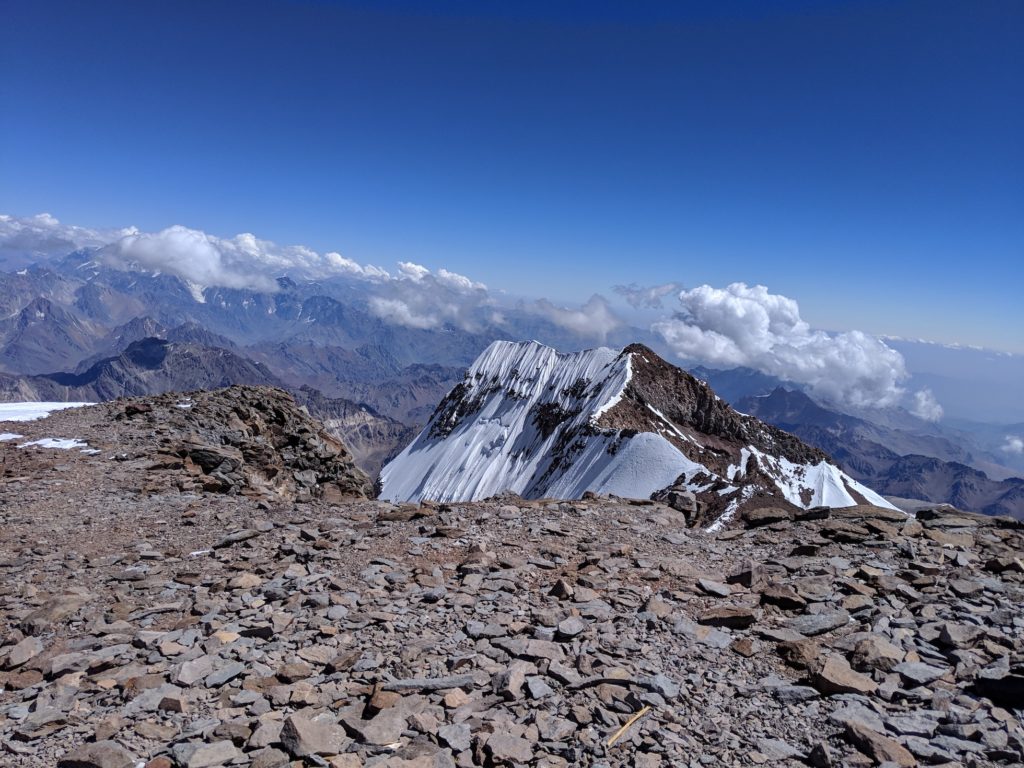
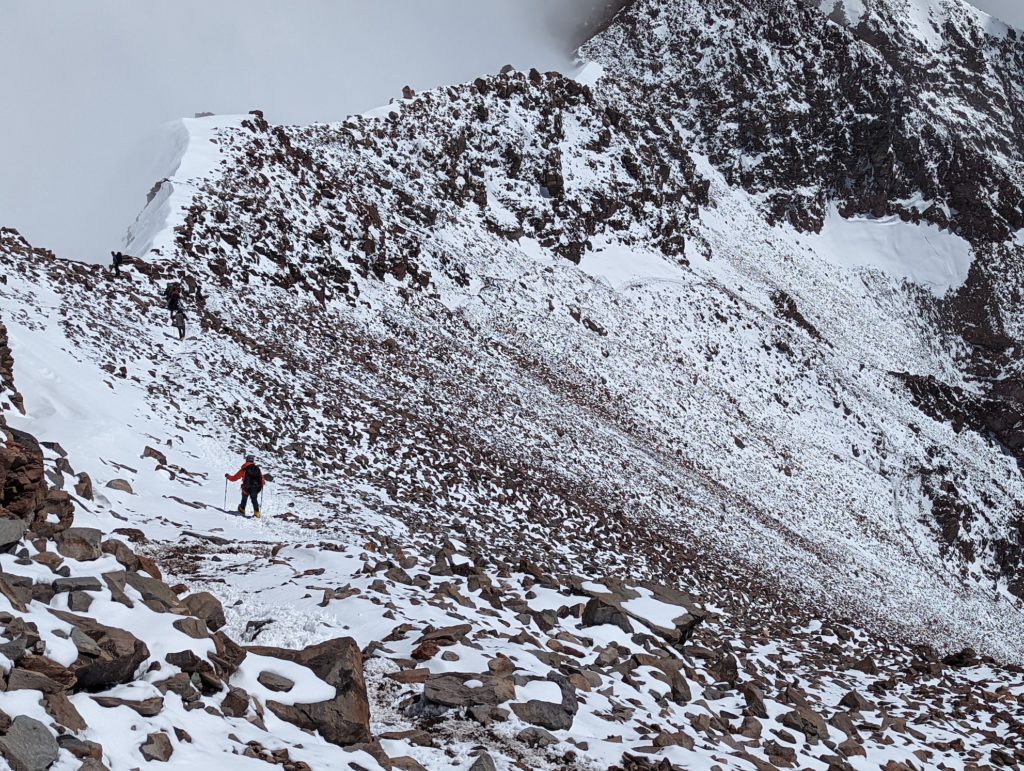
...Ecuador team Wraps up...
Our Ecuador team wrapped up their climbing today with a solid push on Chimborazo. The team made the difficult call to turn just above 6000m after putting in a solid 8 hour effort pushing their way through a tough route.
Tonight they've dropped down to the town of Baños, well known for it's hot springs and beautiful scenery. That is exactly what makes Ecuador such a special place to climb. In the morning you're pushing your limits climbing at 6000m, and by evening you can be relaxing in a tropical paradise.
Well done to all for a fantastic trip to the Ecuador Volcanoes!
-CTSS Team


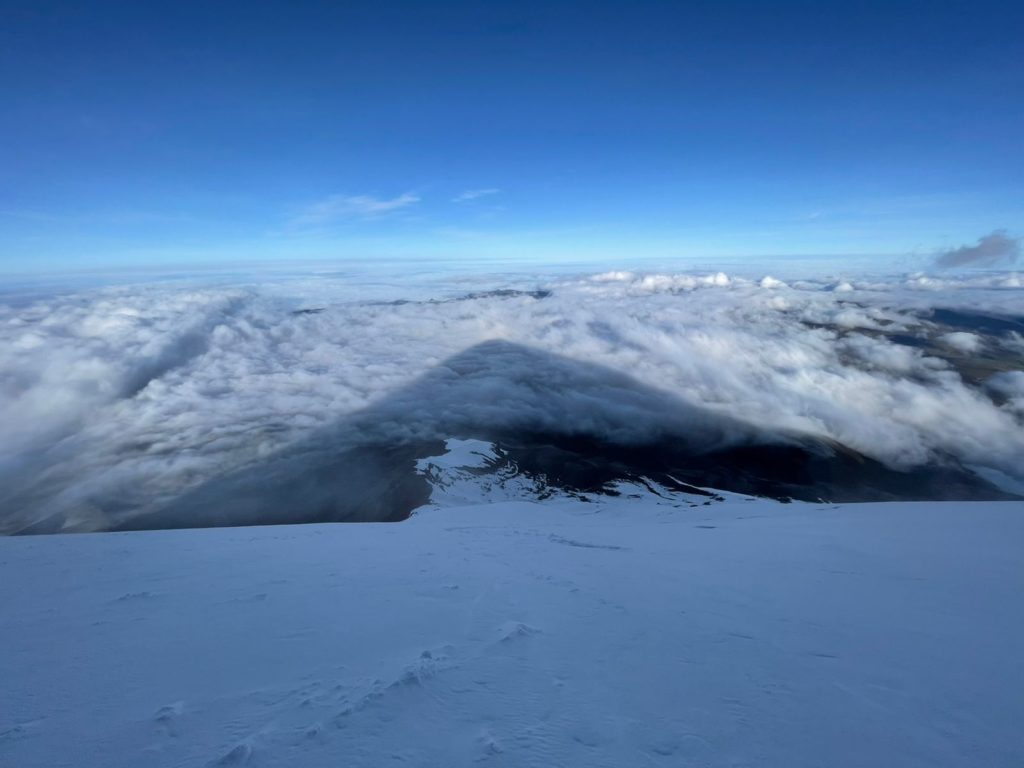
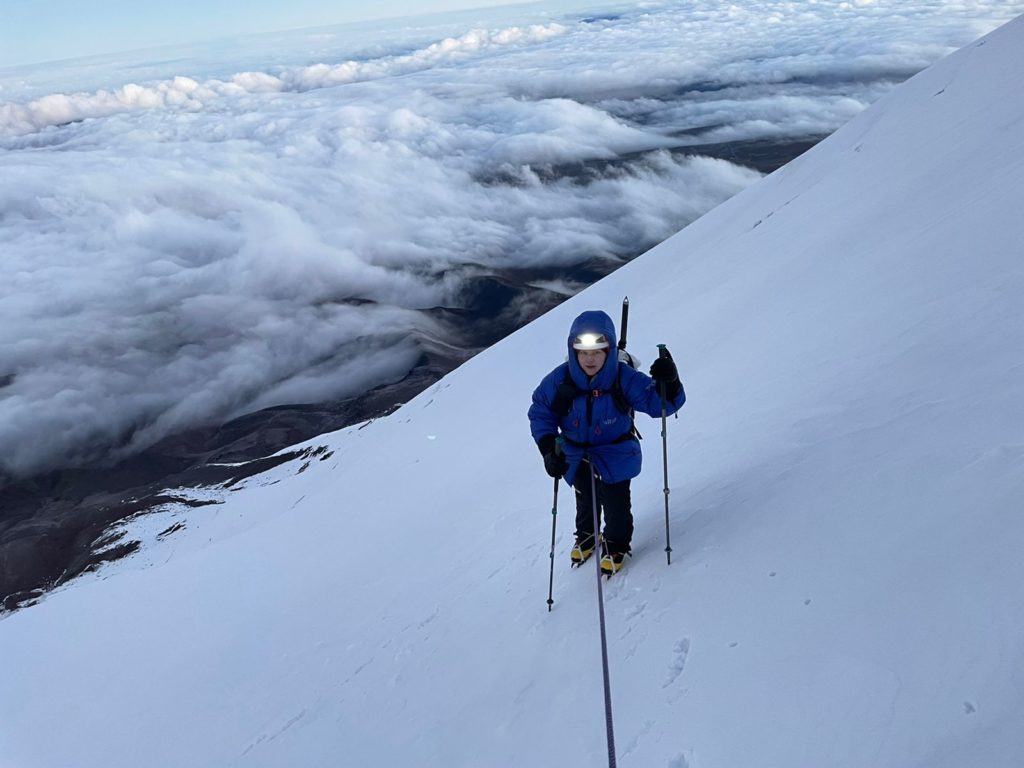
...Aconcagua Team Prepped for the Summit...
The check in today from Sasha and Nani was short and to the point:
"Got to Colera (camp 3). Everyone feels good. Weather is good. Will start at 4:00 AM"
They're ready! The team has spent a week working their way up from basecamp acclimatizing and putting gear in place for the summit bid. Tonight it will all come together as they make the final push from Camp 3 at 19,700 feet (6,000m) to the summit at 22,837 feet (6,961m).
Best of luck to the team as they climb tonight!
-CTSS Team

...Cayambe and Hot Springs...
The Ecuador team has made it back to Quito after a great few days in the mountains. Early Sunday morning they set off for the Summit of Cayambe, but unfortunately weather moved in and the summit wasn't in the cards that day. Still, the team put in a super effort, pushed as high on the mountain as possible, and made a great call to come down when the conditions began to deteriorate.
After their attempt on Cayambe it was off to the hot springs at Papallacta! A fantastic reward after over a week of acclimatizing and pushing hard in the mountains.
Tomorrow our team members on the normal itinerary will fly home, while those going for the Chimborazo extension will head south out of Quito and climb to high camp on Chimbo tomorrow afternoon.
Nice work all around!
-CTSS Team
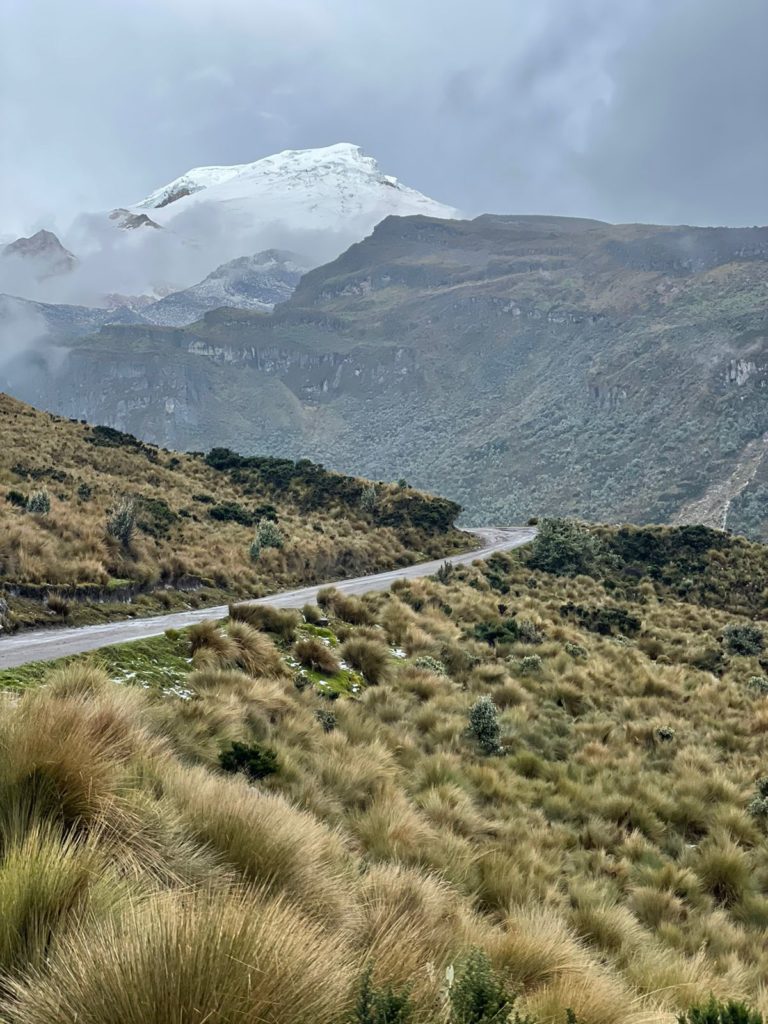
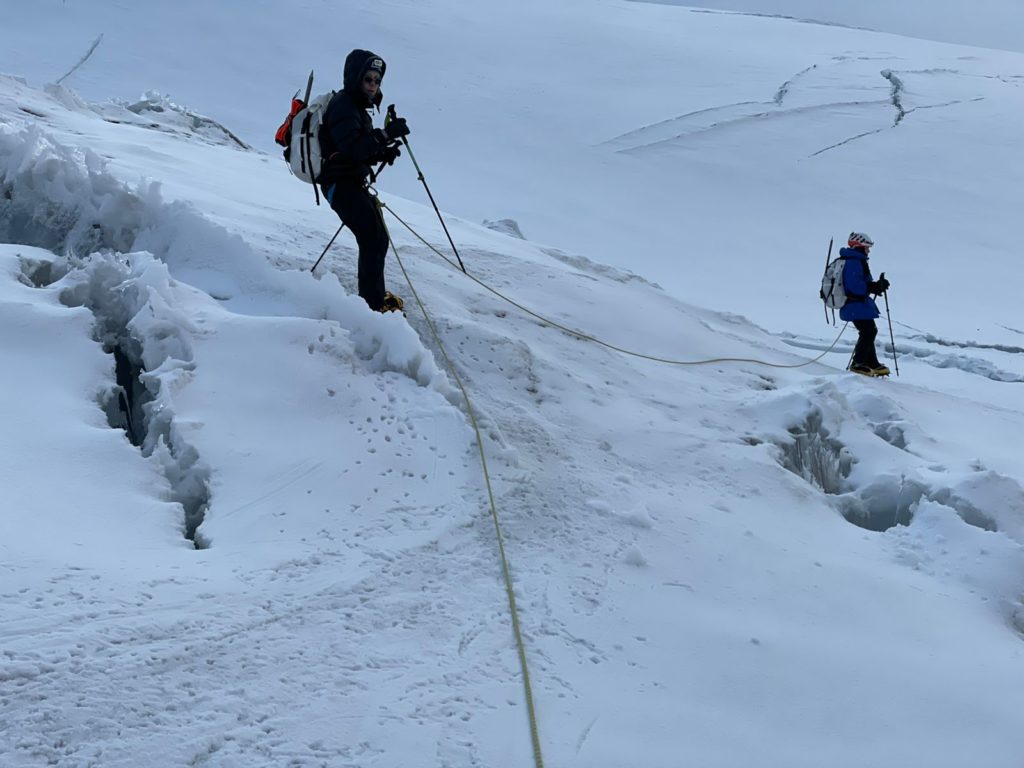
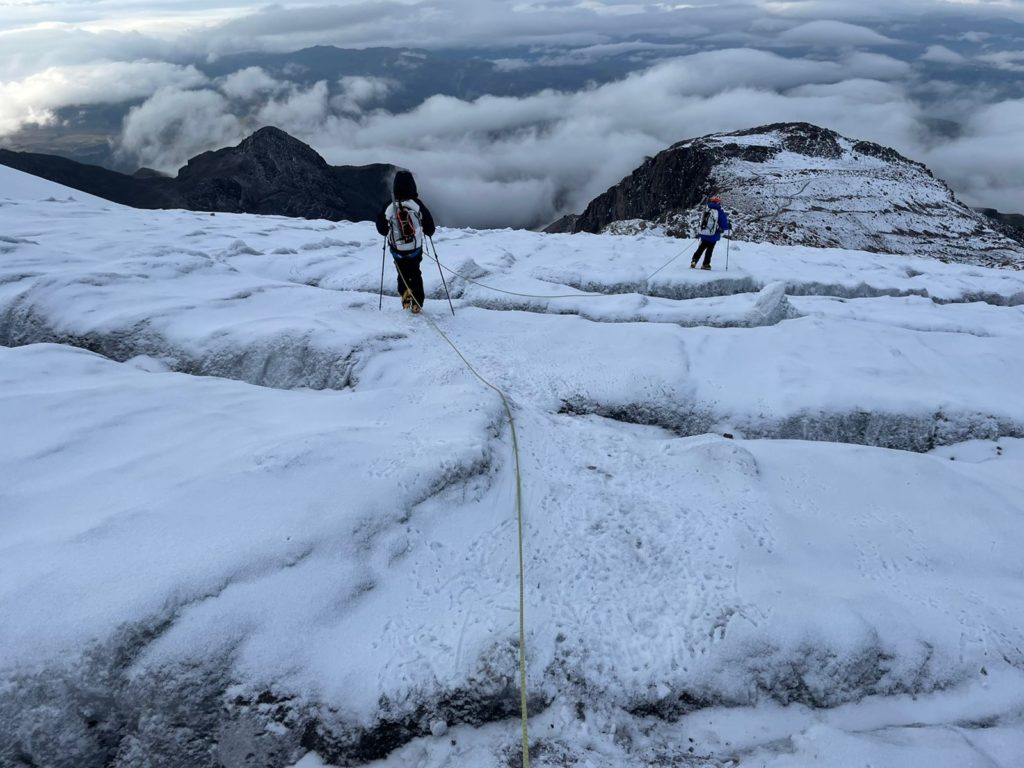
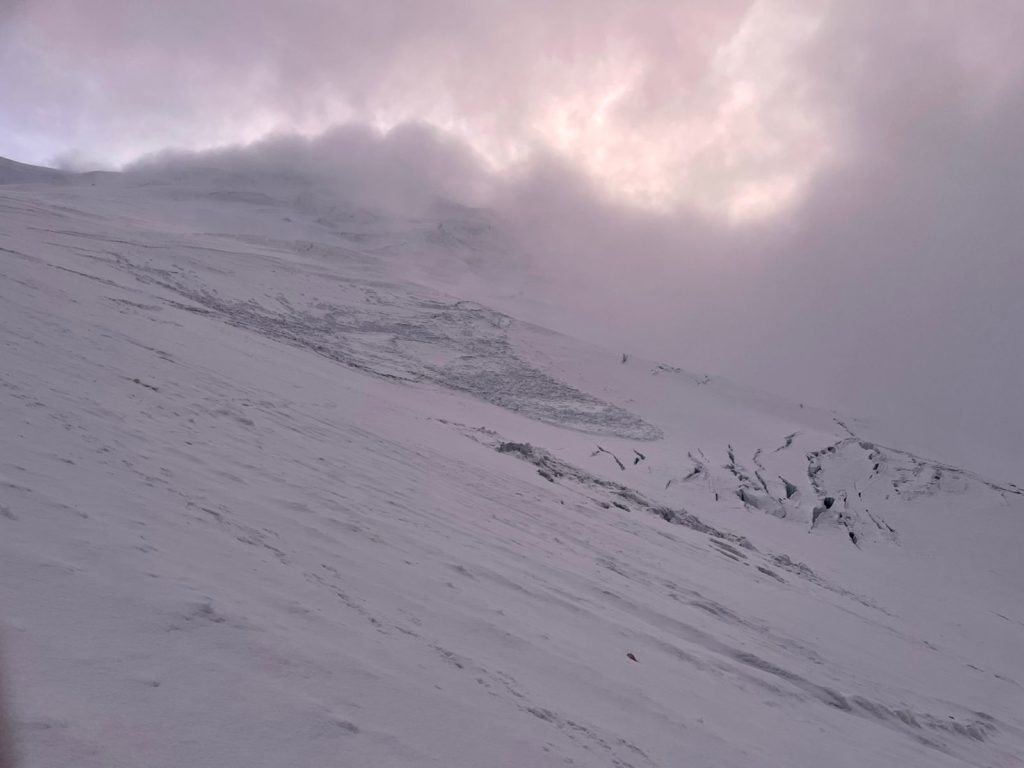
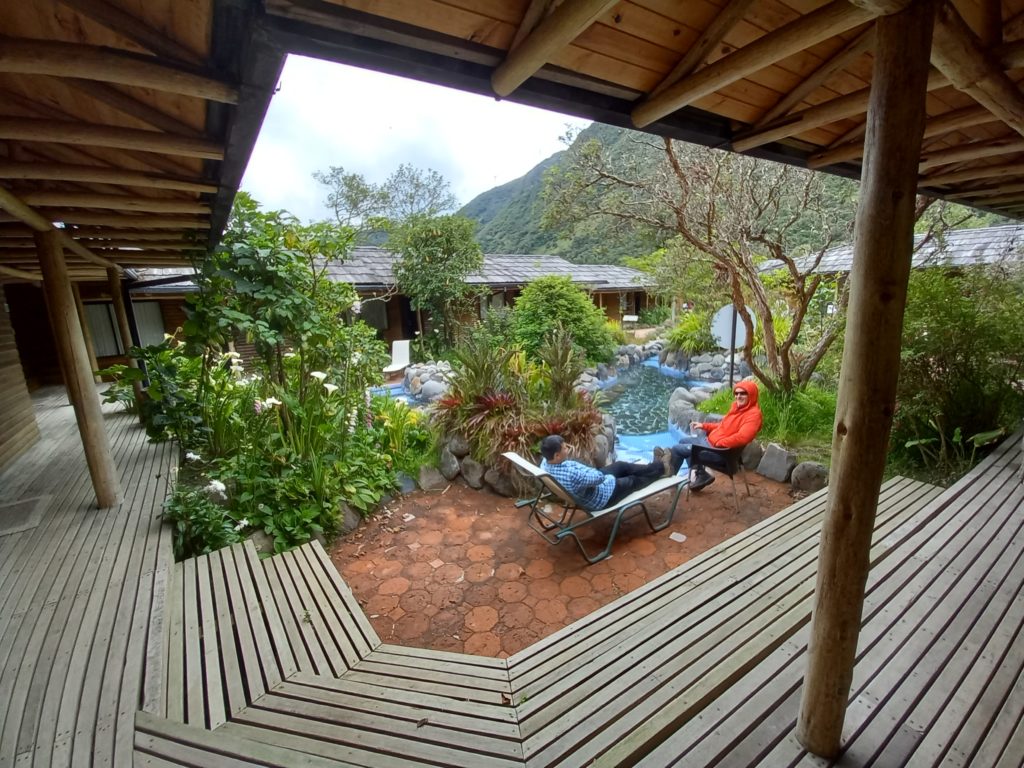
...Aconcagua Team at Camp 2...
CTSS Lead Guide Sasha Sak called in via Sat phone with an update. The team moved into Camp 2 at 18,100 feet this afternoon and are feeling great! The guides are staying on top of the weather and have a game plan put together for their summit strategy.
Tomorrow the team will carry to Camp 3 in the morning and descend back to Camp 2 by early afternoon to rest the remainder of the day. On the 9th the current plan is to move to Camp 3, with February 10th as the target summit day. Guides Sasha and Nanika will keep an eye on the weather and adjust if needed, but for now the 10th is the target!
Good luck to the team as they wrap up the hard work of moving into position and switch focus to the summit climb.
-CTSS Team

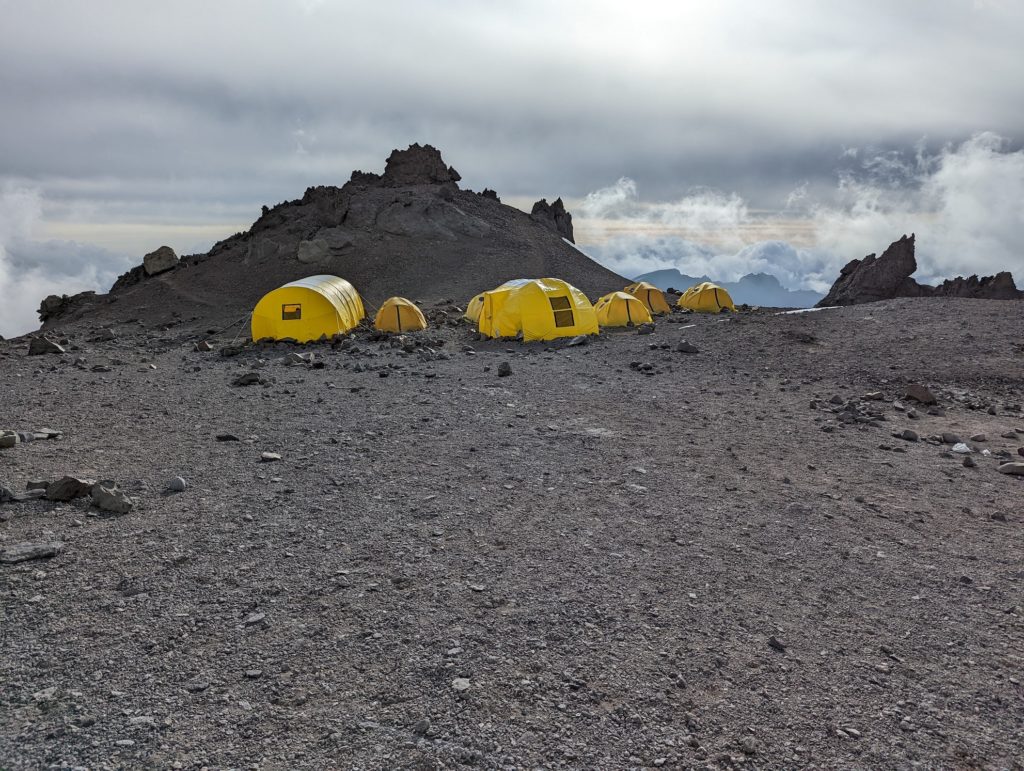

... Ecuador: 100% Success on Cotopaxi...
The CTSS Ecuador team is celebrating a very successful climb of Cotopaxi, 100% of the team reached the summit early this morning.
Congratulations!!!
Cotopaxi is a tough climb, especially considering you're climbing to above 19,000 feet after being in at altitude for less than a week.
Tonight they're taking a well earned rest in the historical La Cienega hotel - one of the oldest buildings in the region. Tomorrow they'll drive to Cayambe for a rest day and begin focusing on their next objective.
-CTSS Team
